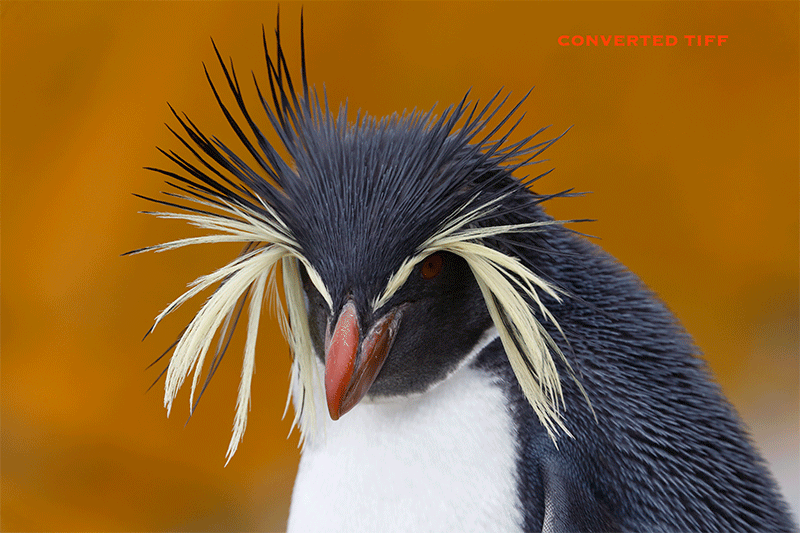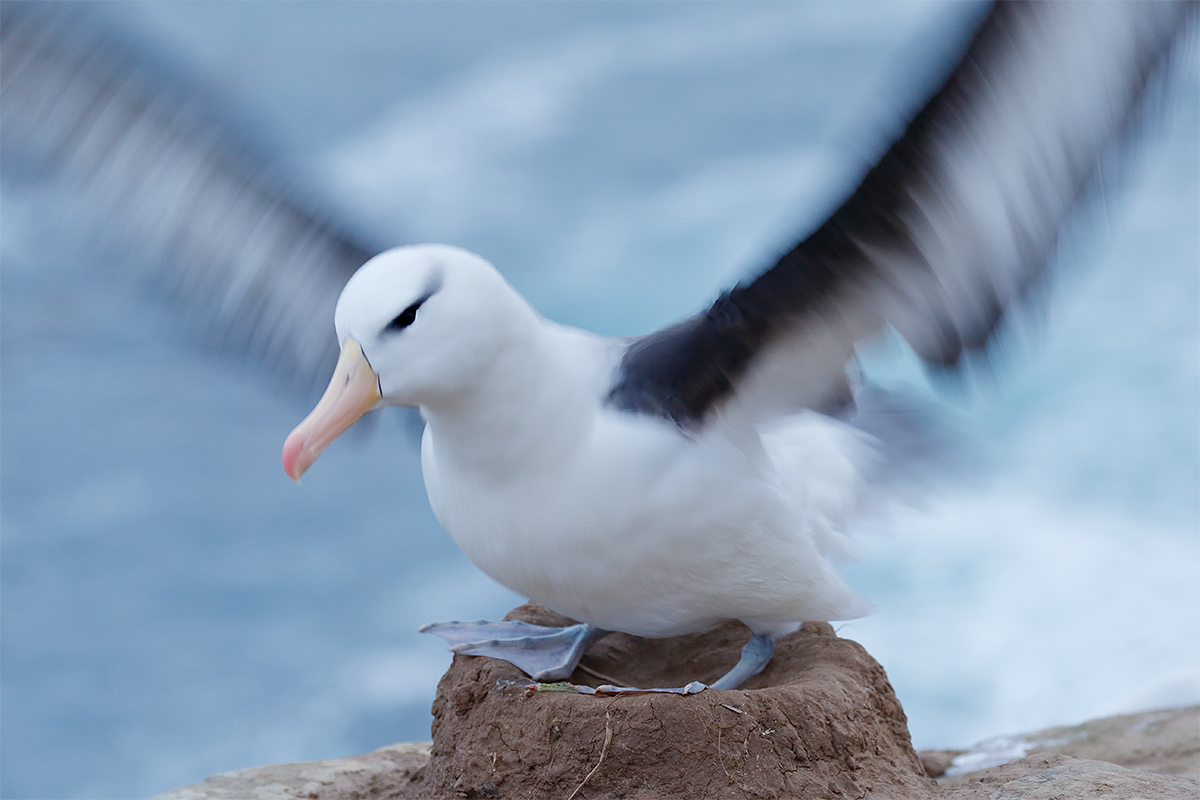November 29th, 2015 What’s Up?
I began wrapping this one up at 6:33pm on Saturday November 28, 2015. Denise Ippolito and I met our second IPT group and cancelled the meet and greet so that we could head right down to the refuge as things looked promising. We were rewarded with farm field blast off after farm field blast off. Finally. How sweet.
We have our introductory slide program at 7pm tonight so I need to get packing. I will finish this post either tonight or early tomorrow. BTW, I am feeling better each day (though still congested).
|
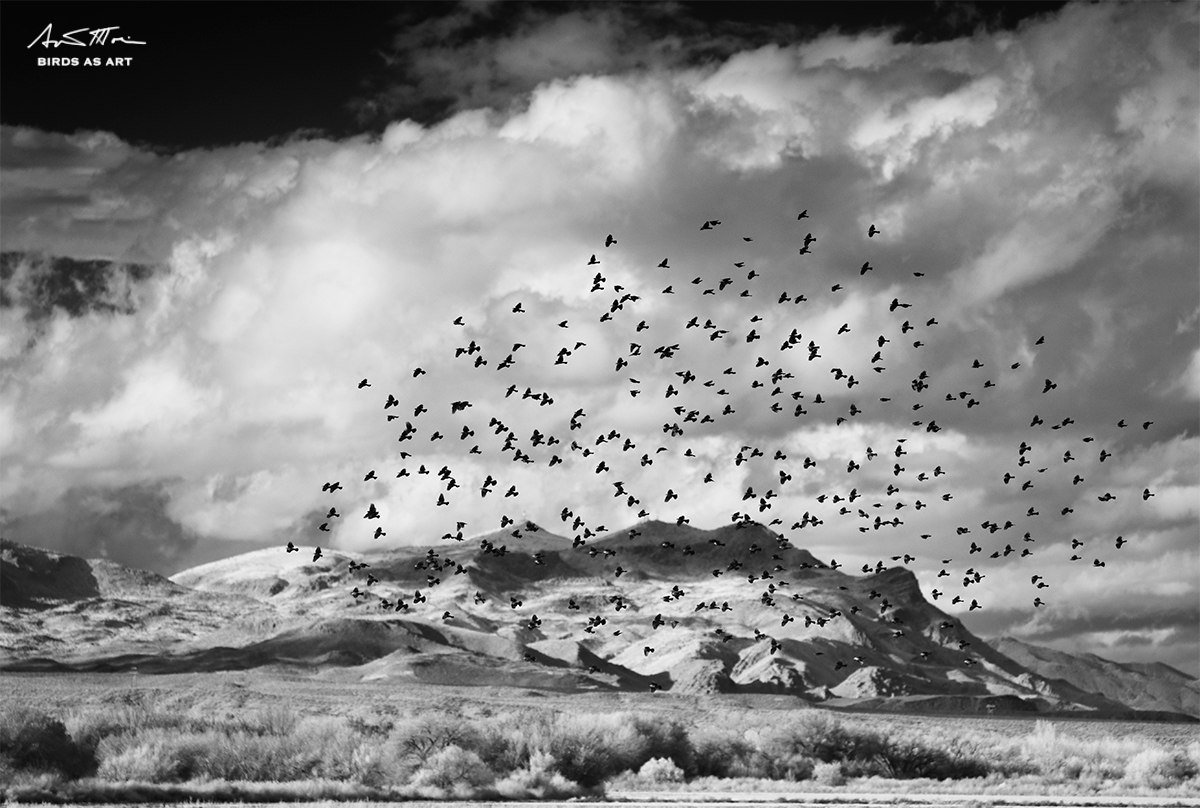
|
|
This image was on Thanksgiving Day at Bosque with the hand held Canon EF 100-400mm f/4.5-5.6L IS II USM lens (at 278mm) and my Kolari Vision-converted EOS-5D Mark II (now effectively replaced by the Canon EOS 5D Mark III.) ISO 800. Evaluative metering +2 stops: 1/800 sec. at f/5.6. Custom WB.
All 9 AF points/AI Servo/Shutter Button AF was active at the moment of exposure (as is always best when hand holding). Click on the image to see a larger version.
Red-winged Blackbird flock in front of mountains/IR > B&W
|
Why IR in this Situation?
Sun angle was down the road to the east. The wind was pretty good, from the southwest, and the cranes were coming in and landing nicely, but almost 90 degrees off sun angle. That all sounds pretty bad but the sky was filled with big, beautiful clouds. Bright sidelight and big clouds all scream IR. So IR it was. At first I tried for groups of cranes on the ground and in the clouds, but then a foraging flock of blackbirds–almost all young and female redwings, appeared so I concentrated on them.
The Image Processing
After converting the RAW file in DPP I brought it into Photoshop, made a new layer, and brought that layer into NIK Silver Efex Pro. I experimented with the various presets and wound up liking Grad ND (EV-1) best.
Kolari Vision BAA Discount
Get your camera converted to IR and enjoy a $10 discount by entering the code morris2015 in the Coupon code box at checkout. Then hit Apply Coupon and Update Cart. You will need to scroll down to see that your discount has been applied.
Note: denise and I share the small affiliate fee that we receive when you use our Kolari link.

Kolari Visions Infrared Camera Conversions
If you are ready to join the fun and have a camera converted to Infrared, use either the Kolari Vision logo-link above to order your conversion we will gladly send you our simple guide to properly setting a Custom White Balance for infrared photography at 720nm. Simply e-mail us your receipt and we will be glad to shoot you the PDF once your order appears in our affiliate account.
Kolari Visions prides themselves on their fast turnaround times and excellent customer service; they are getting better and faster as they employ several full time technicians to service everything as quickly as possible. The filters they use have been specifically designed for each camera and filter combination to be the optimal thickness for best autofocus performance between lenses, and the best corner sharpness. The filters also fit directly into the frame making the conversion non-damaging and reversible if needed. Others uses a few standard-sized thick filters that they calibrate the camera around. Doing this reaches accurate autofocus with their test lens. But when a filter is too thick for what the optics were designed for, the sharpness can suffer, particularly in the corners, and other lenses will not consistently focus accurately. Some other IR converters glue their filters directly to the sensor; that makes it almost impossible to revert back or to change the filter.
Kolari offers a comprehensive shop for infrared bodies; customers can order converted cameras directly from KV. Their focus on optical quality built from the ground up has allowed them to recently offer a service that improves the performance of Sony A7 series cameras to the level of the Leica M240 cameras. Content-wise, Kolari has a very comprehensive article list and an exhaustive lens performance database chock full of technical details. Soon, KV will feature an interactive gallery that will showcase different camera/filter picture combinations to get rid of some of the mystery of picking a camera to convert.
Choosing a Filter
Filter Choices
The text below is cut and pasted from an informative Kolari Visions’ article. You can access the complete photo illustrated tutorial by clicking here.
We currently have 6 filters to pick from. We offer the 720nm standard infrared, the 850nm deep infrared, the 665nm extra color infrared, the 590nm infrared, a full spectrum filter, and a two spectrum filter. All filters are the same price.
The Standard IR Filter (720nm) allows for good false color, and good contrast for black and white. This is equivalent to the Hoya R72 and the Wratten 89b.
The Ultra Color filter (590nm) lets more visible light in. It produces the most vibrant colors: leaves are golden yellow, skies are bright blue.
The Enhanced Color filter (665nm) has an effect between the 720nm and 590nm, producing more vibrant colors than the 720nm for pale yellow leaves and soft blue skies.
The Deep Black and White filter (850nm) is good for a dedicated black and white IR. The camera will produce images with bright whites and pronounced blacks. It is Equivalent to the Wratten 87c.
As above, after some serious thinking I converted my camera at 720nm. We did get a chance to experiment with Catherine Costolo’s super-color IR camera and had great fun. I will share an image or two made with her camera here with you at some point.
Costs
Kolari Vision offers economical IR conversions and did a great job with my camera.
Denise’s Infrared Gallery
If you are developing an interest in Infrared photography be sure to check out denise’s Infrared gallery here. See if you can figure out how she created the Milwaukee Road image. We would be glad to try to answer any basic IR questions that you have via e-mail as follows: artie or denise.
|
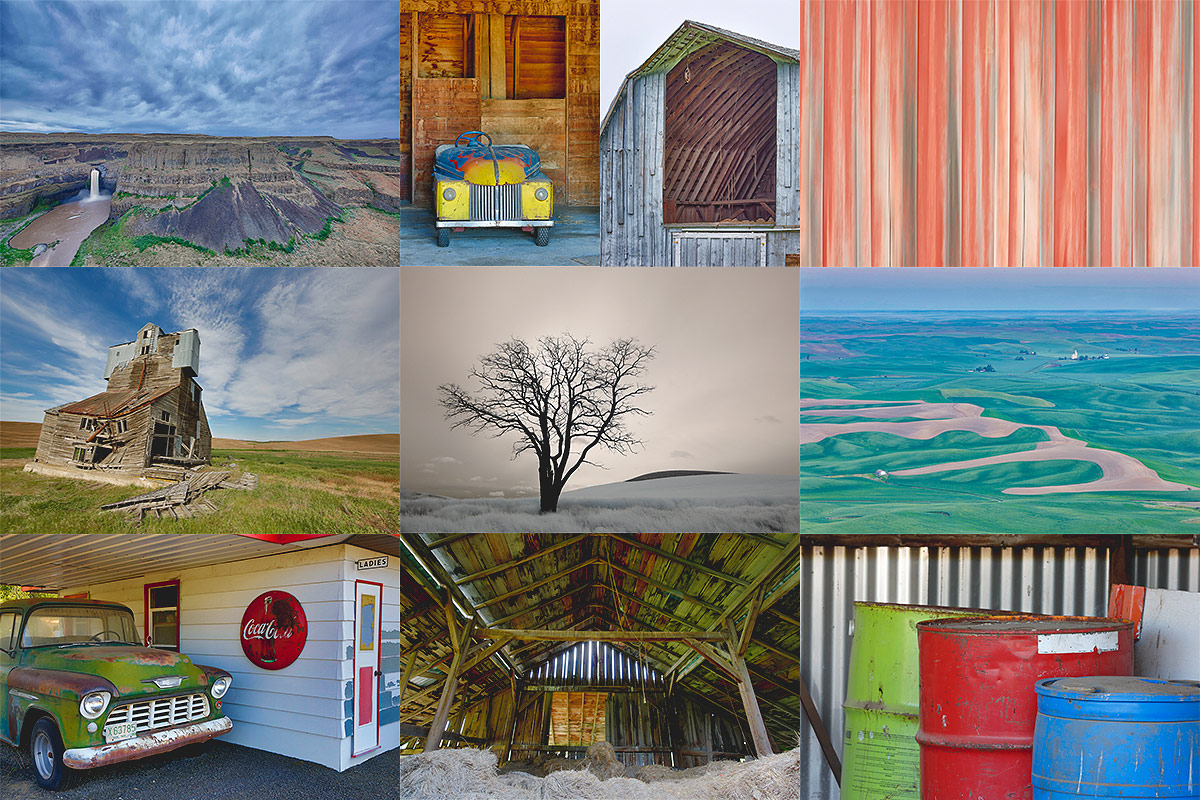
|
|
Subject and focal lengths from upper left to right and then around to center.
Palouse Falls: 11mm; homemade kiddie race car: 105mm; barn siding pan blur: 798mm; Rolling fields diorama: 110mm; Crayola drums: 343 mm; Hay barn interior: 19mm; vintage gas station: 40mm; Dilapidated farm building: 13mm; Denise’s tree Infrared: 20mm.
Images and card design by Arthur Morris/BIRDS AS ART.
|
The Palouse ~ A Creative Adventure/BIRDS AS ART Instructional Photo-Tour (IPT)/Eastern Washington State. June 3-7, 2016/5 Full Days: $1699/Limit 12
The Palouse ~ A Creative Adventure/BIRDS AS ART Instructional Photo-Tour (IPT)/Eastern Washington State. June 10-14, 2016/5 Full Days: $1699/Limit 12
Double Header!
Maximize both your travel dollars and your learning experience by signing up for both IPTs.
|
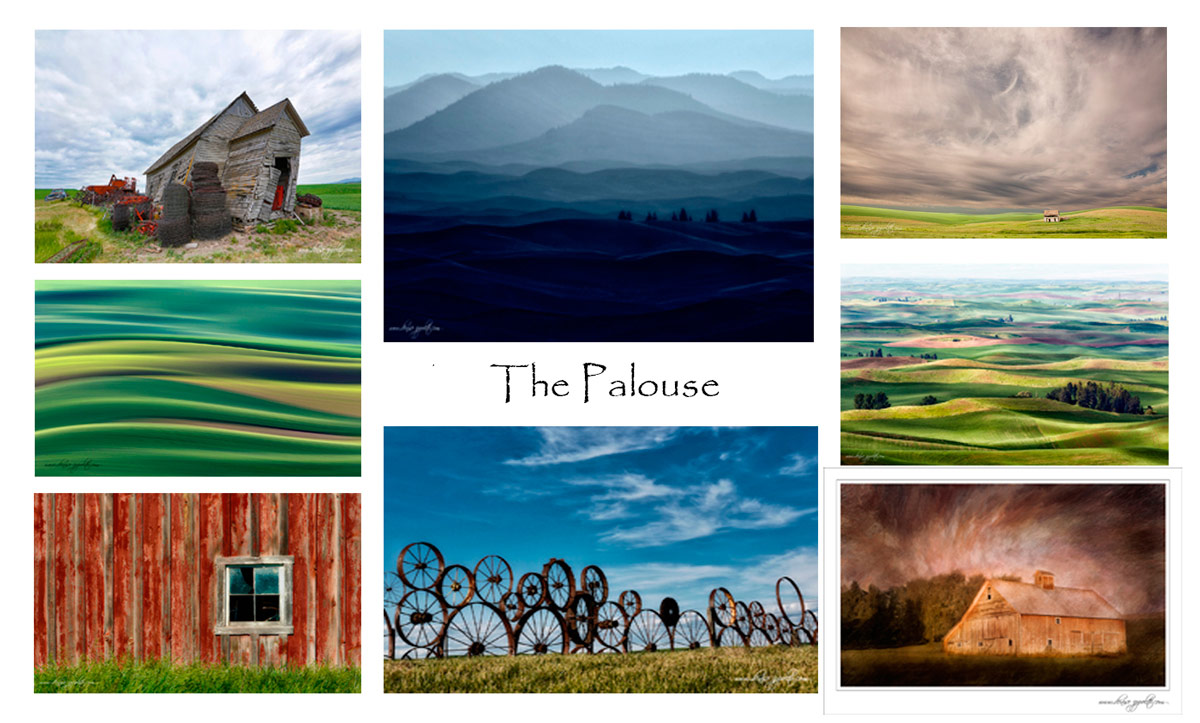
|
|
Images and card design by Denise Ippolito/A Creative Adventure.
|
The Palouse IPTs
Rolling farmlands provide a magical patchwork of textures and colors, especially when viewed from the top of Steptoe Butte where we will likely enjoy spectacular sunrises and possibly a nice sunset. We will photograph grand landscapes and mini-scenics of the rolling hills and farm fields. We will take you to some really neat old abandoned barns and farmhouses in idyllic settings. There is no better way to improve your compositional and image design skills and to develop your creativity than to join us for this trip. Two great leaders: Denise Ippolito and Arthur Morris. Photoshop and image sharing sessions when we have the time and energy…. We get up early and stay out late and the days are long.
After 6 days of back-breaking scouting work in early June 2014 we found all of the iconic locations and, in addition, lots of spectacular new old barns and breath-taking landforms and views. On three additional scouting days in 2015 we discovered several more truly amazing locations. We will teach you what makes one situation prime and another seemingly similar one a waste of your time.
What’s included: In-the-field instruction, guidance, lessons, and inspiration, our newfound but very extensive knowledge of the area, all lunches, motel lobby grab and go breakfasts, and Photoshop and image sharing sessions when possible. There will be a meet and greet at 7:30pm on the evening before each workshop begins.
You will learn and hone both basic and advanced compositional and image design skills. You will learn to get the right exposure every time. You will learn to develop your creative eye. You will learn the basics of HDR (high dynamic range) photography. You will learn a variety of in-camera creative techniques. Most importantly you will learn to see the situation and to create a variety of top-notch images. Do see both of our blogs for lots more on that in the coming weeks. You will learn how the quality and direction of light combine to determine the success of your images. And–please don’t gasp–we will be working quite a bit with sidelight when creating landscapes. Lastly, we will be doing some infrared photography.
To Sign Up
A non-refundable $699 deposit is due now. The balance will be due on February 15, 2016. If we do not receive your check for the balance on or before the due date we will try to fill your spot from the waiting list. Whether or not your spot is filled, you will lose your deposit. If not, you can secure your spot by paying your balance.
With the spectacular success that we enjoyed in 2015 it seems quite likely that this one will fill up very quickly. Please let me know via e-mail that you will be joining us. Then you can either call Jim or Jennifer at 863-692-0906 during business hours or send us a check to leave a deposit; the latter is preferred. If by check, please make out to “Arthur Morris” and mail it to: Arthur Morris/BIRDS AS ART, PO Box 7245, Indian Lake Estates, FL, 33855. If you have any questions, please feel free to contact us via e-mail: artie or denise.
Travel Insurance Services offers a variety of plans and options. Included with the Elite Option or available as an upgrade to the Basic & Plus Options. You can also purchase Cancel for Any Reason Coverage that expands the list of reasons for your canceling to include things such as sudden work or family obligation and even a simple change of mind. You can learn more here: Travel Insurance Services. Do note that many plans require that you purchase your travel insurance within 14 days of our cashing your deposit check. Whenever purchasing travel insurance be sure to read the fine print carefully even when dealing with reputable firms like TSI.
Facebook
Be sure to like and follow BAA on Facebook by clicking on the logo link upper right. Tanks a stack!
Support the BAA Blog. Support the BAA Bulletins: Shop B&H here!
We want and need to keep providing you with the latest free information, photography and Photoshop lessons, and all manner of related information. Show your appreciation by making your purchases immediately after clicking on any of our B&H or Amazon Affiliate links in this blog post. Remember, B&H ain’t just photography!
…..
Amazon.com
Those who prefer to support BAA by shopping with Amazon may use this link:
Amazon Canada
Many kind folks from north of the border, eh, have e-mailed stating that they would love to help us out by using one of our affiliate links but that living in Canada and doing so presents numerous problems. Now, they can help us out by using our Amazon Canada affiliate link by starting their searches by clicking here. Many thanks to those who have written.
Typos
In all blog posts and Bulletins, feel free to e-mail or to leave a comment regarding any typos or errors. Just be right :).
November 28th, 2015 What’s Up?
Other than a few minutes of bumps due to some rough air going in and out of Denver last week, my flights to ABQ on the 20th were long, exhausting, and thankfully un-eventful. I began working on this blog post during my layover in Denver and finished it in Socorro a week later, on the afternoon of the day after Thanksgiving.
Please Remember to shop the BAA Online Store, and to use our Affiliate Links 🙂
To show your appreciation for my continuing efforts here, we ask, as always, that you use our the B&H and Amazon affiliate links on the right side of the blog for all of your purchases. B&H is recommended for you major photography gear purchases, Amazon for your household, entertainment, and general purpose stuff. Please check the availability of all photographic accessories in the BIRDS AS ART Online Store, especially the Mongoose M3.6 tripod heads, Gitzo tripods, Wimberley heads and plates, LensCoats and accessories, and the like. We sell only what I have used, have tested, and can depend on. We will not sell you junk. We know what you need to make creating great images easy and fun. And we are always glad to answer your gear questions via e-mail. I just learned that my account was suspended during my absence; it should be up and running by Monday at the latest.
I would of course appreciate your using our B&H affiliate links for all of your major gear, video, and electronic purchases. For the photographic stuff mentioned in the paragraph above we, meaning BAA, would of course greatly appreciate your business. Here is a huge thank you to the many who have been using our links on a regular basis and visiting the BAA Online store as well.
|
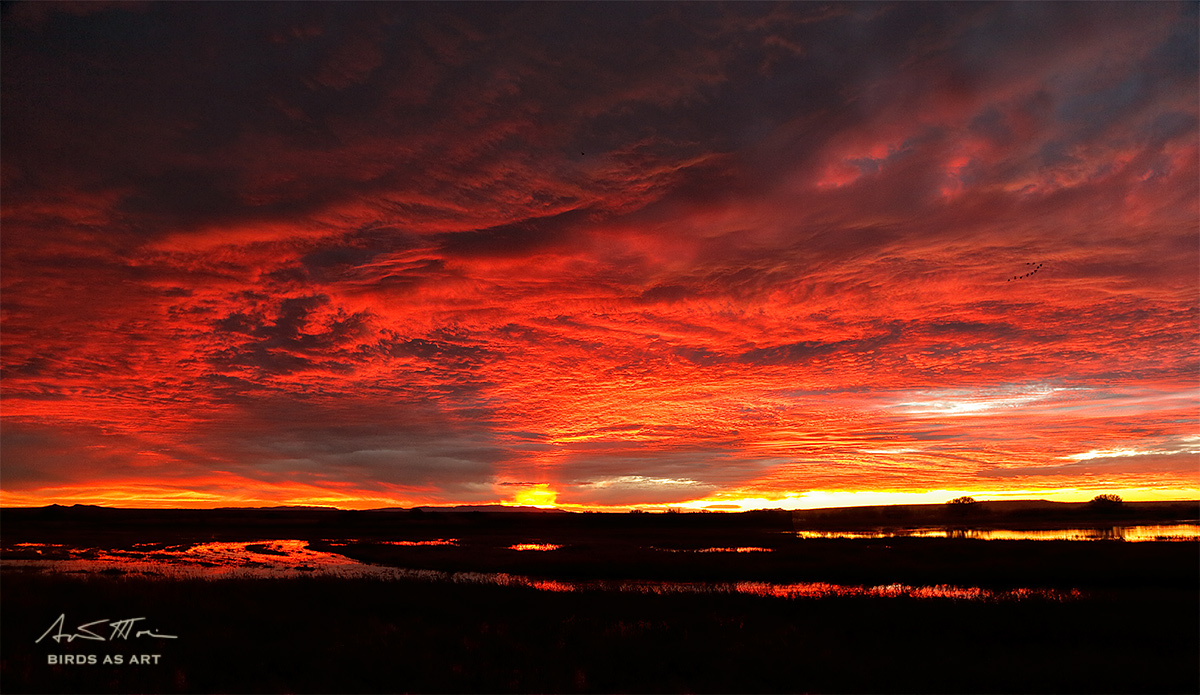
|
|
This image was created at Bosque del Apache NWR with the hand held Canon EF 24-105mm f/4L IS USM lens (at 24mm) and the rugged Canon EOS-1D X. ISO 800. Evaluative metering -1/3 stop: 1/60 sec. at f/4 in Tv Mode. Color temperature: 8100K.
Center AF point (Manual selection)AI Servo/Rear Focus AF on the distant horizon and re-compose. My left elbow was resting on the deck railing for support. Click here to see the latest version of the Rear Focus Tutorial. Click on the image to see a larger version.
Image #1: Spectacular sunrise without geese…
|
More than anyplace on the planet…
Bosque is like a good golf course. To do your best, you have to use all the clubs in your bag. I always bring a ton of gear to the refuge and I surely broke all records this year. More than anyplace on the planet you can make great images with lenses of any focal length. Today’s opening image is the wide version of yesterday’s “Mega-nuclear Sunrise.” If you missed that one, click here.
Exposure Question
Why did the image above need -1/3 stop EC while yesterday’s tighter shot was perfect at +1/3 stop?
Bosque Gear Bag
Once I decided to ship the 600 II and the 200-400 w/Internal 1.4X Extender to the IPT hotel via UPS Ground, the only choice I had to make was whether to bring the 100-400 II or the 70-200 f/2.8 L IS II that had served me well here for so many years…. Read on. I’d be glad to answer an Bosque gear questions that you have.
Canon EF 600mm f/4L IS II USM Lens The 600mm focal length lenses are perfect for photographing single cranes in flight in many situations and, with the addition of a 1.4X tele-converter, often perfect for photographing single geese in flight. I can increase versatility and focal length coverage by choosing either the 1D X or the 7D II according to the situation.
I learned recently that the latest version of the Nikon 600, the Nikon AF-S NIKKOR 600mm f/4E FL ED VR lens, (8.4 pounds) is actually (and finally) a bit lighter than the Canon 600 II (8.65 pounds). The last two versions of the Nikon 600s were absurdly heavy; in this age of “lighter and smaller” serious Nikon bird photographers should be thrilled.
Canon EF 200-400mm f/4L IS USM Lens with Internal 1.4x Extender. I have brought this great lens with me to Bosque ever since I got my hands on one several years ago. With its focal length range of from 200-560 (the latter available in an instant by engaging the internal TC), it is my absolute favorite for the pre-dawn geese fly-ins and fly outs.
Canon EF 100-400mm f/4.5-5.6L IS II USM lens. This versatile lens will be on my shoulder every time I get out of the car with either a full frame body or the 1.6 crop factor 7D II via a Black Rapid RS-7 strap. I finally remembered to bring a second RS-7 strap to Bosque so that I will have one less rig lying in the dirt at the farm fields and elsewhere. The 100-400 focal length fits nicely with the 600II and will be a perfect blast off lens.
Gear Question #1
What is the single huge advantage that the 200-400 f/4L IS lens w/internal extender (7.98 lbs) has over the 100-400II (3.5 lbs) for the pre-dawn fly-ins and blast offs?
Gear Question #2
For those who will be using the 100-400II as their daytime blast-off blur lens why is the smaller aperture (f/5.6 at 400mm) a non-factor as compared to the larger f/4 aperture of the the 200-400 f/4L IS lens w/internal extender?
Canon EF 70-200mm f/2.8L IS II USM lens I am sure that I might miss this intermediate telephoto zoom lens on occasion, especially when creating bird-scapes in low light on a tripod….But heck, there is just so much room in the trunk of our rental car.
Canon EF 24-105mm f/4L IS USM Lens. This all-purpose B-roll lens will be at hand for two weeks. It will spend a lot of time in my Vested Interest Xtrahand vest where it can be grabbed when needed.
I am bringing the Canon EF 16-35mm f/4L IS USM lens for south wind blast-offs and big sky images.
I am also bringing the old 15mm fish eye lens, now replaced by the “circle” lens, the Canon EF 8-15mm f/4L Fisheye.
Gear Question #3
Why would it be great to have either the 16-35 f/4 or the old 15mm fisheye lens on a 5D III for farmfield blastoffs at the cornfields on south winds?
Camera Bodies
EOS-1D X. I will use my rugged pro body both with the 600 II and with the 100-400 II, the latter in low light situations. The more powerful 1D X battery makes it better choice when I am working at 1200mm w/the 600II and the 2X III TC (with either a full frame body or the 7D II (rarely for the latter). As I needed to have the sensor professionally cleaned I have only a single 1DX on this trip.
5D Mark III. I will use the 5D III on the 100-400 II in low light blur and bird-scape situations to enjoy the larger file size.
EOS-7D Mark II. After the great success I enjoyed with the 7D II on the Falklands/South Georgia trips I am brought both of mine to Bosque this year.
The 5D II that was converted to IR by Kolari Vision was sent in advance by UPS Ground along with the two big lenses. Learn more about Kolari Vision and IR here or here.
|
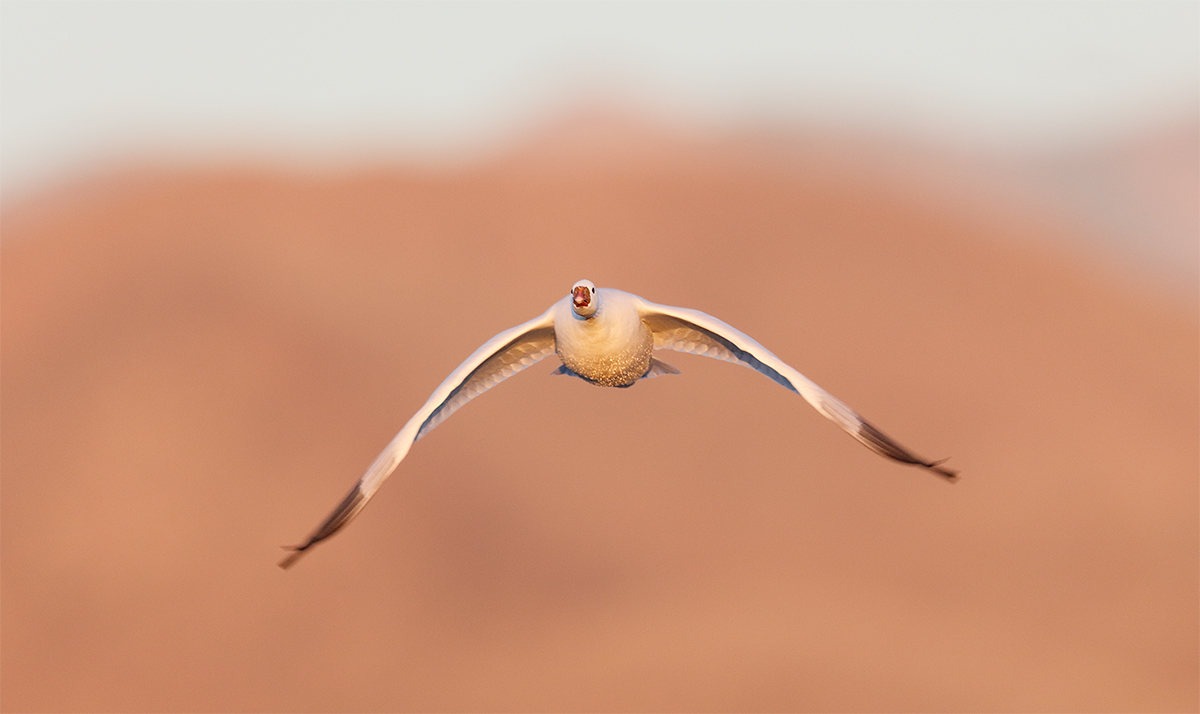
|
|
This image was created on the morning of Day 3 of the first 2015 Bosque IPT with the Induro tripod/Mongoose M3.6-mounted Canon EF 600mm f/4L IS II USM lens, the Canon Extender EF 1.4X III, and the Canon EOS 5DS R. ISO 800. Evaluative metering +2 1/3 stops off the light blue sky just above the mountains: 1/640 sec. at f/5.6 in Manual mode. Color temperature: AWB.
Center AF point (Manual selection)/AI Servo/Shutter Button AF was active at the moment of exposure. The selected AF point was on the left side of the bird’s breast just below the bird’s left eye (as originally framed). This image is a bit more than a 50% crop of the original image: 71.7mbs out of the original 144mb size of the TIFF file. Click on the image to see a larger version.
Image #2: Ross’s Goose in flight in early morning light
|
Yikes!
Talk about last but not least, I borrowed a Canon EOS 5DS R from B&H and after not trying it for a few days, have totally fallen in love with it. I am buying at least one as soon as I get home…. See here for my first impressions.
TCs
I will be making this trip with two Canon 1.4X III TCs and one 2X III TC. I lost one of my two 2X III TCs on Bleaker Island in the Falklands…. I need to replace it. Why so many TCs? With my style of bird photography–tight, clean, and graphic–I cannot afford to be without both TCs in the event of an accident or malfunction–or loss. 🙂 Most common in the malfunction category would be that the locking pin sticks occasionally. When that happens, there is a risk of having your camera body hit the ground….
Questions Welcome
If you have a question about any of my gear choices, or yours, please feel free to leave a comment. Do you disagree with any of my choices? What would you be brining to Bosque. And why?
Think Tank Rolling Bags
I will be using the larger of my two Think Tank rolling bags, the Airport Security™ V 2.0 Rolling Camera Bag. Except for the Singh-Ray polarizer and the two super-telephoto lenses that were shipped, everything above fits easily into my Airport Security™ V 2.0 Rolling Camera Bag. It tipped the scales at only 39 pounds; the legal limit for US flights is 40 pounds. Nearly all countries in the world give you slack as far as the 40 pounds goes on the way back to the US.
Think Tank Urban Disguise Laptop Shoulder Bag
Both denise and I use and love this amazing bag as it has tons of room and enables us to bring tons of extra stuff. It is like one of those circus Volkswagons….
Please click on my Think Tank affiliate link here to earn a free gift when you purchase a Think Tank Rolling Bag.
Delkin Flash Cards
As always, I will have a 64gb Delkin e-Film Pro Flash Card in each camera body so that I never have to change cards in the field thus reducing the risk of losing a card…. Please note the new lower prices here. I do have a few extra 32 and 64gb cards in a Delkin CF Memory Card Tote, mostly to protect against operator errors….
Facebook
Be sure to like and follow BAA on Facebook by clicking on the logo link upper right. Tanks a stack!
Support the BAA Blog. Support the BAA Bulletins: Shop B&H here!
We want and need to keep providing you with the latest free information, photography and Photoshop lessons, and all manner of related information. Show your appreciation by making your purchases immediately after clicking on any of our B&H or Amazon Affiliate links in this blog post. Remember, B&H ain’t just photography!
…..
Amazon.com
Those who prefer to support BAA by shopping with Amazon may use this link:
Amazon Canada
Many kind folks from north of the border, eh, have e-mailed stating that they would love to help us out by using one of our affiliate links but that living in Canada and doing so presents numerous problems. Now, they can help us out by using our Amazon Canada affiliate link by starting their searches by clicking here. Many thanks to those who have written.
Typos
In all blog posts and Bulletins, feel free to e-mail or to leave a comment regarding any typos or errors. Just be right :).
November 27th, 2015

 APPLE
15.4″ MacBook Pro Notebook Computer with Retina Display
Save $700 for a limited time only!
November 27th, 2015 What’s Up?
I wrote most of this blog post on Thanksgiving Day after a really short but really wonderful morning photo session. With the heavy cloud cover and the strong east wind, I knew that there was only one spot on the refuge that might offer some quality chances. I had been there the day before and it was dead. But on Thursday morning, it paid off in spades. As I said, it was the only game in town. (See Image #2.)
I felt much, much better on Thursday, the best I’ve felt in weeks. I had dinner with two friends at the El Camino Restaurant on the main drag in Socorro. My turkey special was quite good, so good that I ate much too much including a small piece of pumpkin pie for dessert.
How good did I feel? I went back to the refuge and photographed for four hours, almost all Infrared with my Kolari Vision converted 5D Mark II. With lots of dramatic clouds and a swirling flock of blackbirds I had a ton of fun in the sun. The sunset turned out to be a fizzle.
No dinner for me 🙂


|
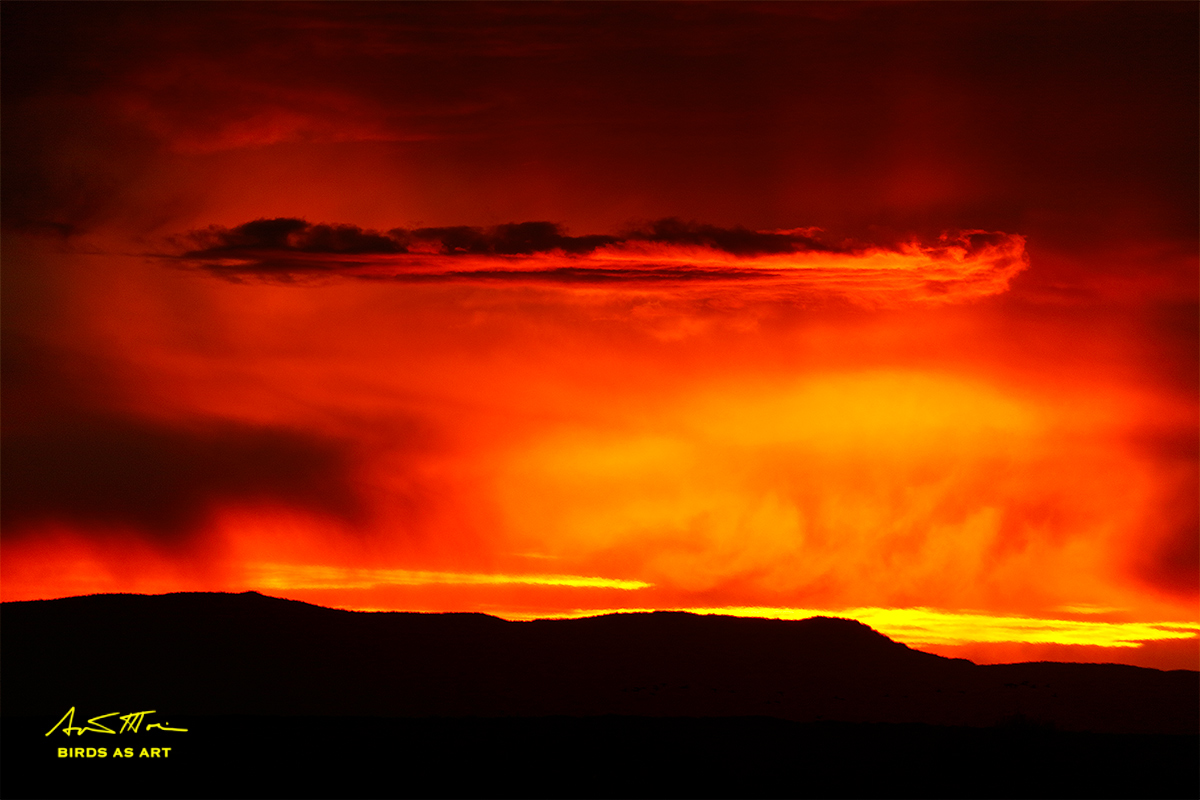
|
|
This image was created on the second morning of the first Bosque IPT with the Induro 304L Tripod/Mongoose M3.6-mounted Canon EF 200-400mm f/4L IS USM Lens with Internal 1.4x Extender (with the internal TC engaged at 420mm) and the Canon EOS 5DS R. ISO ?? Evaluative metering +1/3 stop: 1/125 sec. at f/5.6 in Tv mode. Color temperature: 8000K.
Center AF point/AI Servo Expand/Rear Focus AF as framed was active at the moment of exposure (as is always best when hand holding). Click here to see the latest version of the Rear Focus Tutorial. Click on the image to see a larger version.
Image #1: Mega-nuclear Sunrise
|
Bosque Being Bosque…
Bosque was really dead before we arrived. Then it was OK for a day or three. Then pretty lousy again. For the six days I have been here, I would rate it 3.5 out of ten as far as photographic opportunities. Now don’t get me wrong, everyone on the first IPT enjoyed lots of great chances and learned a ton, in part because of two great instructors and in part because after 21 years, I know where to be when with these sky conditions and that wind.
It is a very strange year for a variety of reasons. Aside for the first session, there has not been the traditional early morning fly-in. Numbers of geese are clearly down, possibly due to a lack of food on the refuge, and they are roosting in distant pools way north and east of the main impoundment. When they blast off, the head straight north. And disappear. There have been very few geese anywhere near the north tour loop road for the past few days. One afternoon we drove both the north and south loops and saw a grand total of one Snow Goose. But we wound up having a great afternoon anyway.
Bosque being Bosque; it can disappoint one day and leave you in tears the next….
|
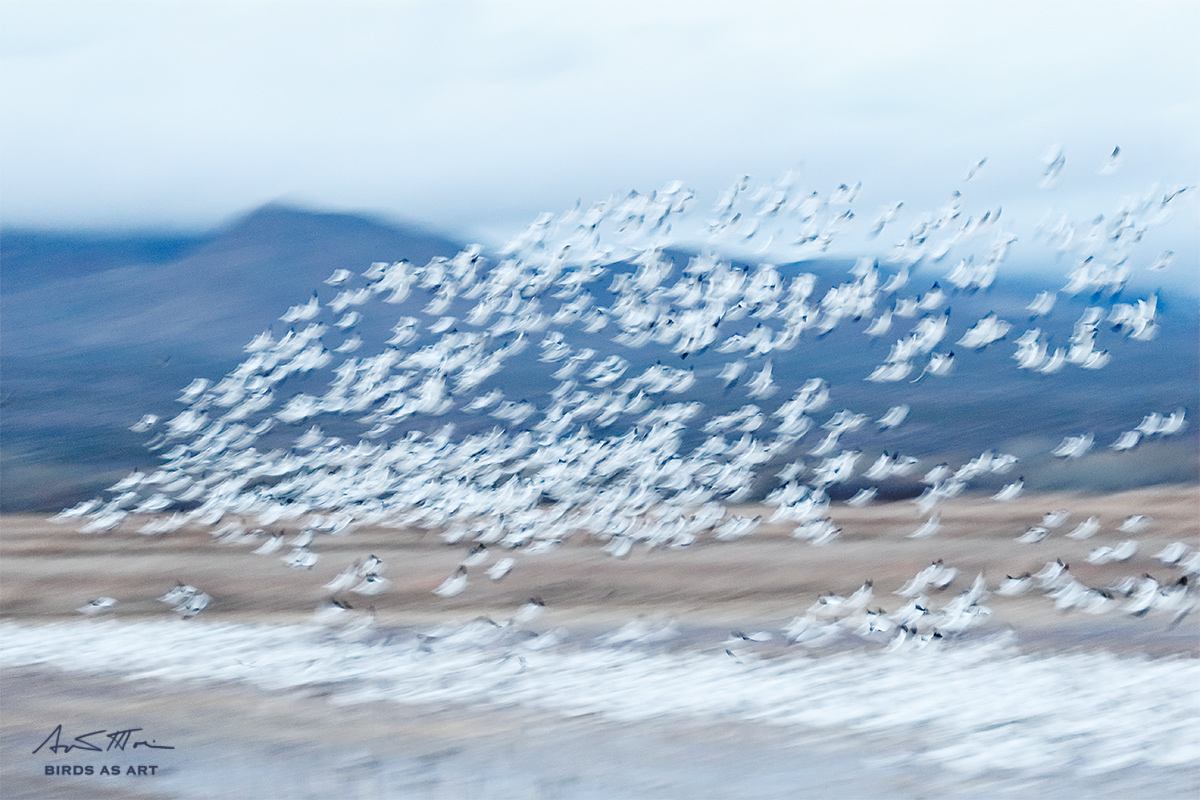
|
|
This image was created at Bosque del Apache on Thanksgiving morning with the hand held Canon EF 100-400mm f/4.5-5.6L IS II USM lens (at 170mm) and the rugged Canon EOS-1D X.. ISO: ?? Evaluative metering +1 stop: 1/15 sec. at f/5.6 in Tv mode. Color temperature: 8100K (a fortuitous error).
Center AF point (Manual selection/Rear Focus AF as framed was active at the moment of exposure (as is always best when hand holding). Click here to see the latest version of the Rear Focus Tutorial. Click on the image to see a larger version.
Image #2: Pre-dawn white geese blast off
|
ISO Challenge
What do you think the ISO was for image #1? What do you think it was for image #2?
Your Favorite?
Which image is your favorite? And why?
Facebook
Be sure to like and follow BAA on Facebook by clicking on the logo link upper right. Tanks a stack!
Support the BAA Blog. Support the BAA Bulletins: Shop B&H here!


We want and need to keep providing you with the latest free information, photography and Photoshop lessons, and all manner of related information. Show your appreciation by making your purchases immediately after clicking on any of our B&H or Amazon Affiliate links in this blog post. Remember, B&H ain’t just photography!
Amazon.com
Those who prefer to support BAA by shopping with Amazon may click on the logo-link immediately above.
Amazon Canada
Many kind folks from north of the border, eh, have e-mailed stating that they would love to help us out by using one of our affiliate links but that living in Canada and doing so presents numerous problems. Now, they can help us out by using our Amazon Canada affiliate link by starting their searches by clicking here. Many thanks to those who have written.
Typos
In all blog posts and Bulletins, feel free to e-mail or to leave a comment regarding any typos or errors. Just be right :).
November 26th, 2015
|
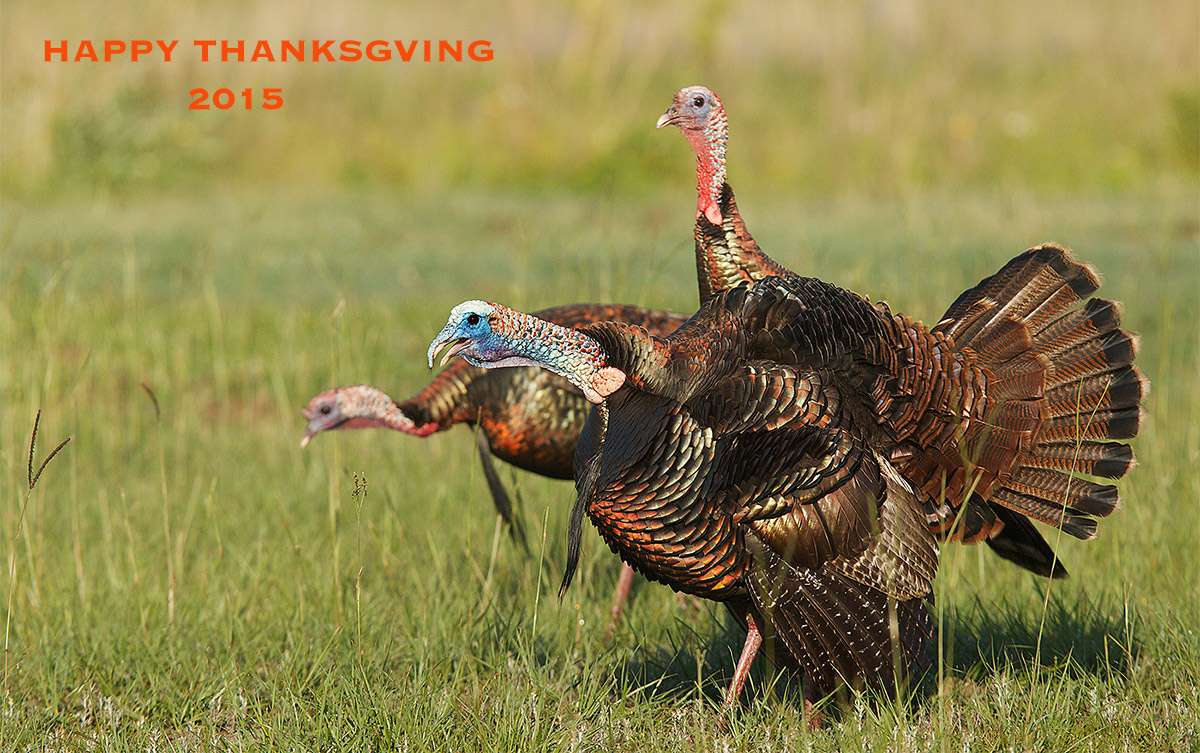
|
|
Enjoy the holiday and try not to eat too, too much.
|
Happy Bird-Day 2015
All here at BAA would like to wish you and yours a happy Thanksgiving. My older daughter Jennifer is on Long Island with her whole family visiting her sister–my younger daughter Alissa and her family–along with my Mom and my younger sister Arna. My right hand man Jim Litzenberg and his wife will be busy serving dinner to the less fortunate over on the east coast of Florida as they have done for the past 5 years.
With everyone away for the holiday BIRDS AS ART will be closed until Monday, November 30. We look forward to meeting your IPT and mail order needs when things get back to normal.


What’s Up?
I went to the refuge on Wednesday morning where I enjoyed yet another breathtaking but pretty much bird-less sunrise…. I felt a lot better than I had on Tuesday with the murderous coughing spells greatly reduced. I went to the ER in Socorro for a lung x-ray. Everyone there was very nice. I was in the examining room in minutes and checked in soon thereafter. After my history was taken I saw the doctor. She said that my lungs sounded clear and ordered the desired chest x-rays. They were done quickly but it took about two hours until the x-rays were read. But the news was great: my lungs were clear with no sign of pneumonia.
In he afternoon I noticed some pain in my right mid-back. It always takes me a few minutes to recognize the source. I am passing a small kidney stone. The way Dr. Oliver has taught me to read and understand my body I realized that there was very likely some connection between the cough/cold and the kidney stone. I gave him a buzz and asked him if I was right. “Absolutely–the Thera-Flu that you took has antihistamines in it. They dry you out internally. Bingo.
After my first very painful kidney stone episode at Point Pelee more than a few years ago, I almost always have some D-Mannose on hand. It is a sugar that coats the ureter making it easier to pass small stones. The funny thing is that I looked at the jar of D-Mannose on the counter and thought about bringing it to New Mexico. But did not. When it rains, it pours. And please do not try to get D-Mannose in Socorro, NM….
I will likely head down to the refuge for an hour or two on Thanksgiving morning and then rest up with a day of NFL games on the tube.
Selling Your Used Photo Gear Through BIRDS AS ART
Selling your used (or like-new) photo gear through the BAA Blog or via a BAA Online Bulletin is a great idea. We charge only a 5% commission. One of the more popular used gear for sale sites charges a minimum of 20% plus assorted fees! Yikes. The minimum item price here is $500. If you are interested please e-mail with the words Items for Sale Info Request cut and pasted into the Subject line :). Stuff that is priced fairly–I offer free pricing advise, usually sells in no time flat.
Canon EOS-1D Mark IV professional digital camera body
Friend and multiple IPT veteran Larry Master is offering a Canon EOS-1D Mark IV professional digital camera body in excellent condition for $1399. The sale includes the original box, the camera manual, the front cap, all cables and CDs, and insured shipping by UPS Ground to US addresses only. Personal checks only; your camera will be shipped only after your check clears.
Interested folks may contact Larry on his cell phone at 518-645-1545 or via e-mail.
Two rugged 1D Mark IVs served as my workhorse professional bodies for several years. artie
Facebook
Be sure to like and follow BAA on Facebook by clicking on the logo link upper right. Tanks a stack!
Support the BAA Blog. Support the BAA Bulletins: Shop B&H here!


We want and need to keep providing you with the latest free information, photography and Photoshop lessons, and all manner of related information. Show your appreciation by making your purchases immediately after clicking on any of our B&H or Amazon Affiliate links in this blog post. Remember, B&H ain’t just photography!
Amazon.com
Those who prefer to support BAA by shopping with Amazon may click on the logo-link immediately above.
Amazon Canada
Many kind folks from north of the border, eh, have e-mailed stating that they would love to help us out by using one of our affiliate links but that living in Canada and doing so presents numerous problems. Now, they can help us out by using our Amazon Canada affiliate link by starting their searches by clicking here. Many thanks to those who have written.
Typos
In all blog posts and Bulletins, feel free to e-mail or to leave a comment regarding any typos or errors. Just be right :).
November 25th, 2015 What’s Up?
I am feeling lot better as I type early on the morning of Wednesday November 25, 2015. I am much less congested but the dry hacking coughing spells that I had off and on yesterday were not fun. My plan is to get a chest X-ray done today.
I will be heading out for sunrise in a few and follow that up with a day of rest. The next IPT group begins on Saturday afternoon. The first group had a ball despite overall bad luck and relatively poor conditions so far. There were lots of goodbye hugs at the crane pool last night….
If…
If you are inspired to purchase a 5DS R by what you read or see here on the blog over the next few weeks please remember to use my B&H product specific links to purchase yours from B&H. Many thanks, and happy bird-day tomorrow.
Enjoy the Blog?
Do you enjoy reading the blog? Do you learn something on most visits? Are you all set as far as gear goes? If yes to all of those, please consider making a BAA Blog Thank You Donation by clicking here. And if you do need some new gear, please use my affiliate links, most especially, the B&H affiliate logo link just to the right of this text. Simply click and begin your search and shopping spree :). Note: web orders only. Also, there will be no indication that your purchases will be tracked to BAA. The tracking is invisible. That’s why we ask folks to send us their B&H receipts for major purchases via e-mail. Please remember: no phone orders…. Many thanks for considering these requests. a

Induro $50 Instant Rebate
The Induro $50 instant rebate will last only until the end of this year. Click on the logo-link above to save $50 on our favorite tripods. On our recent grueling trip to the Southern Ocean Denise loved her new GIT 304 and I love my new GIT 304L. Both performed flawlessly in the mud, snow and ice.
Induro GIT 404L Super Sale Correction!
For a limited time only the Induro GIT 404L is being offered for the ridiculously low price of $470 (including the $50 instant rebate). I apologize for the $370 typo that appeared in yesterday’s blog.) The best news is that the $470 price will be offered for at least a few days more.
The Induro GIT 404L is a 4-leg section Grand Series tripod. It is slightly bigger and one pound heavier than the GIT 304L; it is the perfect tripod for those using big glass who would like a bit more stability.
|
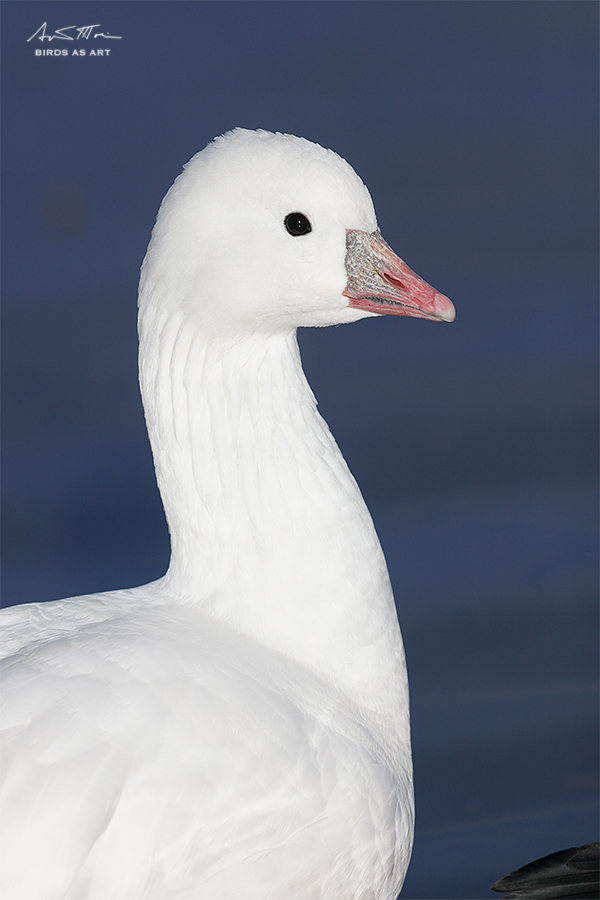
|
|
This image was created on Day 2 of the first 2015 Bosque IPT with the Induro tripod/Mongoose M3.6-mounted Canon EF 600mm f/4L IS II USM lens, the Canon Extender EF 1.4X III, and the Canon EOS 5DS R. ISO 400. Evaluative metering at zero: 1/2500 sec. at f/8 in Manual mode. AWB.
Center AF point (manual selection)/AI Servo/Rear Focus AF on the goose’s eye and re-compose. Click here to see the latest version of the Rear Focus Tutorial. Click on the image to see a larger version.
Image #1: Ross’s Goose vertical head and neck portrait
|
Canon EOS-5DS R for Birds: An Overview
I borrowed a full frame 50.6 megapixel EOS-5DS R from B&H for the Bosque trip and used it for the first time on Monday afternoon. To say that I was impressed is an understatement. For those coming from a 5D III or a 7D II there is virtually no learning curve (though there were a few quirky items). AF is surprisingly quick and sure and the AF system is pretty much the same as on the two previously mentioned cameras. Five frames/second seems a bit clunky as compared to the 1D X but for my style of bird photography where I rarely hold the hammer down the slower frame rate is not much of a hindrance. And having what amounts to a medium format DSLR for sports and nature photography is hard to comprehend.
I have been using the 5DS R with my 600 ever since I saw the first image files and right now I am planning on buying a 5DS R as soon as I get home…
|
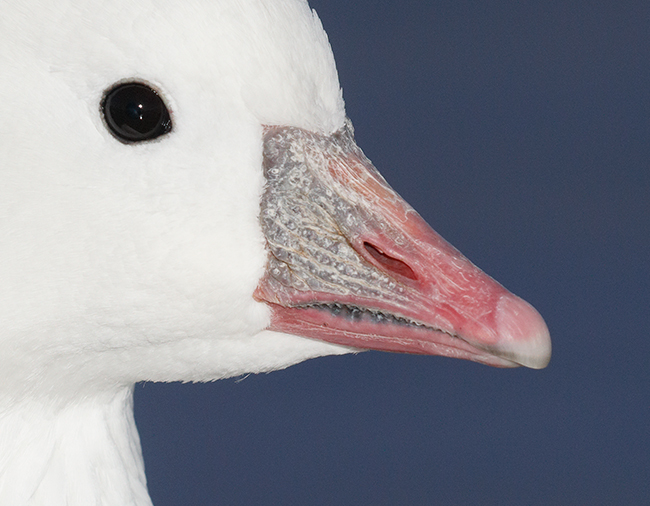
|
|
This is a 100% crop of the optimized TIFF for today’s featured image that was sized to 600 pixels wide and then displayed at 475 pixels wide. Image quality with the 5DS R is really hard to believe.
|
I’ve never seen image files like these…
At lunch on Tuesday I shared a head portrait of a young blue morph Snow Goose at 100% with the group; everyone gasped when they saw the fine feather detail and the incredible resolution. Some folks were breathless. I have never seen images files with detail like a sharply focused 5DS R image file. I will be sharing lots more 5DS R images with you here in the near future.
|
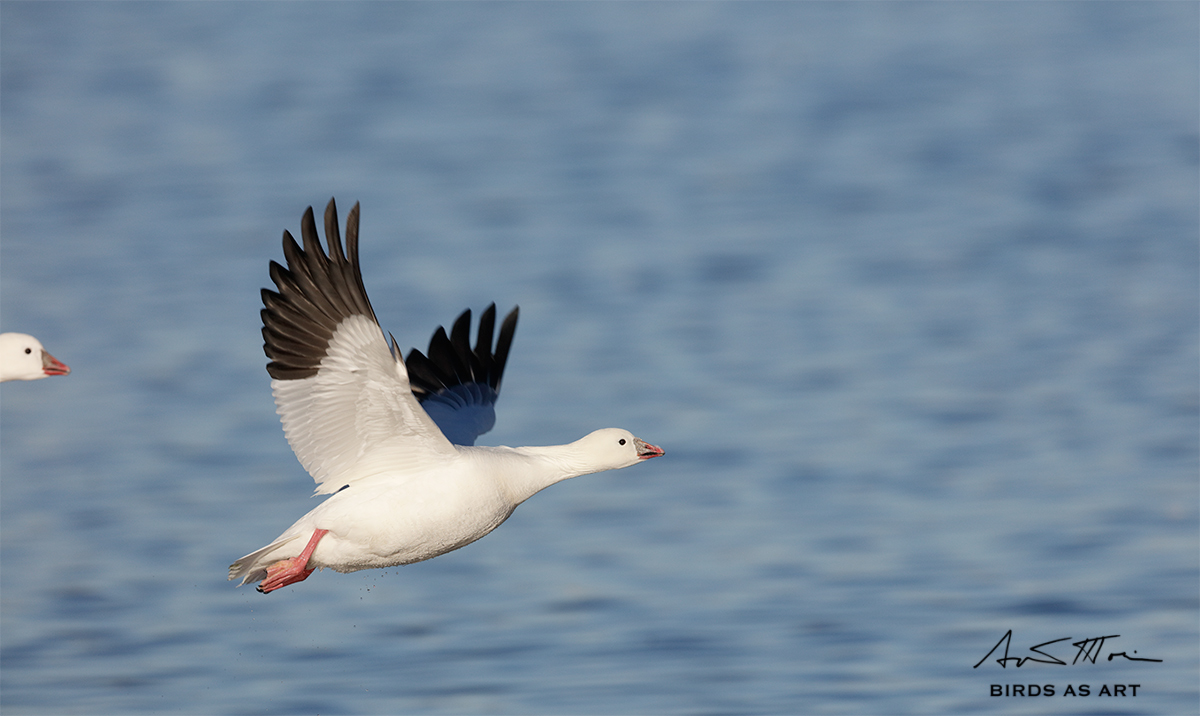
|
|
This image was also created on Day 2 of the first 2015 Bosque IPT with the Induro tripod/Mongoose M3.6-mounted Canon EF 600mm f/4L IS II USM lens, the Canon Extender EF 1.4X III, and the Canon EOS 5DS R. ISO 400. Evaluative metering -1/3 stop as framed: 1/2000 sec. at f/8 in Manual mode. AWB.
Center AF point/AI Servo Expand/Rear Focus AF was active at the moment of exposure. The selected AF point was just above the bird’s eye as originally framed. This image is a small crop from the original. Click here to see the latest version of the Rear Focus Tutorial. Click on the image to see a larger version.
Image #1: Ross’s Goose taking flight
|
5DS R AF
I was pleasantly surprised by the speed and accuracy of the AF system and AF tracking accuracy. Lots more to come on this topic.
|
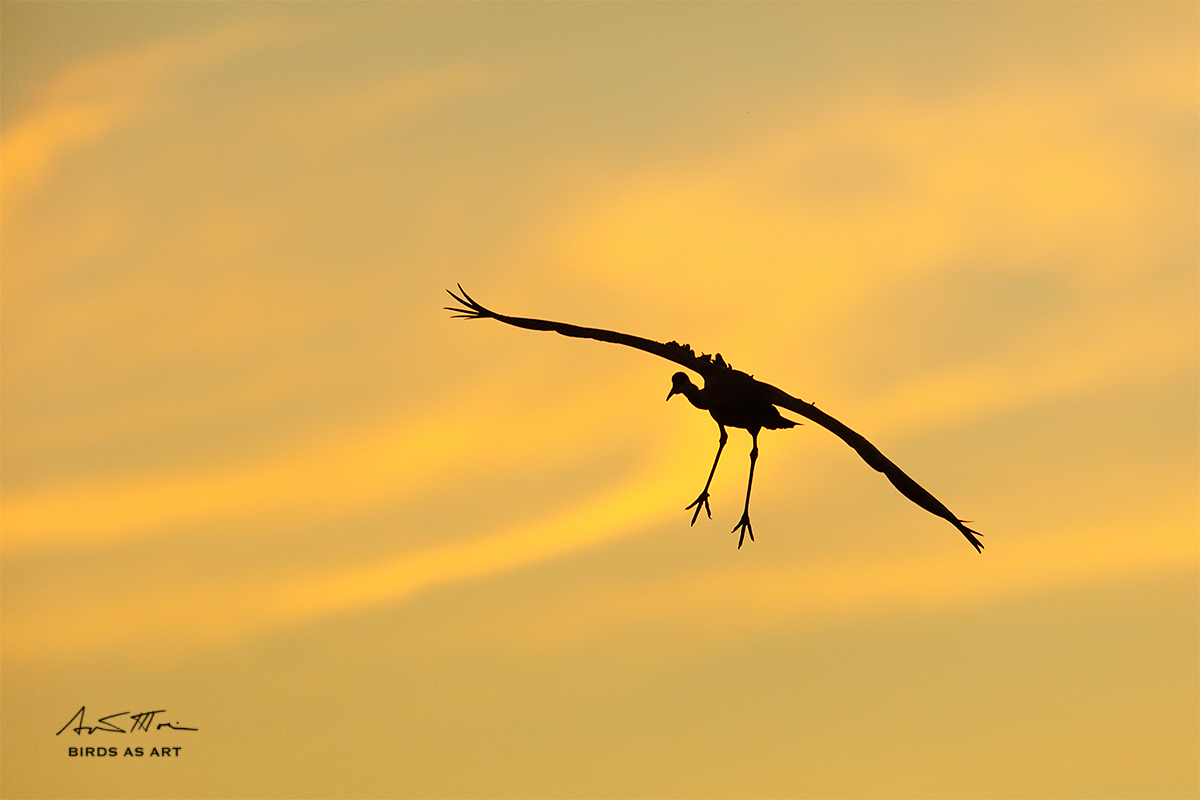
|
|
This image too was also created on Day 2 of the first 2015 Bosque IPT with the Induro tripod/Mongoose M3.6-mounted Canon EF 600mm f/4L IS II USM lens, the Canon Extender EF 1.4X III, and the Canon EOS 5DS R. ISO 1600. Evaluative metering +2/3 stop as framed: 1/1600 sec. at f/5.6 in Manual mode. Color temperature: K8000.
Center AF point/AI Servo Expand/Shutter Button AF was active at the moment of exposure. The selected AF point was just below the tip of the bird’s bill so the assist points were likely instrument in the accurate focus. This image is a small crop from the original from the right and below. Click on the image to see a larger version.
Image #3: Sandhill Crane sunset silhouette/landing gear down.
|
High ISO with the 5DS R
I have not done much with the higher 5DS R ISOs yet. The lack of background noise in this crane landing silhouette noise is impressive. After the trip I will get a bunch of 5DS R Raw files to Arash to see what he thinks about the noise. And about the fine feather detail.
What Do You Think?
What do you think of the 5DS R images? Which of the three is your favorite? Why?
Mid-Morning Update from the ER
Two things that I had wanted to mention:
1-Though I never filled the buffer–I rarely do–I did notice that when I took two or three images in a row that it took a few seconds to be able to view the histogram via image review.
2-Seeing the JPEGs here cannot give you any idea of the incredible detail that you see when viewing a sharp image at 100% on a Macbook Pro with retina display.
Facebook
Be sure to like and follow BAA on Facebook by clicking on the logo link upper right. Tanks a stack!
Support the BAA Blog. Support the BAA Bulletins: Shop B&H here!


We want and need to keep providing you with the latest free information, photography and Photoshop lessons, and all manner of related information. Show your appreciation by making your purchases immediately after clicking on any of our B&H or Amazon Affiliate links in this blog post. Remember, B&H ain’t just photography!
Amazon.com
Those who prefer to support BAA by shopping with Amazon may click on the logo-link immediately above.
Amazon Canada
Many kind folks from north of the border, eh, have e-mailed stating that they would love to help us out by using one of our affiliate links but that living in Canada and doing so presents numerous problems. Now, they can help us out by using our Amazon Canada affiliate link by starting their searches by clicking here. Many thanks to those who have written.
Typos
In all blog posts and Bulletins, feel free to e-mail or to leave a comment regarding any typos or errors. Just be right :).
November 24th, 2015 What’s Up?
Bosque was terrible before we arrived but things are looking much better right now. Again I enjoyed a horrific night’s sleep and can finally say that I feel pretty lousy with a stuffed nose, chest congestion, and a dry hacking cough, all of which kept me up most of the night. I gave up on sleep at 3am and went to work on the laptop. Still no sore throat. I am hoping not to wind up in the hospital but till then I will be out there teaching and photographing….
If however, I still feel this lousy by Wednesday, I may take a few days off to rest between IPTs….
Enjoy the Blog?
Do you enjoy reading the blog? Do you learn something on most visits? Are you all set as far as gear goes? If yes to all of those, please consider making a BAA Blog Thank You Donation by clicking here. And if you do need some new gear, please use my affiliate links, most especially, the B&H affiliate logo link just to the right of this text. Simply click and begin your search and shopping spree :). Note: web orders only. Also, there will be no indication that your purchases will be tracked to BAA. The tracking is invisible. That’s why we ask folks to send us their B&H receipts for major purchases via e-mail. Please remember: no phone orders…. Many thanks for considering these requests. a

Induro $50 Instant Rebate
The Induro $50 instant rebate will last only until the end of this year. Click on the logo-link above to save $50 on our favorite tripods. On our recent grueling trip to the Southern Ocean Denise loved her new GIT 304 and I love my new GIT 304L. Both performed flawlessly in the mud, snow and ice.
Induro GIT 404L Super Sale!
For a limited time only the Induro GIT 404L is being offered for the ridiculously low price of $370 (including the $50 instant rebate). The Induro GIT 404L is a 4-leg section Grand Series tripod. It is slightly bigger and one pound heavier than the GIT 304L; it is the perfect tripod for those using big glass who would like a bit more stability.

Gura Gear Backpack Blowout
I do not use a backpack. But many of my and denise’s clients who do have long raved about the Guru Gear backpacks. As have many professionals. These great photo backpacks are being phased out and will not be replaced in their present form. Take advantage of the huge price reductions on three popular models, the Bataflae 26L, the Bataflae 32L, and the Bataflae 18L, and enjoy a superbly high quality backpack that with its sturdy, high end zippers and durable fabric will serve you well for many years.
|

|
|
This image was created on the first afternoon of the first Bosque IPT on the morning of Sunday, November 22, 2015 with the hand held Canon EF 400mm f/4 DO IS II USM lens, the Canon Extender EF 1.4X III, and the amazing Canon EOS 7D Mark II. ISO 400. Evaluative metering +1 stop off the light blue sky: 1/3200 sec. at f/7.1.
Center AF point/AI Servo Expand/Shutter Button AF as framed was active at the moment of exposure (as is always best when hand holding). Click on the image to see a larger version.
Four White Geese…
|
The Intermediate View
99% of the avian images that I have created over the past 32 years fall into one of these categories: images of a single bird; images of a single bird in flight; images of two birds interacting; tight head portraits or body parts images; bird-scapes featuring a small-in-the-frame subject or a small flocks of birds set in beautiful habitat (many folks call these environmental or habitat images); or large frame-filling images of flocks of birds in flight, often intentionally blurred, and often referred to as pure pattern shots.
What’s missing? Images featuring 3-10 avian subjects in the same frame. These intermediate views are very difficult to pull off successfully for a variety of reasons:
1-The subject often overlap creating unpleasant merges.
2-coming up with a pleasing arrangement or grouping without clipping any wingtips or subjects on the edge of the frame is a big challenge. Zoom lenses help here of course.
3-getting 3 or 5 or 8 good head angles in a single frame is nearly impossible.
4-with images of groups of birds in flight, it is nearly impossible to come up with all good wing positions.
Lunch Time Comment Hits Paydirt…
During our first image review session I showed about 25 images of groups of geese with about 6-10 birds in each image. All of the images were deleted for a variety of reasons:
1-the image was poorly framed.
2-one or more (often many) of the birds showed less than ideal wing positions.
I said to the group, “Why take so many images like these when the chances of success are miniscule? ”
The answer: “Once in a while you hit bingo!” I advised them to frame the images as well as the could after acquiring focus and then hold the shutter button down for at least a few images. I said to them, “You have many thousands of dollars (if not tens of thousands) worth of gear and you spent a lot of money to get here. What does it cost you to push the shutter button when a situation offers a potential payoff in the form of a good image?”
Then I went out and hit bingo.
ID Challenge
Can you identify each of the four adult birds in today’s featured image to species starting with the leftmost bird and going clockwise?
Facebook
Be sure to like and follow BAA on Facebook by clicking on the logo link upper right. Tanks a stack!
Support the BAA Blog. Support the BAA Bulletins: Shop B&H here!


We want and need to keep providing you with the latest free information, photography and Photoshop lessons, and all manner of related information. Show your appreciation by making your purchases immediately after clicking on any of our B&H or Amazon Affiliate links in this blog post. Remember, B&H ain’t just photography!
Amazon.com
Those who prefer to support BAA by shopping with Amazon may click on the logo-link immediately above.
Amazon Canada
Many kind folks from north of the border, eh, have e-mailed stating that they would love to help us out by using one of our affiliate links but that living in Canada and doing so presents numerous problems. Now, they can help us out by using our Amazon Canada affiliate link by starting their searches by clicking here. Many thanks to those who have written.
Typos
In all blog posts and Bulletins, feel free to e-mail or to leave a comment regarding any typos or errors. Just be right :).
November 23rd, 2015 What’s Up?
I wrote most of this blog post on the ship and am finishing it up early on the morning of Sunday November 22, 2015. I have been working since 2:30am, after sleeping fitfully for five hours. It was a rough night as, with a mega-stuffed nose, I peeked at the clock every 20 minutes or so…. Happily, still no sore throat. But I have begun feeling pretty lousy 🙂
We have our first morning Bosque IPT session in exactly one hour. This blog post took several hours to assemble, that with lots of help from Pauline Carr. Many thanks Pauline.
|
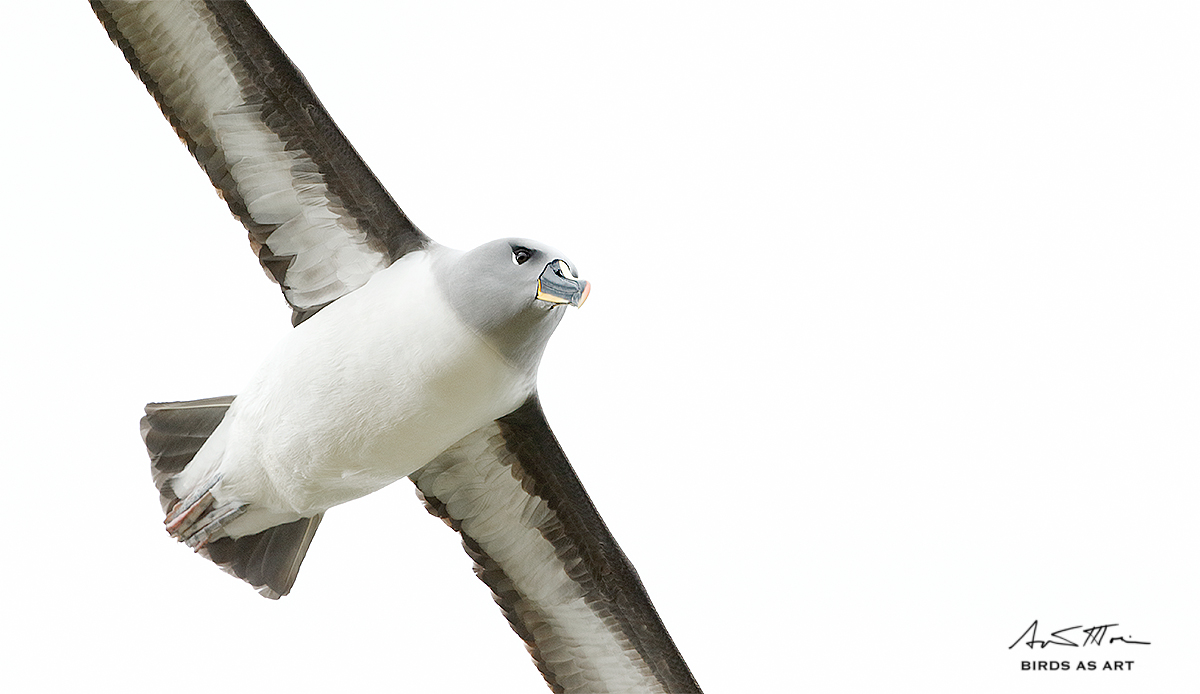
|
|
This image was created at Elsehul, South Georgia with the hand held Canon EF 400mm f/4 DO IS II USM lens and the rugged professional body, the Canon EOS-1D X. ISO 500. Evaluative metering +2/3 stop off the green water below: 1/2500 sec. at f/4 in Manual mode. AWB.
Center AF point (Manual selection)/AI Servo/Shutter Button Focus AF as originally framed was active at the moment of exposure. The selected AF point was on the tip of the bird’s bill; the previous frame was not focused accurately. Click on the image to see a larger version.
Grey-headed Albatross tight flight image
|
Getting Older and Seeing the Situation…
The expedition staff let us know that the hike to the grey-headed nest would be long and arduous. I knew right off the bat that the long, steep climb through tussock grass and mud was physically beyond me. And beyond several others in the BAA group. As we landed I saw lots of Grey-headed and Light Mantled Sooty Albatrosses flying over a bluff just above the beach. Expedition staff leader team Tim Carr had found a nest of the latter species just beyond the bluff. I asked for and received permission to make the moderate climb to the top of the bluff and hang out waiting for some albatrosses and giant petrels to fly by. The going was tough at first but those who joined me and persisted enjoyed some very good chances.
Tight Flight Miracle
When photographing birds in flight I encourage folks to try to keep shooting as the birds get closer. Maintaining accurate focus on the face as they approach point blank range is difficult. Properly framing the image so as to get the tail in the frame is a near-impossibility. If, however, you do not try, it is guaranteed that you will never succeed.
The story of a critically endangered albatross species…
Grey-headed Albatross is a critically endangered species; the epicenter of their population is centered around Elsehul and several other nearby islands in South Georgia. Most fatalities are the result of long line fishing for swordfish and tuna. Lines with tens of thousands of baited hooks, some as long as 40 nautical miles (and even triple that length!), are deployed. As the lines are tossed overboard many species of albatross grab the bait and those that are hooked succumb quickly.
To reduce mortality fishing within 200 miles of in South Georgia and a massive surrounding area, active fishing is permitted only at night, the long lines are weighted to sink the bait more quickly, distracting streamer lines are employed, the dumping of offal while the lines are being set is not permitted, and each ship has an observer aboard. Because boats that catch six birds of any species must stop fishing and leave the protected area the crews are very, very careful and bird deaths have been greatly reduced.
The stark numbers reveal that there are now about 16,000 pairs of Grey-headed Albatross down from 84,000 pairs in the early 1990s.
As noted previously, everything above in italics is courtesy of Pauline Carr via personal comment on the ship. (See more on Pauline and Tim Carr here.)
|
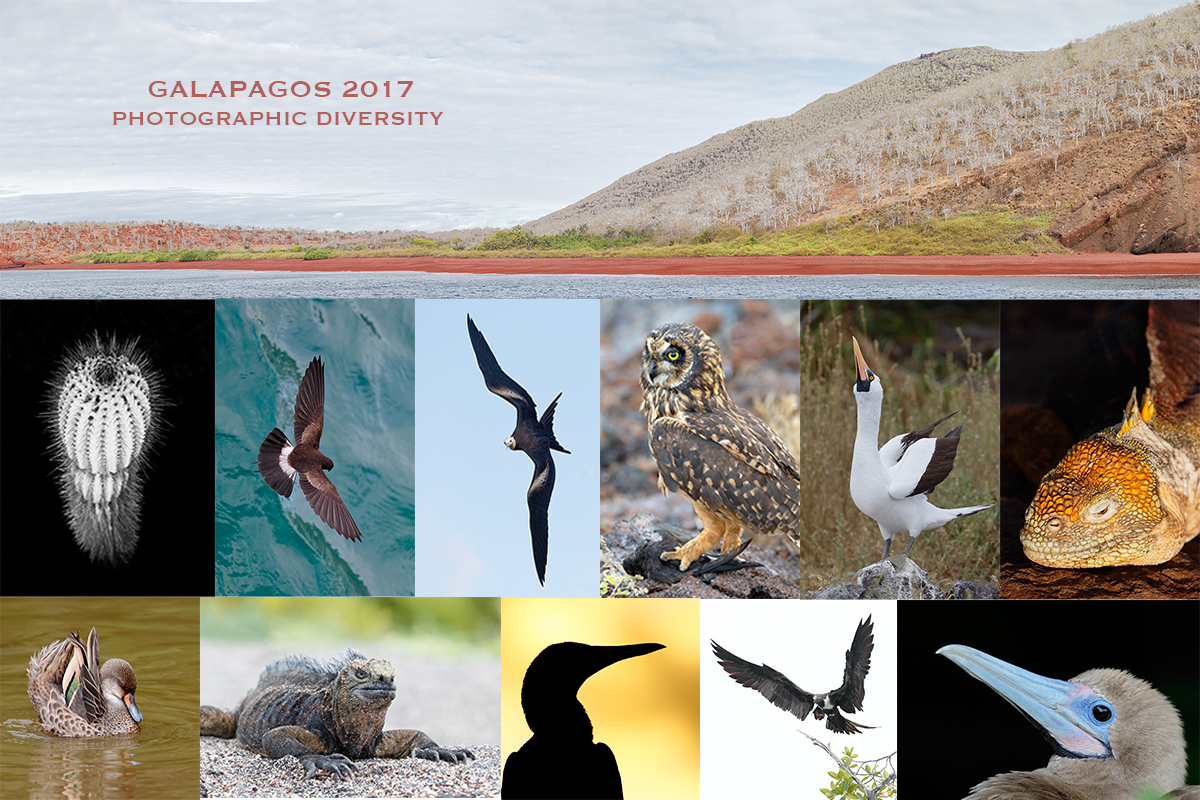
|
|
Tame birds and wildlife. Incredible diversity. You only live once….
|
GALAPAGOS Photo Cruise of a Lifetime IPT/The Complete Galapagos Photographic Experience. August 8-22, 2017 on the boat. 13 FULL and two half-days of photography: $12,499. Limit: 12 photographers plus the two leaders: Denise Ippolito and yours truly. Openings: 8.
Same great trip; no price increase!
Four slots filled already; this trip needs nine to run; in the unlikely event that it does not, all payments to BAA will be refunded in full.
My two-week Galapagos Photo-Cruises are without equal. The world’s best guide, a killer itinerary, a great boat (the Samba), and two great leaders with ten Galapagos cruises under their belts. Pre-trip and pre-landing location-specific gear advice. In-the-field photo instruction and guidance. Jeez, I almost forgot: fine dining at sea!
The great spots that we will visit include Tower Island (including Prince Phillips Steps and Darwin Bay), Hood Island (including Punta Suarez, the world’s only nesting site of Waved Albatross, and Gardner Bay)—each of the preceding are world class wildlife photography designations that rank right up there with Antarctica, Africa, and Midway. We will also visit Fernandina, Puerto Ayora for the tortoises, Puerto Egas—James Bay, and North Seymour for nesting Blue-footed Boobies in most years, South Plaza for Land Iguanas, Floreana for Greater Flamingoes, and Urbina Bay, all spectacular in their own right. We visit every great spot on a single trip. Plus tons more. And there will be lots of opportunities to snorkel on sunny mid-days for those like me who wish to partake.
It is extremely likely that we will visit the incredible Darwin Bay and the equally incredible Hood Island, world home of Waved Albatross twice on our voyage. The National Park Service takes its sweet time in approving such schedule changes.
We will be the first boat on each island in the morning and the last boat to leave each island every afternoon. If we are blessed with overcast skies, we will often spend 5-6 hours at the best sites. And as noted above, mid-day snorkeling is an option on most sunny days depending on location and conditions. On the 2015 trip most snorkeled with a mega-pod of dolphins. I eased off the zodiac to find hundreds of dolphins swimming just below me. Note: some of the walks are a bit difficult but can be made by anyone if half way decent shape. Great images are possible on all landings with either a hand held 70-200mm lens and a 1.4X teleconverter or an 80- or 100-400. I bring a longer lens ashore on most landings as they better fit my style. I generally bring only one of these as my big lens: the Canon 300mm f/2.8L IS, the new Canon 400mm DO lens, or the Canon 200-400mm f/4 L IS with Internal Extender.
|
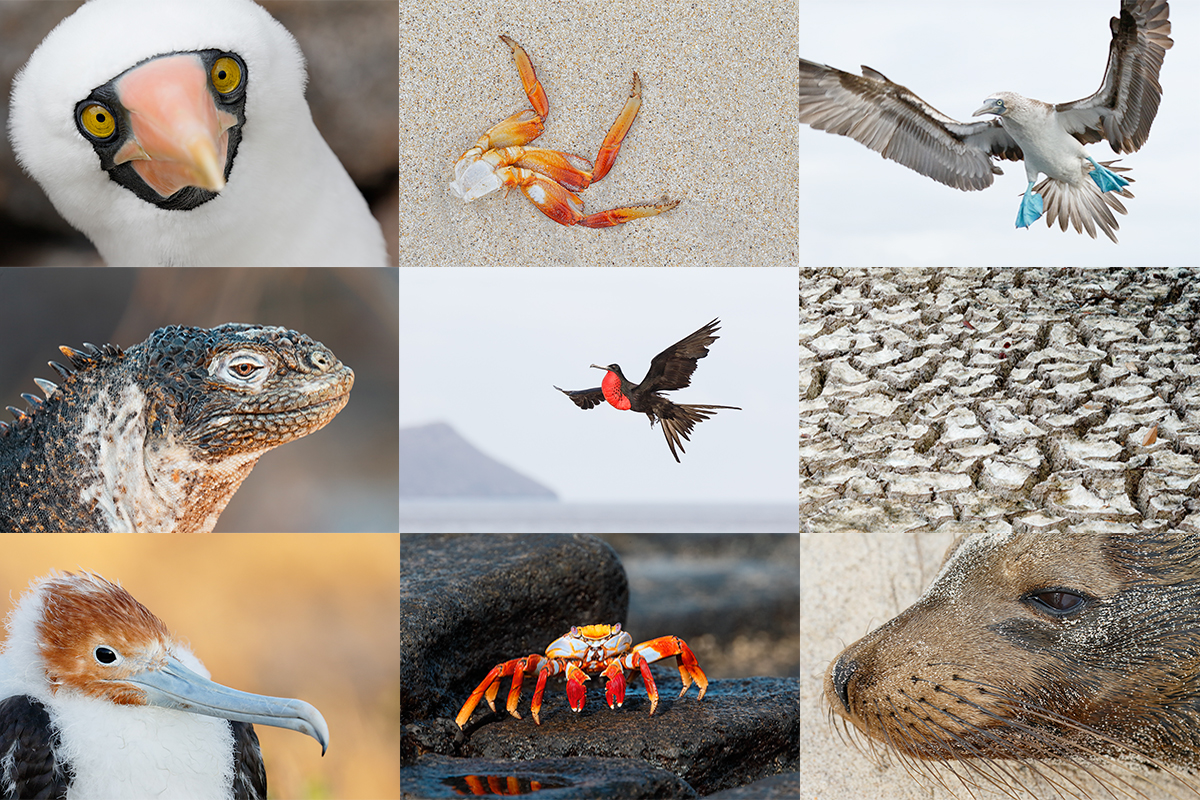
|
|
Do consider joining denise and me for this once in a lifetime trip to the Galapagos archipelago. There simply is no finer Galapagos photography trip. Learn why above.
|
An Amazing Value…
Do know that there are one week Galapagos trips for $8500! Thus, our trip represents a tremendous value; why go all that way and miss half of the great photographic locations?
The Logistics
August 6, 2017: We arrive a day early to ensure that we do not miss the boat.
August 7, 2017: There will be an introductory Galapagos Photography session and a hands on exposure session at our hotel.
August 8, 2017: We fly to the archipelago and board the Samba. Heck, on the 2015 trip some people made great images at the dock in Baltra while our luggage was being loaded!
August 22, 2017: We disembark late morning and fly back to Guayaquil midday; most will overnight there.
Most will fly home on the early morning of July 23 unless they are staying on or going elsewhere (or catching a red-eye flight on the evening of the 22nd).
$12,499 includes just about everything: all transfers, guide and park fees, all food on the boat, transfers and ground transportation, your flights to the archipelago, and three nights (double occupancy) in a top notch hotel in Guayaquil. If you are good to go, a non-refundable deposit of $5,000 per person is due immediately. The second payment of $4,000 is not due until 11/1/16. The final payment of $3449 per person will be due on 2/1/17. A $200 discount will be applied to each of the balances for couples or friends who register at the same time.
Purchasing travel insurance within 2 weeks of our cashing your deposit check is strongly recommended. On two fairly recent cruises a total of 5 folks were forced to cancel less than one week prior to the trip. My family and I use Travel Insurance Services and strongly recommend that you do the same.
Not included: your round trip airfare from your home to and from Guayaquil, beverages on the boat, phone calls, your meals in Guayaquil, personal items, and a $600/person cash tip for the crew and the guide—this works out to roughly $40/day to be shared by the 7 folks who will be waiting on us hand and foot every day for two weeks. The service is so wonderful that many folks choose to tip extra.
Please e-mail for the tentative itinerary or with questions. Please cut and paste “Galapagos 2017 Tentative Itinerary Please” into the Subject line.
Facebook
Be sure to like and follow BAA on Facebook by clicking on the logo link upper right. Tanks a stack!


Support the BAA Blog. Support the BAA Bulletins: Shop B&H here!
We want and need to keep providing you with the latest free information, photography and Photoshop lessons, and all manner of related information. Show your appreciation by making your purchases immediately after clicking on any of our B&H or Amazon Affiliate links in this blog post. Remember, B&H ain’t just photography!
Amazon.com
Those who prefer to support BAA by shopping with Amazon may click on the logo-link immediately above.
Amazon Canada
Many kind folks from north of the border, eh, have e-mailed stating that they would love to help us out by using one of our affiliate links but that living in Canada and doing so presents numerous problems. Now, they can help us out by using our Amazon Canada affiliate link by starting their searches by clicking here. Many thanks to those who have written.
Typos
In all blog posts and Bulletins, feel free to e-mail or to leave a comment regarding any typos or errors. Just be right :).
November 22nd, 2015 What’s Up?
The cold has gotten worse with a chafed runny nose, lots of loud sneezing, and some nasty congestion but I am still glad that I do not have a sore throat (knock on wood).
I prepared this blog post on the late afternoon of Saturday, NOV 21, 2015. We meet the first IPT group at 7pm tonight for an introductory program that includes a slide program. And then head out into the cold blackness early tomorrow morning.
Bosque IPT #2:Last Chance: $200 Late Registration Discount Offer!
Try Jim in the office on Monday to sign up for the last spot on the second Bosque IPT. We have room for either one photographer or for a couple. See the complete details here.
The BIRDS AS ART Blog and You
To show your appreciation for my efforts here, we do ask that you use our the B&H and Amazon affiliate links on the right side of the blog for all of your purchases. Doing so won’t cost you a penny and is the best way to thank me for the 15-20 hours I put in to bring you fresh and free educational material most every day. Please check the availability of all photographic accessories in the BIRDS AS ART Online Store. We sell only what I use and depend on. We will not sell you junk. We know what you need to make creating great images easy and fun. And we are always glad to answer your gear questions via e-mail (unless I am traveling without internet!)
You can find the following items in the store: Mongoose M3.6 and Wimberley heads, plates, low feet, and accessories, flash brackets, , Delkin e-film Pro Compact Flash Cards, LensCoat products, and our unique line-up of educational materials including ABP I & II, Digital Basics, Site and Set-up e-Guides, Canon and Nikon Camera Users and AF e-Guides, and MP-4 Photoshop video tutorials among others.
And we still have a few Gitzo tripods in stock. I imagine that we will be phasing those out soon….
I would of course appreciate your using our B&H affiliate links for all of your major gear, video, and electronic purchases. Please remember: web orders only! For the photographic stuff mentioned in the paragraph above we, meaning BAA, would of course greatly appreciate your business. Here is a huge thank you to the many who have been using our links on a regular basis and visiting the BAA Online store as well.
|
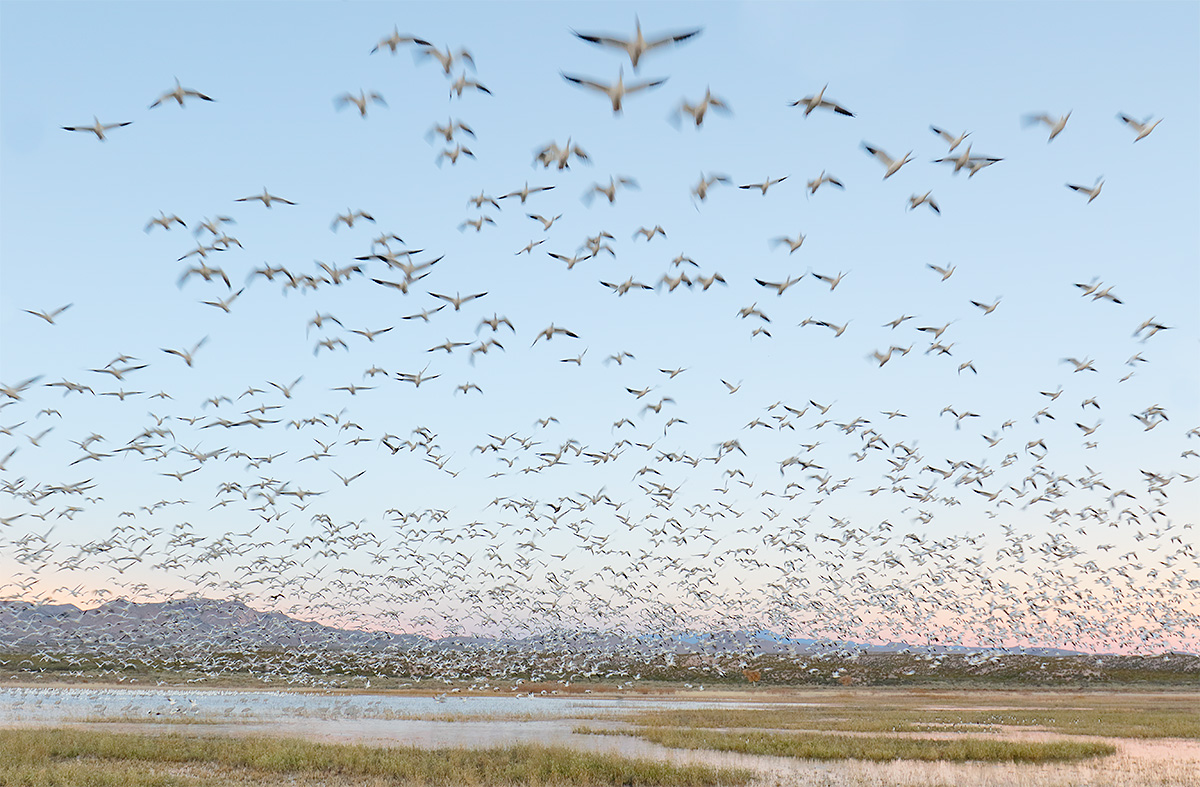
|
|
This image was created at at 6:44am on Saturday morning, November 21 at Bosque del Apache NWR with the hand held Canon EF 16-35mm f/4L IS USM lens (at 16mm) and the amazing Canon EOS 7D Mark II. ISO 400. Evaluative metering +1 1/3 stop: 1/60 sec. at f/5.6.
Center AF point/AI Servo Expand/Rear Focus AF as framed was active at the moment of exposure (as is always best when hand holding). Click here to see the latest version of the Rear Focus Tutorial. Click on the image to see a larger version.
Snow Goose Wide Angle Blast
|
Everyone Missed the Obvious Shot. But Me 🙂
We did quite well at the Main Impoundment with lots of birds and the first colorful sunrise of the season. Then we made the standard move. There were a thousand geese in the pond. As I faced north I felt a bit of a breeze on my right cheek. I knew what that meant. I had started the day with the 100-400 II/7D II combo on an RS-strap. When I saw the big gathering of geese and felt the wind slightly from the east I grabbed my second 7D II and mounted the 16-35 f/f4. That rig went on a second RS-7 strap. When I got to the pond I walked north to the front of the goose flock. I have already set both camera bodies to Tv mode at +1 1/3 stops. The geese had been taking off in groups of 3 or 4. I had barely gotten into position when the birds blasted off right at me.
There were probably more than 100 photographers all with super-telephoto lenses. There was not a single short lens in sight except for the one in my hands. The experience left me shaking my head as there were four or five supposedly top photographic leaders guiding groups for the Festival of the Cranes. I guess that they should have read the Bosque Site Guide.
The message here is the same as always: see the light and read the wind. Then get yourself in the right place and go to work.
|

|
|
Tame birds and wildlife. Incredible diversity. You only live once….
|
GALAPAGOS Photo Cruise of a Lifetime IPT/The Complete Galapagos Photographic Experience. August 8-22, 2017 on the boat. 13 FULL and two half-days of photography: $12,499. Limit: 12 photographers plus the two leaders: Denise Ippolito and yours truly. Openings: 8.
Same great trip; no price increase!
Four slots filled already; this trip needs nine to run; in the unlikely event that it does not, all payments to BAA will be refunded in full.
My two-week Galapagos Photo-Cruises are without equal. The world’s best guide, a killer itinerary, a great boat (the Samba), and two great leaders with ten Galapagos cruises under their belts. Pre-trip and pre-landing location-specific gear advice. In-the-field photo instruction and guidance. Jeez, I almost forgot: fine dining at sea!
The great spots that we will visit include Tower Island (including Prince Phillips Steps and Darwin Bay), Hood Island (including Punta Suarez, the world’s only nesting site of Waved Albatross, and Gardner Bay)—each of the preceding are world class wildlife photography designations that rank right up there with Antarctica, Africa, and Midway. We will also visit Fernandina, Puerto Ayora for the tortoises, Puerto Egas—James Bay, and North Seymour for nesting Blue-footed Boobies in most years, South Plaza for Land Iguanas, Floreana for Greater Flamingoes, and Urbina Bay, all spectacular in their own right. We visit every great spot on a single trip. Plus tons more. And there will be lots of opportunities to snorkel on sunny mid-days for those like me who wish to partake.
It is extremely likely that we will visit the incredible Darwin Bay and the equally incredible Hood Island, world home of Waved Albatross twice on our voyage. The National Park Service takes its sweet time in approving such schedule changes.
We will be the first boat on each island in the morning and the last boat to leave each island every afternoon. If we are blessed with overcast skies, we will often spend 5-6 hours at the best sites. And as noted above, mid-day snorkeling is an option on most sunny days depending on location and conditions. On the 2015 trip most snorkeled with a mega-pod of dolphins. I eased off the zodiac to find hundreds of dolphins swimming just below me. Note: some of the walks are a bit difficult but can be made by anyone if half way decent shape. Great images are possible on all landings with either a hand held 70-200mm lens and a 1.4X teleconverter or an 80- or 100-400. I bring a longer lens ashore on most landings as they better fit my style. I generally bring only one of these as my big lens: the Canon 300mm f/2.8L IS, the new Canon 400mm DO lens, or the Canon 200-400mm f/4 L IS with Internal Extender.
|

|
|
Do consider joining denise and me for this once in a lifetime trip to the Galapagos archipelago. There simply is no finer Galapagos photography trip. Learn why above.
|
An Amazing Value…
Do know that there are one week Galapagos trips for $8500! Thus, our trip represents a tremendous value; why go all that way and miss half of the great photographic locations?
The Logistics
August 6, 2017: We arrive a day early to ensure that we do not miss the boat.
August 7, 2017: There will be an introductory Galapagos Photography session and a hands on exposure session at our hotel.
August 8, 2017: We fly to the archipelago and board the Samba. Heck, on the 2015 trip some people made great images at the dock in Baltra while our luggage was being loaded!
August 22, 2017: We disembark late morning and fly back to Guayaquil midday; most will overnight there.
Most will fly home on the early morning of July 23 unless they are staying on or going elsewhere (or catching a red-eye flight on the evening of the 22nd).
$12,499 includes just about everything: all transfers, guide and park fees, all food on the boat, transfers and ground transportation, your flights to the archipelago, and three nights (double occupancy) in a top notch hotel in Guayaquil. If you are good to go, a non-refundable deposit of $5,000 per person is due immediately. The second payment of $4,000 is not due until 11/1/16. The final payment of $3449 per person will be due on 2/1/17. A $200 discount will be applied to each of the balances for couples or friends who register at the same time.
Purchasing travel insurance within 2 weeks of our cashing your deposit check is strongly recommended. On two fairly recent cruises a total of 5 folks were forced to cancel less than one week prior to the trip. My family and I use Travel Insurance Services and strongly recommend that you do the same.
Not included: your round trip airfare from your home to and from Guayaquil, beverages on the boat, phone calls, your meals in Guayaquil, personal items, and a $600/person cash tip for the crew and the guide—this works out to roughly $40/day to be shared by the 7 folks who will be waiting on us hand and foot every day for two weeks. The service is so wonderful that many folks choose to tip extra.
Please e-mail for the tentative itinerary or with questions. Please cut and paste “Galapagos 2017 Tentative Itinerary Please” into the Subject line.
Facebook
Be sure to like and follow BAA on Facebook by clicking on the logo link upper right. Tanks a stack!


Support the BAA Blog. Support the BAA Bulletins: Shop B&H here!
We want and need to keep providing you with the latest free information, photography and Photoshop lessons, and all manner of related information. Show your appreciation by making your purchases immediately after clicking on any of our B&H or Amazon Affiliate links in this blog post. Remember, B&H ain’t just photography!
Amazon.com
Those who prefer to support BAA by shopping with Amazon may click on the logo-link immediately above.
Amazon Canada
Many kind folks from north of the border, eh, have e-mailed stating that they would love to help us out by using one of our affiliate links but that living in Canada and doing so presents numerous problems. Now, they can help us out by using our Amazon Canada affiliate link by starting their searches by clicking here. Many thanks to those who have written.
Typos
In all blog posts and Bulletins, feel free to e-mail or to leave a comment regarding any typos or errors. Just be right :).
November 21st, 2015 Stuff
I was in bed by 8:30pm on Thursday night and not feeling too bad. I fell asleep in minutes as I usually do. I woke at 2:20am unable to breath through my nose at all; in just a few hours my congestion had become a full fledged head cold. I am grateful that I do not have a sore throat. In any case I tried unsuccessfully to get back sleep so I got up and went to work on the new Southern Ocean Photography Guide. I am, in fact, feeling pretty good despite my runny nose. It is 9:15am as I type in the car on the way to MCO flying from Orlando to Denver where I meet my friend and Bosque co-leader Denise Ippolito. From there we take the short flight to ABQ. Tomorrow morning we make an early morning scouting run to Bosque and then meet the first group after dinner. The first IPT is one-over-the-limit sold out.
I put the finishing touches on this blog post at the airport in Denver. I am not feeling too, too bad. 🙂
Bosque IPT #2: Next to Last Chance: $200 Late Registration Discount Offer!
Try Jim in the office on Monday to sign up for the last spot on the second Bosque IPT. We have room for either one photographer or for a couple. See the complete details here.
Selling Your Used Photo Gear Through BIRDS AS ART
Selling your used (or like-new) photo gear through the BAA Blog or via a BAA Online Bulletin is a great idea. We charge only a 5% commission. One of the more popular used gear for sale sites charges a minimum of 20%. Plus assorted fees! Yikes. The minimum item price here is $500 (or less for a $25 fee). If you are interested please e-mail with the words Items for Sale Info Request cut and pasted into the Subject line :). Stuff that is priced fairly–I offer free pricing advice, usually sells in no time flat. In the past few months, we have sold just about everything in sight. Do know that prices on some items like the EOS-1D Mark IV, the old Canon 500mm, the EOS-7D, and the original 400mm IS DO lens have been dropping steadily.
Used Gear Cautions
Though I am not in a position to post images of gear for sale here or elsewhere, prospective buyers are encouraged to request for photos of the gear that they are interested in purchasing via e-mail. Doing so will help to avoid any misunderstandings as to the condition of the gear. Sellers are advised to take care to photograph their used gear with care against clean backgrounds so that the stuff is represented accurately and in the best light; please pardon the pun :).
New Listings
Canon 500mm f/4L IS Lens (“the old five”)/Lowest-ever BAA Price for this item
Multiple IPT veteran Pat Fishburne is offering a used Canon 500mm f/4L IS Lens (“the old five”) in excellent condition for sale for only $3799, the lowest-ever BAA price for this item. The sale includes the lens trunk, a LensCoat, the ET-138 Hood, the big leather E-163 Lens Cover, the rear cap, a Wimberley P-40 lens plate, the lens manual, all originally included accessories, and insured shipping via FedEx Ground. Your item will not ship until your check clears unless other arrangements are made. Please contact Pat by e-mail or by phone at 919-593-0709 or 919-537-8006 (Eastern time zone). Photos available upon request.
As regular readers know the “old five” was the world’s most popular super telephoto lens for many years. I owned and used one for more than a decade. Pat’s lens is priced to sell immediately. artie
Canon 500mm f/4L IS Lens (“the old five”)/Lowest-ever BAA Price for this item
Multiple IPT veteran Stokes Fishburne is offering a used Canon 500mm f/4L IS Lens (“the old five”) in excellent condition for sale for only $3799, the lowest-ever BAA price for this item. The sale includes the lens trunk, a LensCoat, the ET-138 Hood, the big leather E-163 Lens Cover, the rear cap, a Wimberley P-40 lens plate, the lens manual, all originally included accessories, and insured shipping via FedEx Ground. Your item will not ship until your check clears unless other arrangements are made. Please contact Stokes by e-mail or by phone at 919-593-0709 or 919-537-8006 (Eastern time zone). Photos available upon request.
As regular readers know the “old five” was the world’s most popular super telephoto lens for many years. I owned and used one for more than a decade. Pat’s lens is priced to sell immediately. artie
Featured Item
Canon 200-400mm f/4L IS lens with Internal 1.4X Extender
Kenton Rowe is offering a used Canon 200-400mm with Internal 1.4X Extender in Very Good condition for $9,799. The sale includes the Canon PL-C 52mm drop-in Circular Polarizing filter (a $240 value), the Canon E-145C Lens Cap (actually a lens hood made of tough synthetic fabric, the rear lens cap, the ET-120 Lens Hood, the lens trunk, and insured shipping via UPS Ground. Your item will not ship until your check clears unless other arrangements are made.
Please contact Kenton via e-mail or by phone at 406.465.6707 (Mountain time).
The 200-400 is a killer lens when you are working with tame birds or large mammals; can you say the Galapagos and Africa, the Southern Ocean, or Florida? artie
|
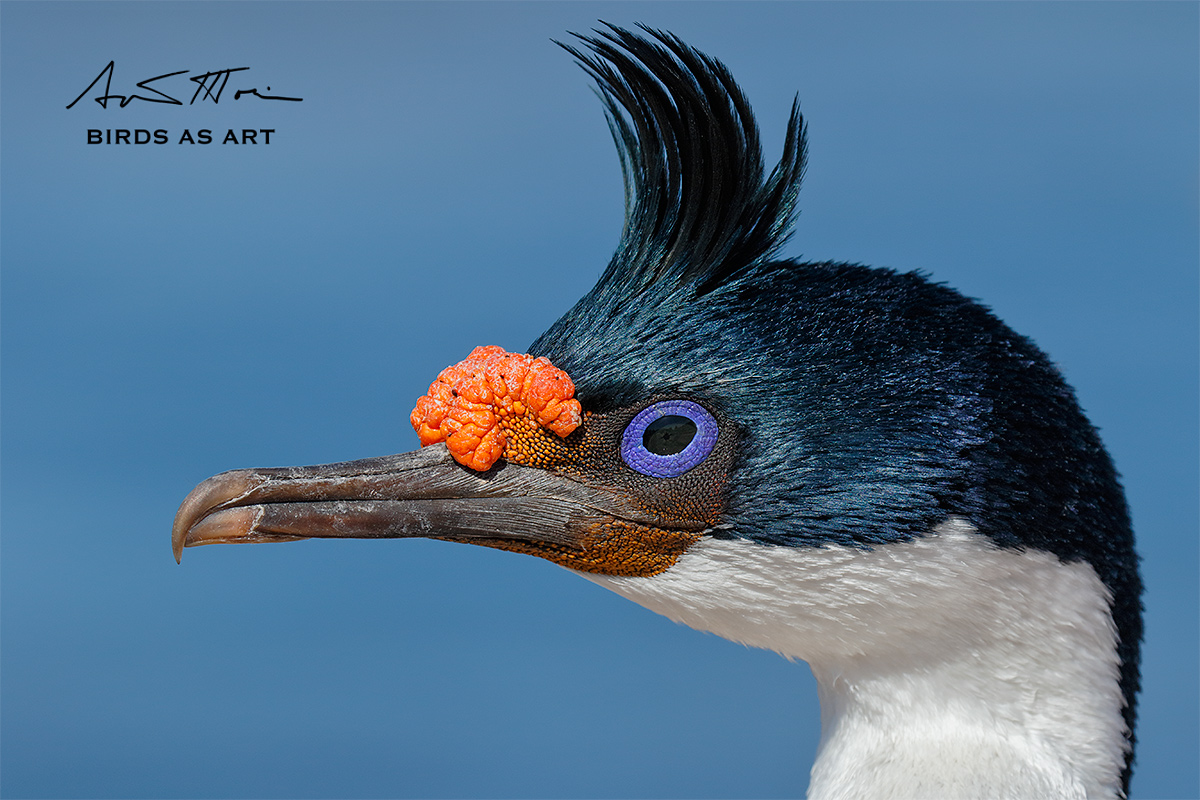
|
|
This image was created on Bleaker Island, the Falklands, with the hand held Canon EF 100-400mm f/4.5-5.6L IS II USM lens (at 401mm), the the Canon Extender EF 1.4X III, and the amazing Canon EOS 7D Mark II. ISO 400. Evaluative metering -1/3 stop: 1/1000 sec. at f/10.
Center AF point (by necessity at f/8)/AI Servo Expand/Rear Focus AF as framed was active at the moment of exposure (as is always best when hand holding). The center AF point was just forward of and above the bird’s eye. Click here to see the latest version of the Rear Focus Tutorial. Click on the image to see a larger version.
Image #1: King Cormorant in sun, head portrait
|
King Cormorant’s Many Aliases
The cormorants of the Southern Ocean can be a confusing group. In different locations the local names for what are actually different species are often the same. Many species have several or even many different common names. On top of all that you can throw in the fact that the scientists often re-classify the varies species sometimes lumping them into a large super-species comprised of various races and then a year or two later splitting them into distinct species each with a given set of characteristics that often include various DNA markers. Whatever the state of the scientific species mumbo jumbo, each then-agreed-upon species has it own distinct scientific (Latin) name that always includes both the genus name and the species name. Sometimes a subspecific Latin name is added to form a trinomial species name.
The bird in today’s featured image is most commonly called King Cormorant in the Falklands where both of today’s images were created. Others might know the bird as King Shag, Imperial Cormorant, Imperial Shag, Blue-eyed Cormorant or Blue-eyed Shag.
You get the picture 🙂 In any case, today’s bird is Phalacrocorax atriceps.
|
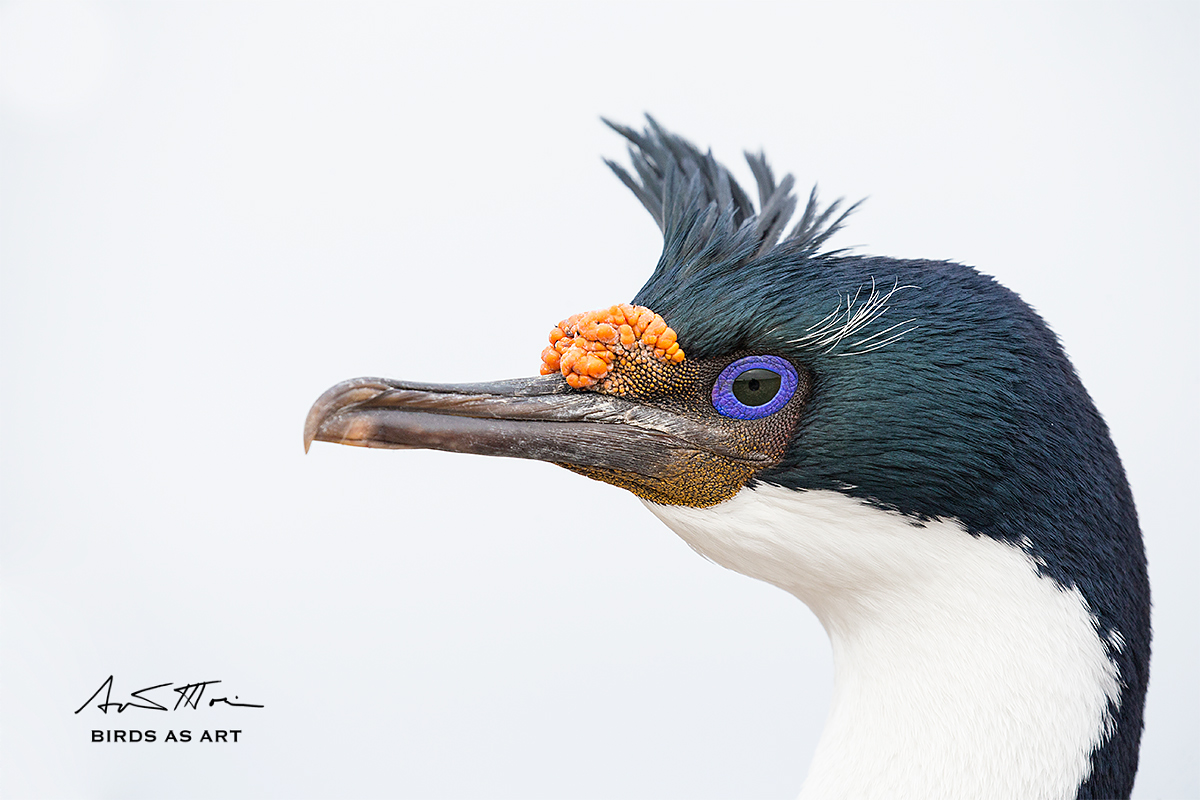
|
|
This image was created on Bleaker Island, the Falklands with the hand held Canon EF 100-400mm f/4.5-5.6L IS II USM lens (at 400mm) and the rugged professional body, the Canon EOS-1D X. ISO 800. Evaluative metering +2 stops as framed: 1/500 sec. at f/8 in Manual mode. Cloudy WB.
A single AF point (Manual selection) was two AF points to the right of the center AF point: AI Servo/Rear Focus AF as framed was active at the moment of exposure (as is always best when hand holding). The active AF point was right on the birds’s eye. Click here to see the latest version of the Rear Focus Tutorial. Click on the image to see a larger version.
Image #2: High key King Cormorant head portrait on white sky day.
|
King Cormorant: Sun versus White Sky
Please leave a comment and let us know if you like the bright sun version, Image #1, or the high key/white sky version, Image #2. And be sure to let us know why. Which image features the nicest light? Which image features the nicest pose?

Induro $50 Instant Rebate
The Induro $50 instant rebate will last only until the end of this year. Click on the logo-link above to save $50 on our favorite tripods. On our recent grueling trip to the Southern Ocean Denise loved her new GIT 304 and I love my new GIT 304L. Both performed flawlessly in the mud, snow and ice.
Induro GIT 404L Super Sale!
For a limited time only the Induro GIT 404L is being offered for the ridiculously low price of $470 (including the $50 instant rebate). The Induro GIT 404L is a 4-leg section Grand Series tripod. It is slightly bigger and one pound heavier than the GIT 304L; it is the perfect tripod for those using big glass who would like a bit more stability.

Gura Gear Backpack Blowout
I do not use a backpack. But many of my and denise’s clients who do have long raved about the Guru Gear backpacks. As have many professionals. These great photo backpacks are being phased out and will not be replaced in their present form. Take advantage of the huge price reductions on three popular models, the Bataflae 26L, the Bataflae 32L, and the Bataflae 18L, and enjoy a superbly high quality backpack that with its sturdy, high end zippers and durable fabric will serve you well for many years.
Facebook
Be sure to like and follow BAA on Facebook by clicking on the logo link upper right. Tanks a stack!


Support the BAA Blog. Support the BAA Bulletins: Shop B&H here!
We want and need to keep providing you with the latest free information, photography and Photoshop lessons, and all manner of related information. Show your appreciation by making your purchases immediately after clicking on any of our B&H or Amazon Affiliate links in this blog post. Remember, B&H ain’t just photography!
Amazon.com
Those who prefer to support BAA by shopping with Amazon may click on the logo-link immediately above.
Amazon Canada
Many kind folks from north of the border, eh, have e-mailed stating that they would love to help us out by using one of our affiliate links but that living in Canada and doing so presents numerous problems. Now, they can help us out by using our Amazon Canada affiliate link by starting their searches by clicking here. Many thanks to those who have written.
Typos
In all blog posts and Bulletins, feel free to e-mail or to leave a comment regarding any typos or errors. Just be right :).
November 20th, 2015 The Credit Line Signature…
Several folk have recently asked about my new signature. The short answer is that I have long been remiss about protecting my images. The rest is a long story that I will pass on for now. Thanks to denise ippolito for helping me create my signature brush. I am not sure but she may have a tutorial on how to do it somewhere on her blog here.
Enjoy the Blog?
Do you enjoy reading the blog? Do you learn something on most visits? Are you all set as far as gear goes? If yes to all of those, please consider making a BAA Blog Thank You Donation by clicking here. And if you do need some new gear, please use my affiliate links, most especially, the B&H affiliate logo link just to the right of this text. Simply click and begin your search and shopping spree :). Note: web orders only. Also, there will be no indication that your purchases will be tracked to BAA. The tracking is invisible. That’s why we ask folks to send us their B&H receipts for major purchases via e-mail. Please remember: no phone orders…. Many thanks for considering these requests. a
ps: think that I am being too cheeky? I put in about 15 to 30 hours per week on the blog; it is my part time job 🙂
What’s Up?
I began work on this blog post somewhere in the Southern Ocean. As I finished it up on Thursday morning, my relapse-cold has gotten a bit worse with the addition of some nasal congestion 🙂 Once this is finished I will start packing. Tomorrow I fly to Bosque.
Bosque #2
With just two openings left, we are raising the later registration discount to $200. See yesterday’s blog post for details. Then call Jim or Jen in the office at 863-692-0906 tomorrow to register. Time is short. And so is life 🙂

Induro $50 Instant Rebate
The Induro $50 instant rebate will last only until the end of this year. Click on the logo-link above to save $50 on our favorite tripods. On our recent grueling trip to the Southern Ocean Denise loved her new GIT 304 and I love my new GIT 304L. Both performed flawlessly in the mud, snow and ice.
Induro GIT 404L Super Sale!
For a limited time only the Induro GIT 404L is being offered for the ridiculously low price of $370 (including the $50 instant rebate). The Induro GIT 404L is a 4-leg section Grand Series tripod. It is slightly bigger and one pound heavier than the GIT 304L; it is the perfect tripod for those using big glass who would like a bit more stability.

Gura Gear Backpack Blowout
I do not use a backpack. But many of my and denise’s clients who do have long raved about the Guru Gear backpacks. As have many professionals. These great photo backpacks are being phased out and will not be replaced in their present form. Take advantage of the huge price reductions on three popular models, the Bataflae 26L, the Bataflae 32L, and the Bataflae 18L, and enjoy a superbly high quality backpack that with its sturdy, high end zippers and durable fabric will serve you well for many years.
|
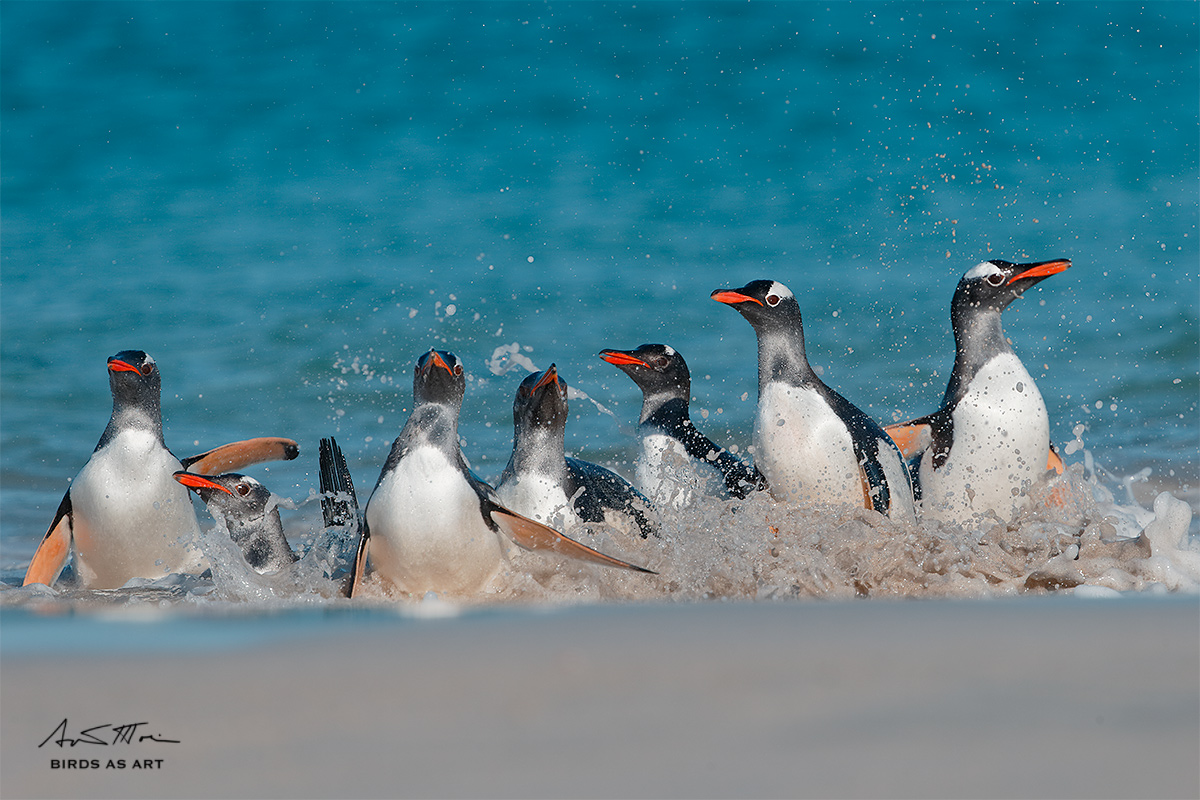
|
|
This image was created on Bleaker Island, on our first-ever land-based Falklands tour, with the Induro tripod/Mongoose M3.6 -mounted Canon EF 400mm f/4 DO IS II USM lens, the Canon Extender EF 1.4X III, and the rugged professional body, the Canon EOS-1D X. ISO 640. Evaluative metering at zero: 1/2500 sec. at f/7.1 in Manual mode. AWB WB.
Center AF point/AI Servo Expand/Rear Focus AF as originally framed was active at the moment of exposure. Click here to see the latest version of the Rear Focus Tutorial. Click on the image to see a larger version.
Image #1: Group of Gentoo Penguins emerging from surf
|
Emerging Gentoo Penguins
Though it was the afternoon of our first full day both denise and I knew exactly where we needed to be. We sat in the soft sand and watched as hundreds of gentoos emerged from the surf after a few hours of foraging for krill (if foraging is the correct word….) We carefully went over the details of exposure and AF point selection with Billie and Brian Snell.
Depth-of-Field
As originally framed, the active AF point fell on the neck band of the third penguin from your right. This bird was back a bit from the others in the group. Why were all the bird’s rendered sharp at the relatively wide aperture of f/7.1?
|
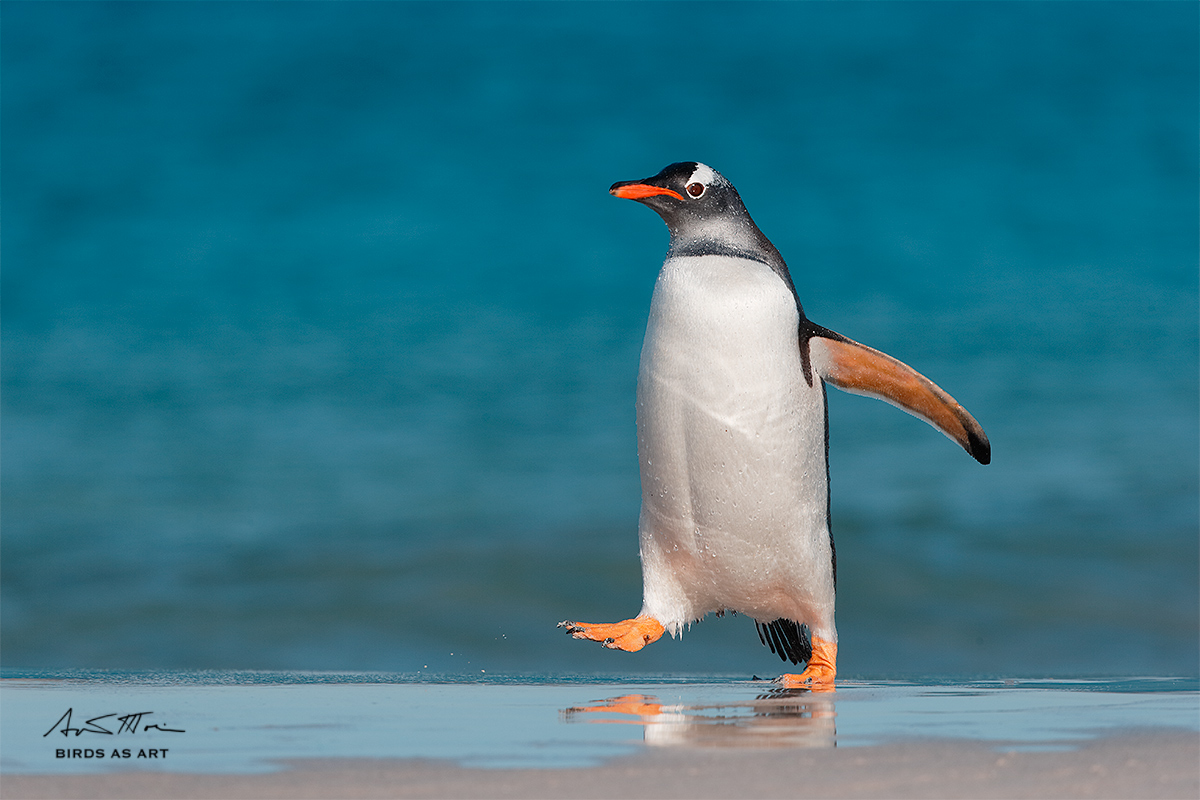
|
|
This image was also created on Bleaker Island, on our first-ever land-based Falklands tour, with the Induro tripod/Mongoose M3.6 -mounted Canon EF 400mm f/4 DO IS II USM lens, the Canon Extender EF 1.4X III, and the rugged professional body, the Canon EOS-1D X. ISO 640. Evaluative metering at zero: 1/2500 sec. at f/7.1 in Manual mode. AWB WB.
Center AF point/AI Servo Expand/Rear Focus AF as originally framed was active at the moment of exposure. Click here to see the latest version of the Rear Focus Tutorial. Click on the image to see a larger version.
Image #2: Striding Gentoo Penguin emerging from surf
|
AI Servo Compositional Tip: Leading the subject…
When you are using center AF point Expand or Surround AI Servo AF to track a subject and the bird is moving from one side of the frame to the other, you can often effectively move the bird back in the frame without having to manually move the active AF point by trying the following: acquire AF with the active AF point squarely on the subject (and preferably on a spot with sufficient contrast to allow AF to function efficiently); pan with the moving subject doing your best to match your panning rate with the speed of the subject; and finally, just as you anticipate the perfect image speed up your pan just a bit so that you are panning a bit faster than the subject is moving and release the shutter button just before the AF system begins to search for the background. At times one of the assist points may grab the edge of the subject while at other times no active AF point is on the subject at the moment of exposure.
The idea, as seen in the image immediately above, is to move the bird back just a bit in the frame so that you wind up with a more pleasing composition. As always, practice improves results.
|
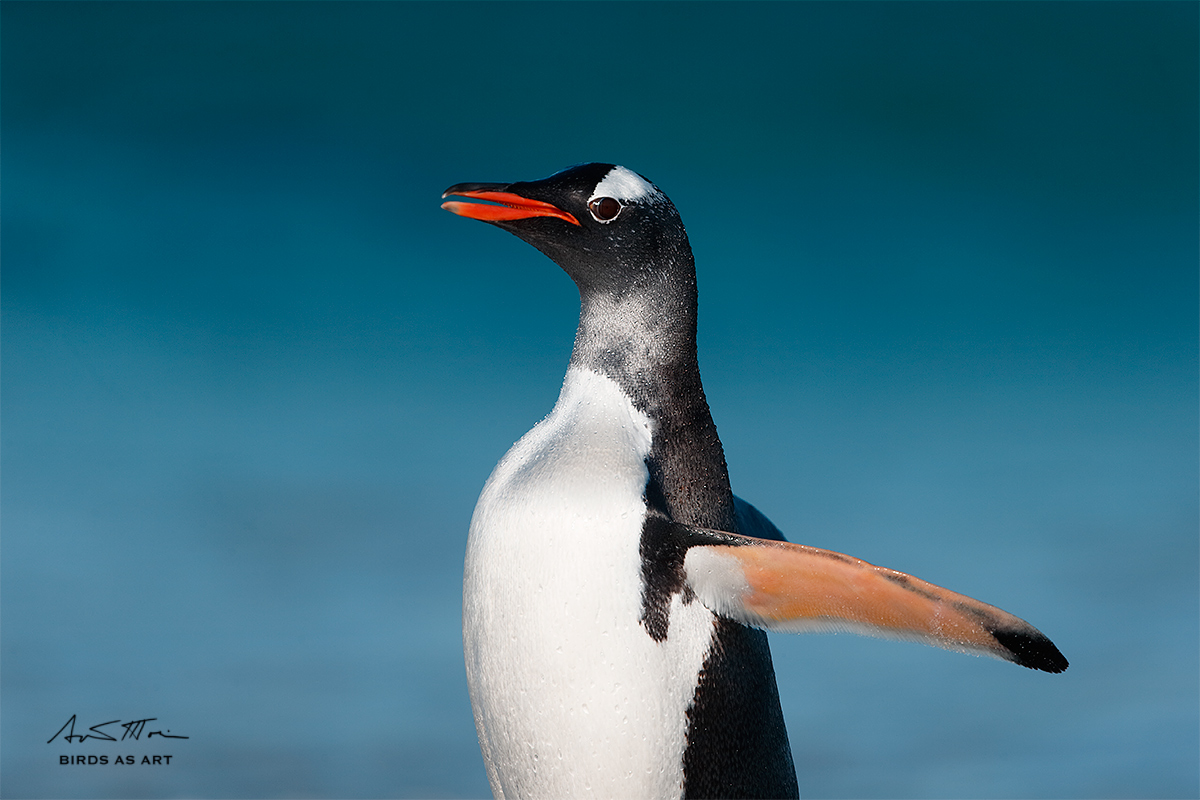
|
|
This image too was created on Bleaker Island, on our first-ever land-based Falklands tour, with the Induro tripod/Mongoose M3.6 -mounted Canon EF 400mm f/4 DO IS II USM lens, the Canon Extender EF 1.4X III, and the rugged professional body, the Canon EOS-1D X. ISO 640. Evaluative metering at zero: 1/2500 sec. at f/6.3 in Manual mode. AWB WB.
Center AF point/AI Servo Expand/Rear Focus AF as originally framed was active at the moment of exposure. Click here to see the latest version of the Rear Focus Tutorial. Click on the image to see a larger version.
Image #3: Tight image of flapping Gentoo Penguin emerging from surf
|
Worth a Try…
At times, the gentoos would walk by right in front of us on their way bak to the colony–right down sun angle–with a nice blue ocean background. In this situation, I tried getting some images of the upper half of their body with the wings raised. In this image, I succeeded to some degree.
Could have been better…
What was the only thing about Image #3 that disappointed me?
Why Not?
Why would Image #3 not have worked as a vertical?
Working a Situation
Note that all three of today’s featured images were of Gentoo Penguins, were made in similar lighting conditions, and were made with the same focal length: 560mm. Yet each image is distinctly different. In fact, one might say that the only thing similar about the three is the subject.
Zoom lenses are often a great help when it comes to working a subject or a situation, but the same can me done with a fixed focal length by working birds at different distances or by changing your position–the latter know as human zoomin’. Many times when we are teaching we will ask to see a student’s images on their rear LCD. We are always amazed when folks show us a single image of this flower or a single image or that bird… When you are in a great place (or in your backyard as well) resist the urge to take one image of a given subject and think, “I got it.” Learn to work a situation, to work the subject. Explore different distances and different perspectives. And be sure to make lots of images.
Facebook
Be sure to like and follow BAA on Facebook by clicking on the logo link upper right. Tanks a stack!


Support the BAA Blog. Support the BAA Bulletins: Shop B&H here!
We want and need to keep providing you with the latest free information, photography and Photoshop lessons, and all manner of related information. Show your appreciation by making your purchases immediately after clicking on any of our B&H or Amazon Affiliate links in this blog post. Remember, B&H ain’t just photography!
Amazon.com
Those who prefer to support BAA by shopping with Amazon may click on the logo-link immediately above.
Amazon Canada
Many kind folks from north of the border, eh, have e-mailed stating that they would love to help us out by using one of our affiliate links but that living in Canada and doing so presents numerous problems. Now, they can help us out by using our Amazon Canada affiliate link by starting their searches by clicking here. Many thanks to those who have written.
Typos
In all blog posts and Bulletins, feel free to e-mail or to leave a comment regarding any typos or errors. Just be right :).
November 19th, 2015 Enjoy the Blog?
Do you enjoy reading the blog? Do you learn something on most visits? Are you all set as far as gear goes? If yes to all of those, please consider making a BAA Blog Thank You Donation by clicking here. And if you do need some new gear, please use my affiliate links, most especially, the B&H affiliate logo link just to the right of this text. Simply click and begin your search and shopping spree :). Note: web orders only. Also, there will be no indication that your purchases will be tracked to BAA. The tracking is invisible. That’s why we ask folks to send us their B&H receipts for major purchases via e-mail. Please remember: no phone orders…. Many thanks for considering these requests. a
ps: think that I am being too cheeky? I put in about 15 to 30 hours per week on the blog; it is my part time job 🙂
What Was Up?
The text immediately below was written on the morning of Thursday, November 5, 2015 while I was on the Ortelius somewhere off South Georgia.
After a rough, nearly 3 day crossing from The Falklands to South Georgia–can you say Force 10 Gale?, we made our first landing at Undine Harbor, South Georgia on the afternoon of Wednesday, November 4. As I work on this blog post, the wind is still howling and the snow is still blowing. Our Thursday morning landing has been canceled due to the harsh conditions and we have pulled anchor and set sail back to Elsehul in hopes of landing early this afternoon and making the climb up to see some nesting Grey-headed Albatrosses.
Our first landing was very wet and very cold, with most folks soaked with icy seawater both on the ride into our landing and the ride back to the ship. Only those with the heaviest duty raingear did not have to hang everything in their cabins in an attempt to dry out them out overnight. Neither denise nor I were in that group (even though her outer shell cost more then $300.) I am happy to report that–with the help of a scopalamine patch, denise survived the crossing in fine fashion. As for me, I have not–knock on wood–gotten seasick since I worked on Ron Grandinetti’s charter boat out of Montauk, Long Island for 17 days in the mid-1970s after getting laid off from teaching. My writing career had begun just before that writing stories for the weekly rag, “The Long Island Fisherman.”
What’s Up Now?
I am feeling a lot better today. Tomorrow is packing day. I fly to Albuquerque on Friday and meet denise at the airport just before dinner. After a morning of scouting we meet the 1st Bosque group late on Saturday.
Note: after the rough start and some harsh weather for the first few days (as noted above) things calmed down nicely and the Cheesemans’ OCT 2015 South Georgia Expedition was a huge success for all who were fortunate enough to be aboard.
Bosque #2
With just two openings left, we are raising the later registration discount to $200. See yesterday’s blog post for details. Then call Jim or Jen in the office at 863-692-0906 tomorrow to register. Time is short. And so is life 🙂

Induro $50 Instant Rebate
The Induro $50 instant rebate will last only until the end of this year. Click on the logo-link above to save $50 on our favorite tripods. On our recent grueling trip to the Southern Ocean Denise loved her new GIT 304 and I love my new GIT 304L. Both performed flawlessly in the mud, snow and ice.
Induro GIT 404L Super Sale!
For a limited time only the Induro GIT 404L is being offered for the ridiculously low price of $470 (including the $50 instant rebate). The Induro GIT 404L is a 4-leg section Grand Series tripod. It is slightly bigger and one pound heavier than the GIT 304L; it is the perfect tripod for those using big glass who would like a bit more stability.

Gura Gear Backpack Blowout
I do not use a backpack. But many of my and denise’s clients who do have long raved about the Guru Gear backpacks. As have many professionals. These great photo backpacks are being phased out and will not be replaced in their present form. Take advantage of the huge price reductions on three popular models, the Bataflae 26L, the Bataflae 32L, and the Bataflae 18L, and enjoy a superbly high quality backpack that with its sturdy, high end zippers and durable fabric will serve you well for many years.
|
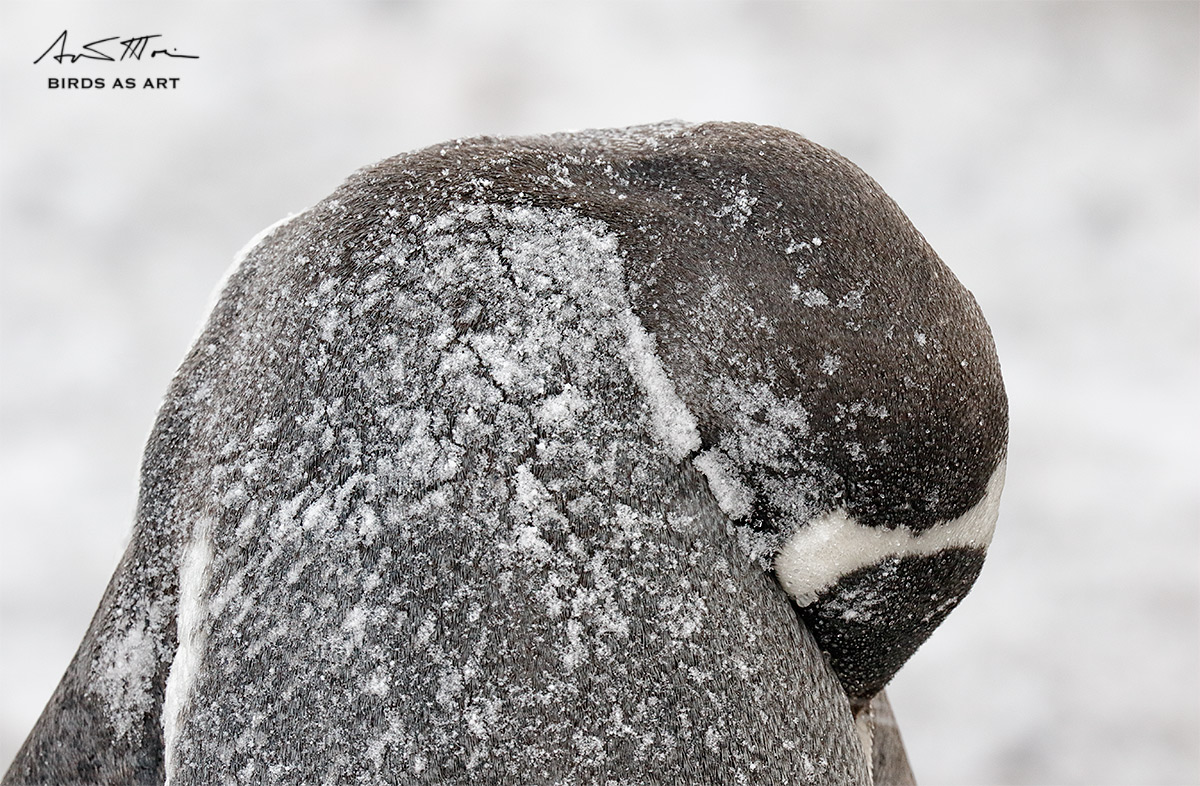
|
|
This image was created at Undine Harbor, South Georgia with the hand held Canon EF 100-400mm f/4.5-5.6L IS II USM lens (at 371mm) and the rather amazing Canon EOS 7D Mark II. ISO 800. Evaluative metering +1 stop as framed: 1/125 sec. at f/8 (was nearly a one stop underexposure).
One AF point below and one to the right of the center AF point/AI Servo Expand/Rear Focus AF as framed was active at the moment of exposure (as is always best when hand holding). Click here to see the latest version of the Rear Focus Tutorial. Click on the image to see a larger version.
Image #1: Gentoo Penguin sleeping on nest during snow squall
|
Capturing the Essence: It’s a Tough Life…
Sometimes a single image can tell a whole story. This simple, graphic image succinctly tells the story of our first South Georgia landing. Denise first spotted this subject and created a wonderful image of the whole bird by working a bit wide and placing the sleeping penguin in the upper left of a vertical frame (thus putting more emphasis on the mud nest than I did with my similar images). I helped her by suggesting that she get closer and a higher so as to place the penguin’s head against a background of white snow rather than black mud. When she was done I moved in a bit closer and created today’s featured image. Teamwork is a wonderful thing.
You can see denise’s stunning wider version of today’s featured subject in her South Georgia trip report blog post by clicking here. It is the fourth of 33 wonderful images. All are invited to leave a comment there or here and let me know your favorite denise image from the trip. See especially the two creatively filtered images at the bottom of the post.
|
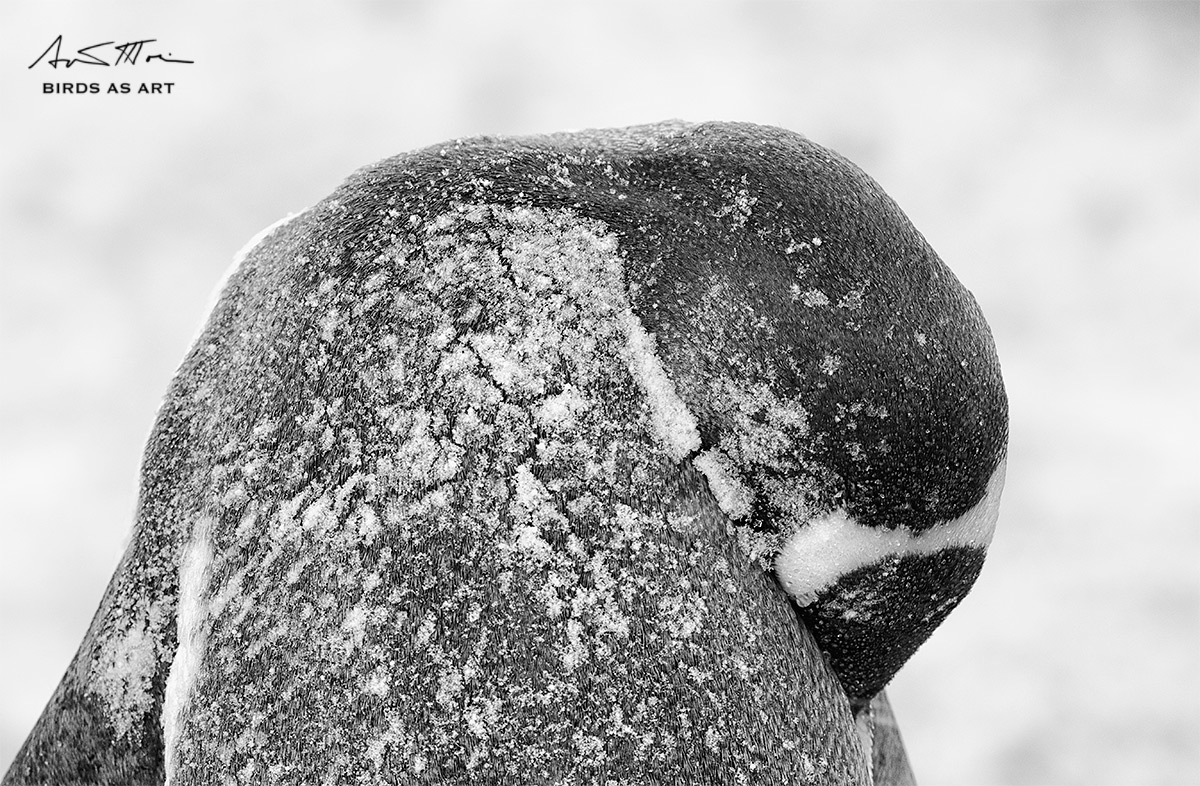
|
|
This NIK Silver Efex Pro version was created from the image that opened this blog post.
Image #2: NIK Silver Efex Pro Full Dynamic Smooth version of Gentoo Penguin sleeping on nest during snow squall
|
NIK Silver Efex Pro Full Dynamic Smooth
While the original image that opens this blog post did not show much color, there are significant red tones in the black feathers. When I wish to create a black and white version I bring the image into Silver Efex Pro and try the pre-sets that look as if they might have potential. With this image, Full Dynamic Smooth was the clear choice for me.
Your Favorite?
Please take a moment to leave a comment and let us know if you prefer the color version or the B&W version. And do of course let us know why you made your choice.
Facebook
Be sure to like and follow BAA on Facebook by clicking on the logo link upper right. Tanks a stack!


Support the BAA Blog. Support the BAA Bulletins: Shop B&H here!
We want and need to keep providing you with the latest free information, photography and Photoshop lessons, and all manner of related information. Show your appreciation by making your purchases immediately after clicking on any of our B&H or Amazon Affiliate links in this blog post. Remember, B&H ain’t just photography!
Amazon.com
Those who prefer to support BAA by shopping with Amazon may click on the logo-link immediately above.
Amazon Canada
Many kind folks from north of the border, eh, have e-mailed stating that they would love to help us out by using one of our affiliate links but that living in Canada and doing so presents numerous problems. Now, they can help us out by using our Amazon Canada affiliate link by starting their searches by clicking here. Many thanks to those who have written.
Typos
In all blog posts and Bulletins, feel free to e-mail or to leave a comment regarding any typos or errors. Just be right :).
November 18th, 2015 What’s Up
I spent most of Tuesday answering e-mails, working on our 2016 land-based Falklands IPT arrangements, gargling, resting, breathing Vicks Vapo Rub steam, and doing diluted iodine face dips.

Induro $50 Instant Rebate
The Induro $50 instant rebate will last only till 2016. Click on the logo-link above to save $50 on our favorite tripods. On our recent grueling trip to the Southern Ocean Denise loved her new GIT 304 and I love my new GIT 304L. Both performed flawlessly in the mud, snow and ice.
Selling Your Used Photo Gear Through BIRDS AS ART
Selling your used (or like-new) photo gear through the BAA Blog or via a BAA Online Bulletin is a great idea. We charge only a 5% commission. One of the more popular used gear for sale sites charges a minimum of 20%. Plus assorted fees! Yikes. The minimum item price here is $500 (or less for a $25 fee). If you are interested please e-mail with the words Items for Sale Info Request cut and pasted into the Subject line :). Stuff that is priced fairly–I offer free pricing advice, usually sells in no time flat. In the past few months, we have sold just about everything in sight. Do know that prices on some items like the EOS-1D Mark IV, the old Canon 500mm, the EOS-7D, and the original 400mm IS DO lens have been dropping steadily.
Canon EF 24-70mm f/2.8L II USM Lens
Another Lowest-ever BAA Price!
Price Reduced $100 on NOV 18, 2015.
Erik Hagstrom is offering a used Canon EF 24-70mm f/2.8L II USM lens in excellent condition for $1425. The sale includes the lens hood (EW-88C), the front and rear Canon lens caps, the original lens case LP1219, the instruction manual, both US & Canada warranty cards, the original box (less the UPC code that was used for a rebate), and insured shipping via FED-EX Ground. Your item will not ship until your check clears unless other arrangements are made.
Please contact Erik by e-mail or by phone at 206-999-1507 (Pacific time).
The new 24-70 II is a favorite of all serious landscape photographers. artie
That’s a stupid business strategy…
Here is an e-mail that I sent to long-time friends and clients, Pat and Stokes Fishburne:
AM: Hi Pat and Stokes, Hope that all is well. I am on the way home from the penguins!
re:
PF: As you may remember, I had to leave the beach on our last day of photography at Ft. DeSoto because I was in such pain that I could barely walk. After months of MRIs and x-rays, they told me that it’s my back — which causes referred pain in my right thigh and right ankle.
AM: Sounds like a visit to Dr. Oliver might be in order. Why? Because it sounds like the doctors have no clue 🙂 But heck, we are all getting older by the second and that can be a big painful challenge. I said to denise on the ship last week, “I don’t really feel bad because so many different things hurt that I am not concentrating on any one thing….”
PF: So, the dreaded day has come when I have to consider lighter equipment.
AM: Been there, done that.
PF: I currently have a 500mm lens and a 400 DO lens. You have raved so much about the 400 DO II that I’m thinking about selling my two large lenses (the old 500 and the 400 DO) and getting the new 400mm DO II. What do you think?
AM: The basic plan is good but for one big but. The 400 DO II is much sharper than the old ones with and without TCs. But, see the Big But below…. The 400 DO II is a great lens; with the TCs it gives me either 560mm or 800mm full frame in a fairly light package. Times 1.6 if I go with the 7D II. And selling prices for the both the old 400 DO and the old 500 continue to drop….
Big But: the 400 DO II is actually a bit heavier than the original 400 DO. At 4.28 pounds it is not light. And it is pretty bulky. So where I am going? Do you have the 100-400 II? It is amazing. It is much lighter and smaller than the 400 DO II. With the 7D II on the Mongoose with the 100-400 II and the 1.4X III TC you will have an effective focal length of 400 X 1.4 X 1.6 = 896mm. Assuming that you will be using my B&H links as you and Stokes have always done, your purchasing one or two 100-400 IIs rather than one or two 400 DO IIs will mean a lot less in commissions for me but it just might be the very best choice for you…. There are times when a seemingly stupid business strategy: earning far less in commissions, can actually be the very smartest business strategy: making sure that folks get exactly would be best for them. I have long prided myself in not shilling for a product that I do not believe in or have not used and love that would make me lots of money…. There are others in this industry that will sell you anything to make a few bucks. And though you and Stokes have been dear friends for probably close to two decades–could it be that long, I feel the same way about all BAA customers. That why I am sharing our conversation here on the blog.
PF: Of course, I’d also want to up-grade to the 1.4 III and 2.0 III.
AM: If you go with the 100-400 II you would only need the 1.4X III TC. More lost commissions 🙂
PF: I have the 7D Mark II and 5D Mark III camera bodies. I am happy with them and, at this time, I don’t plan on upgrading them.
AM: Good plan. I love them both but am loving my 7D II more and more lately. See the Southern Ocean blog posts where I wound up using the 100-400 II/7D II much of the time, rarely going to the 400 DO II by the end of the 3 weeks and often leaving the 1D X in my cabin.
What would you gain with the 400 DO II? All AF points active at 560mm with the 1.4X III, 800mm of reach with the 2X III and the 5D III, and 1280 with the 2X III/7D II. And do not forget that the 400 DO II is a lot lighter than the old 500mm, 3.91 pounds lighter to be exact….
Your call. Below are all the links. Let me know which way you go and please of course do use my B&H links.
Later and love to you and to Stokes.
a
ps: for your convenience, the B&H affiliate links are below.
Canon EF 400mm f/4 DO IS II USM Lens
Canon EF 100-400mm f/4.5-5.6L IS II USM lens
Canon Extender EF 1.4X III
Canon Extender EF 2X III
Note: What is the price here for giving honest advice if Pat and Stokes wind up buying two 100-400 IIs and two 1.4X III TCs rather than two 400 DO IIs, two 1.4X III TCs, and two 2X III TCs? As best as I can figure: $359.04 in lost commissions. But the very best business strategy as far as I am concerned.
|
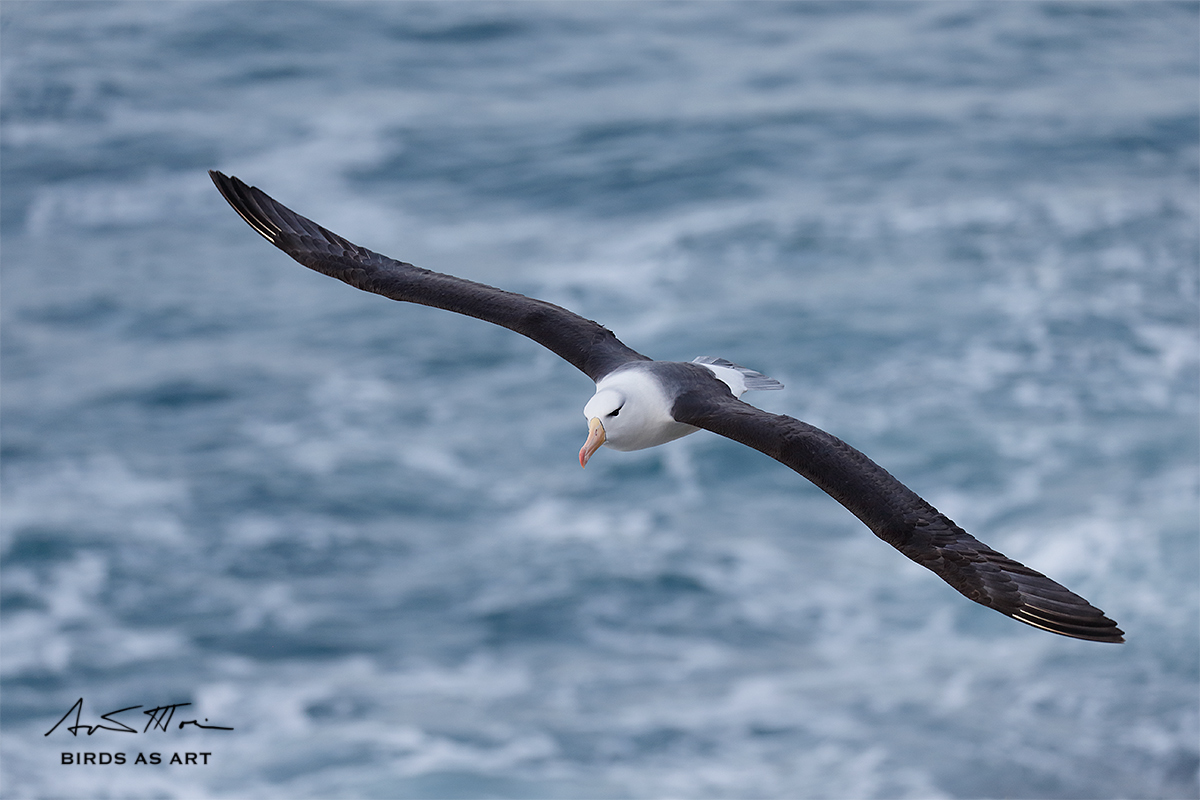
|
|
This image was created on Saunders Island on the first-ever land-based IPT with the hand held Canon EF 100-400mm f/4.5-5.6L IS II USM lens (at 255mm) and the rugged professional camera body, the Canon EOS-1D X. ISO 800. Evaluative metering +2 stops off the grey sky: 1/1600 sec. at f/5.6. AWB.
Center AF point/AI Servo Expand/Shutter Button AF as framed was active at the moment of exposure (as is always best when hand holding). The center AF point was squarely on the base of the bird’s bill. When working in pure flight situations I have gone back to using shutter button AF for more than a year. I still use rear button AF for most static subjects. Click on the image to see a larger version.
Black-browed Albatross in flight/Top Shot
|
More Love for the Canon 100-400 II
If I had been using the 400 DO/1D X combo when this bird flew by below eye level, I would have been dead in the water: I could not have fit those long thin wings into the horizontal frame. The more I used the 1-4 II on the two Southern Oceans trips, the more I fell in love with its reach, close focus, light weight, and versatility. As the South Georgia expedition went on, I rarely if ever brought the 400 DO on the landings, using it mostly for flight photography from the ship… Many times I would bring two camera bodies. I would use the 1D X with the 1-4 in low light and when the birds were at close range, and would use the 7D II in brighter conditions when I needed the additional reach. With either camera body adding a 1.4X TC when needed gave me additional reach with center AF point (Expand) AF active.
My Estimated Zoom Technique for Flight Photography
When using a zoom lens for flight photography, many folks acquire focus at the long end and slowly and continuously turn the zoom ring as the bird approaches and gets continually larger in the frame. I have tried that approach many times without much success. When I am using a zoom lens like the 100-400 II for flight, I use a technique that I developed and practice often. I named it “zoom out to estimated desired focal length.” I acquire focus at the long end, perhaps make an image or two at 400mm, and then, estimating the bird’s speed and course, zoom out quite a bit trying to anticipate where the best image will be. Then I let the bird fly to that spot where the framing will be ideal at my estimated focal length. As the bird flies right into my zone I depress the shutter button half way to reacquire focus and once the AF system begins to track, I press and hold the shutter button down to create one or two images. Today’s featured image is 100% full frame, a result of my perfectly estimating the zoomed out focal length at 255mm and properly reacquiring focus at just the right moment. Perfecting this technique takes practice. If you try it, leave a comment or shoot me an e-mail and let me know how you do.
|
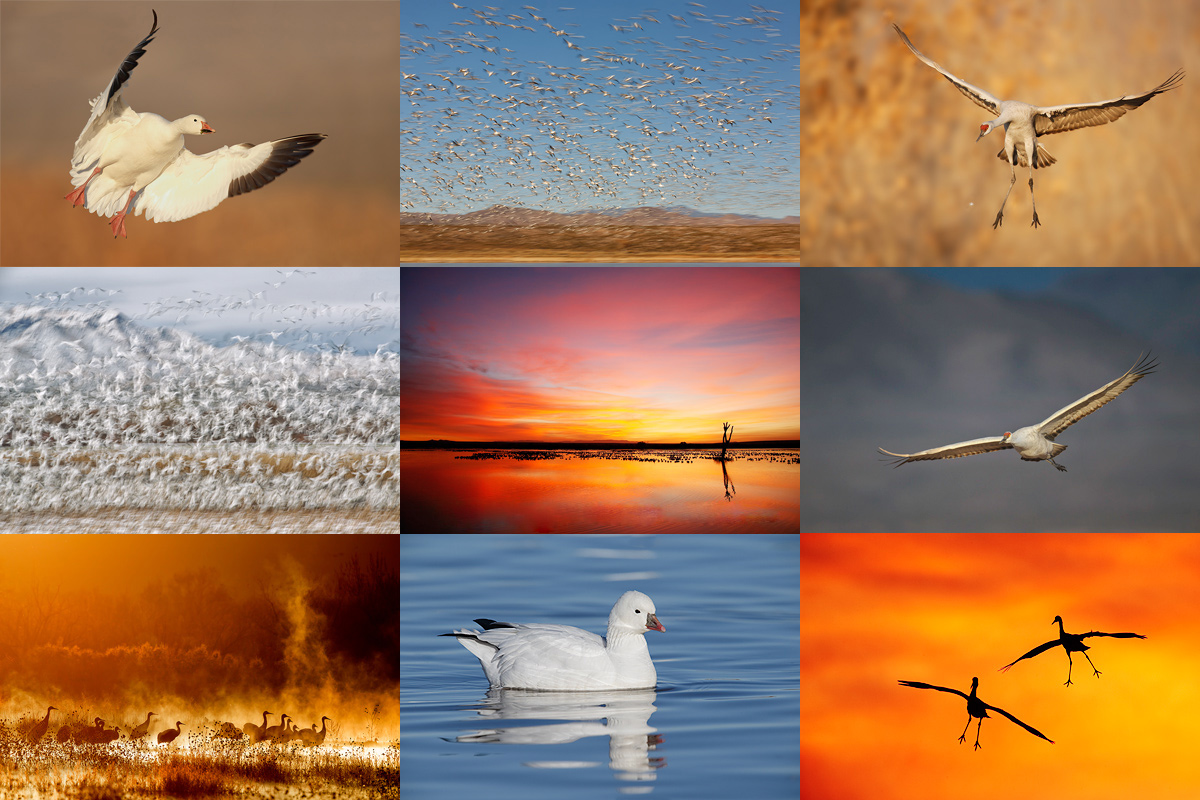
|
|
Bosque has been one of artie’s three soul places since he created two BBC-honored images there on his first visit in 1994.
|
Bosque del Apache 2015 BIRDS AS ART/A Creative Adventure Instructional Photo-Tour (IPT). 3-FULL DAY IPT: NOV 22-24, 2015. $1149. Two great leaders: Denise Ippolito and Arthur Morris. Meet and greet and introductory slide program after dinner on your own at 7:00pm on SAT NOV 21.
Sold Out with a waiting list.
In 2015, we are offering a 3-DAY IPT before Thanksgiving and a 4-DAY IPT after the holiday. The first has been sold out for a while. There is some room on the second. See below for details.
We know that there are lots of less costly workshops being offered these days. Many of them are downright cheap. Please remember that you get exactly what you pay for. With us you will have two full time pros there for you every minute we are in the field. Together they have more than 28 seasons of experience at the refuge. If you want the finest in photographic instruction and want to be assured of being in the right spot at exactly the right time every day, do join us.
|
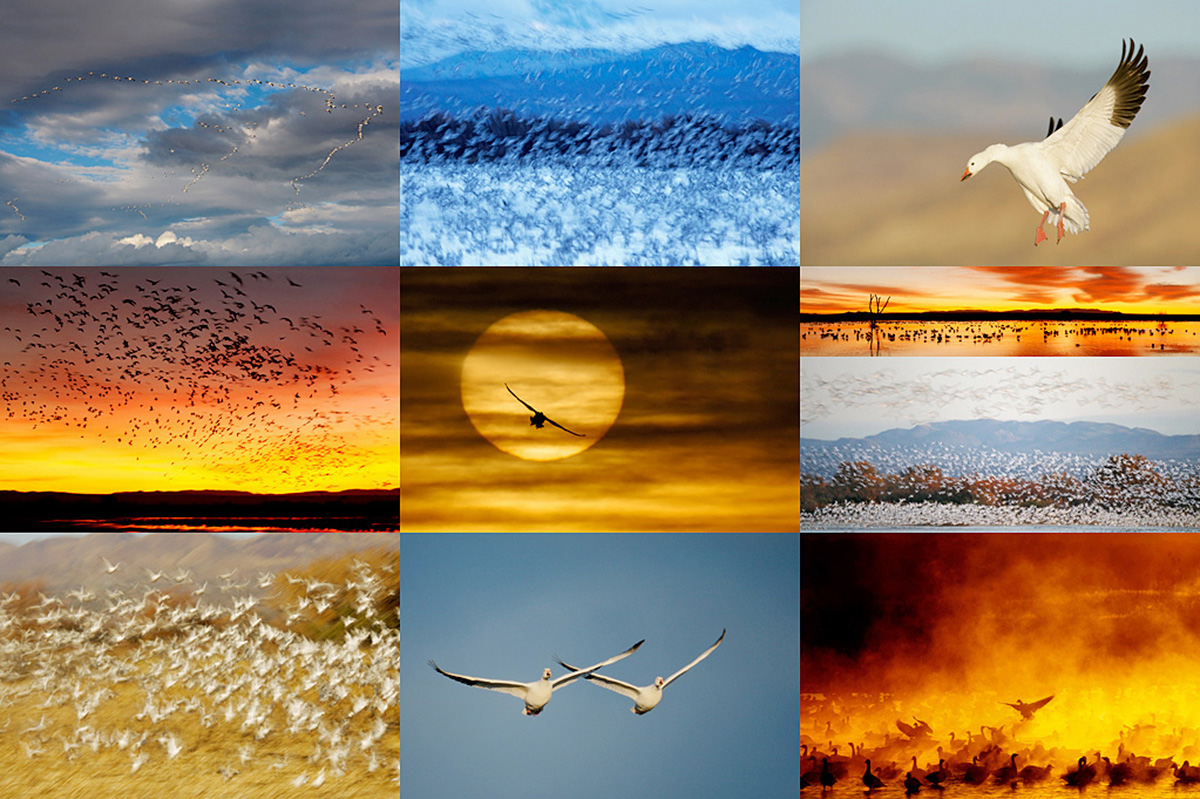
|
|
Bosque is a wondrous place.
|
Bosque del Apache 2015 BIRDS AS ART/A Creative Adventure Instructional Photo-Tour (IPT). 4-DAY IPT: (three full and two 1/2 DAYS) NOV 28-DEC 2, 2015. $1499. Two great leaders: Denise Ippolito and Arthur Morris. Meet and greet at 3pm on SAT NOV 28 followed by an afternoon photo session at the crane pools and the introductory slide program after dinner on your own.
Mention the blog and a $100 Late Registration Discount will be applied to your balance. Just 1 spot left.
Tens of thousands of Snow Geese, 10,000 Sandhill Cranes, ducks, amazing sunrises, sunsets, and blast-offs. Live, eat, and breathe photography with two of the world’s premier photographic educators at one of their very favorite photography locations on the planet. Top-notch in-the-field and Photoshop instruction. This will make 21 consecutive Novembers at Bosque for artie. This will be denise’s 7th workshop at the refuge. Nobody knows the place better than artie does. Join us to learn to think like a pro, to recognize situations and to anticipate them based on the weather, especially the sky conditions, the light, and the wind direction. Every time we make a move we will let you know why. When you head home being able to apply what you’ve learned on your home turf will prove to be invaluable.
This workshop includes 4 afternoon (11/28through 12/1), 4 morning (11/29 to 12/2) photography sessions, an inspirational introductory slide program after dinner on your own on Saturday, 11/28, all lunches, and after-lunch digital workflow, Photoshop, and image critiquing sessions.
There is never a strict itinerary on a Bosque IPT as each day is tailored to the local conditions at the time and to the weather. We are totally flexible in order to maximize both the photographic and learning opportunities. We are up early each day leaving the hotel by 5:30 am to be in position for sunrise. We usually photograph until about 10:30am. Then it is back to Socorro for lunch and then a classroom session with the group most days. We head back to the refuge at about 3:30pm each day and photograph until sunset. We will be photographing lots of Snow Geese and lots of Sandhill Cranes with the emphasis on expanding both your technical skills and your creativity.
A $599 non-refundable deposit is required to hold your slot for this IPT. Your balance, payable only by check, will be due on 7/25/2015. If you cancel and the trip fills, we will be glad to apply a credit applicable to a future IPT for the full amount less a $100 processing fee. If we do not receive your check for the balance on or before the due date we will try to fill your spot from the waiting list. Whether or not your spot is filled, you will lose your deposit. If not, you can secure your spot by paying your balance.
Please print, complete, and sign the form that is linked to here and shoot it to us along with your deposit check (made out to “Arthur Morris.”) You can also leave your deposit with a credit card by calling the office at 863-692-0906. If you register by phone, please print, complete and sign the form as noted above and either mail it to us or e-mail the scan. If you have any questions, please feel free to contact me via e-mail after July 29.
Facebook
Be sure to like and follow BAA on Facebook by clicking on the logo link upper right. Tanks a stack!


Support the BAA Blog. Support the BAA Bulletins: Shop B&H here!
We want and need to keep providing you with the latest free information, photography and Photoshop lessons, and all manner of related information. Show your appreciation by making your purchases immediately after clicking on any of our B&H or Amazon Affiliate links in this blog post. Remember, B&H ain’t just photography!
Amazon.com
Those who prefer to support BAA by shopping with Amazon may click on the logo-link immediately above.
Amazon Canada
Many kind folks from north of the border, eh, have e-mailed stating that they would love to help us out by using one of our affiliate links but that living in Canada and doing so presents numerous problems. Now, they can help us out by using our Amazon Canada affiliate link by starting their searches by clicking here. Many thanks to those who have written.
Typos
In all blog posts and Bulletins, feel free to e-mail or to leave a comment regarding any typos or errors. Just be right :).
November 17th, 2015 What’s Up?
Me. Early on Tuesday morning.
I arrived in Miami 30 minutes early on Monday morning at 4:45am. The 8 hour flight was not too bad. I lucked out by getting seat 30K on a big Boeing jetliner: emergency row with ten feet of bulkhead legroom and it even reclined! Many emergency row seats do not recline… Poor man’s first class. I probably slept more than 4 hours, most of it in one fell swoop. I did get up often to walk around and get some more water. And I did leg exercises when I was awake at my seat. If you missed the DVT (deep vein thrombosis) blog post that might save your life, be sure to check it out here.
After clearing customs and dropping my two checked bags at re-check, I was off in search of a McDonald’s for two breakfast burritos. And my gate. “There is a McDonald’s on the D Concourse” said the friendly TSA lady whom I had asked so I took the train partway (and then still had a very long walk to Gate D27). As it turned out, there was no Mickey D’s anywhere on the D concourse but I did see a huge sign on the way down the escalator from the train: Centurion Lounge: free with your Platinum AMEX card. Gate D12. So decided to head to it in search of a free breakfast.
Bingo! Spanish eggs with chicken. I added some slivered almonds, a tablespoon of craisons, and a dollop of sour cream. The only thing missing was a bit of salsa. But it was yummy and relatively healthy. What a pleasant surprise. See more below.
My flight to MCO was not until 10:30am so I hung out at the lounge and enjoyed the free internet. Jim met me as usual and after our customary stop at Publix we were home by 1pm. After lunch I napped and napped and napped. After my dinner salad I fell asleep on the couch in front of Monday night football. I officially got into bed at about 10:30 and slept yet another five hours. I no longer feel like a zombie. I fly to Bosque on Friday! We got two sign-ups the last two days but we still have room for one or two more. (As per the website we always reserve the right to go with one over the limit.) See more below.
Though I am still a bit congested I continue to feel fine 🙂

Induro $50 Instant Rebate
The Induro $50 instant rebate will last only till 2016. Click on the logo-link above to save $50 on our favorite tripods. On our recent grueling trip to the Southern Ocean Denise loved her new GIT 304 and I love my new GIT 304L. Both performed flawlessly in the mud, snow and ice.
|
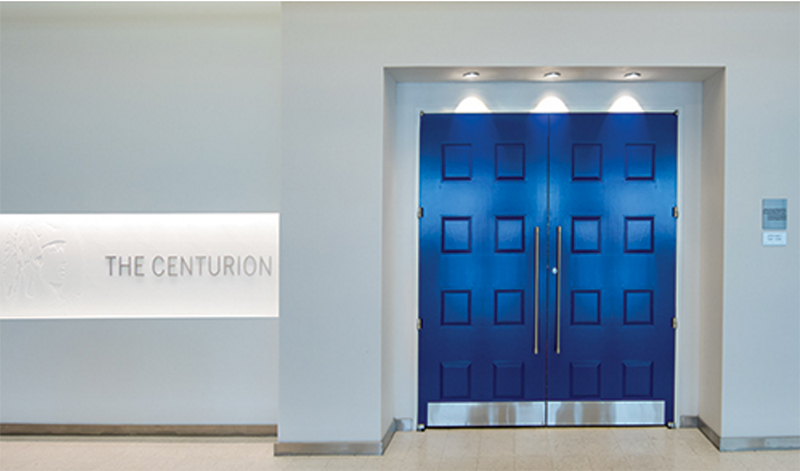
|
|
Finding an AMEX Centurion Lounge at MIA was a real treat. And free.
|
AMEX Centurion Lounges
From the LoungeBuddy website:
American Express offers some of the most diverse airport lounge benefits of any credit card issuer through its flagship Platinum Card®. A complimentary membership to Priority Pass™ Select opens the door at over 600 clubs worldwide, and you can also flash your Platinum Card to gain access to other lounges operated by Airspace and Delta Air Lines. But not everyone knows that American Express operates its own airport lounges and is expanding that network within the U.S.
The most recent attention has been given to the American Express Centurion Lounges, beginning with Las Vegas (Concourse D, served by United Airlines), Dallas/Fort Worth (Terminal D, served by American Airlines and international departures), New York-LaGuardia (Terminal B, Landside), San Francisco (Terminal 3 Concourse F, served by United Airlines), and Miami (North Terminal Concourse D, served by American Airlines). The Centurion Studio, an extension of the Centurion Lounge network in a smaller setting, is available in Seattle (Concourse B, served by Delta Air Lines, Southwest Airlines, and Virgin America). All lounges are located airside and can be accessed from other terminals via inter-terminal trains or walkways, with the exception of the LaGuardia location, which is before security.
Remember, passengers with a valid ticket may usually access other areas of the airport even if their flight uses a different terminal. Just be sure to leave time to exit and re-clear security before your departure!
The Centurion Lounges are truly a notch above most domestic U.S. lounges, which reflects their association with a premium card issuer like American Express. Guests can partake of a gourmet taco bar for breakfast and lunch at the 9,000-square-foot location in Dallas/Fort Worth as well as other rotating menu choices imagined by Chef Dean Fearing. Since the menus for each Centurion Lounge are designed by a different gourmet chef, guests will also be able to feast on the culinary delights of Scott Conant (in Las Vegas), Cedric Vongerichten (in New York-LaGuardia and San Francisco), and Michelle Bernstein (in Miami). Relax on one of the lounge chairs, catch up on work with the complimentary WiFi, or reserve the complimentary meeting room. A children’s room with video games and other toys is also available.
The most amazing thing about the Centurion Lounges is that all of these benefits are included in the entry fee, which is waived for Platinum and Centurion Cardholders. (Other American Express Cardholders must pay $50 per person.) Yes, that means even treatments at the Exhale Spa in Dallas/Fort Worth and Miami, providing chair massages, skin treatments, and manicures – all performed by excellent professionals.
You can learn more here.
|
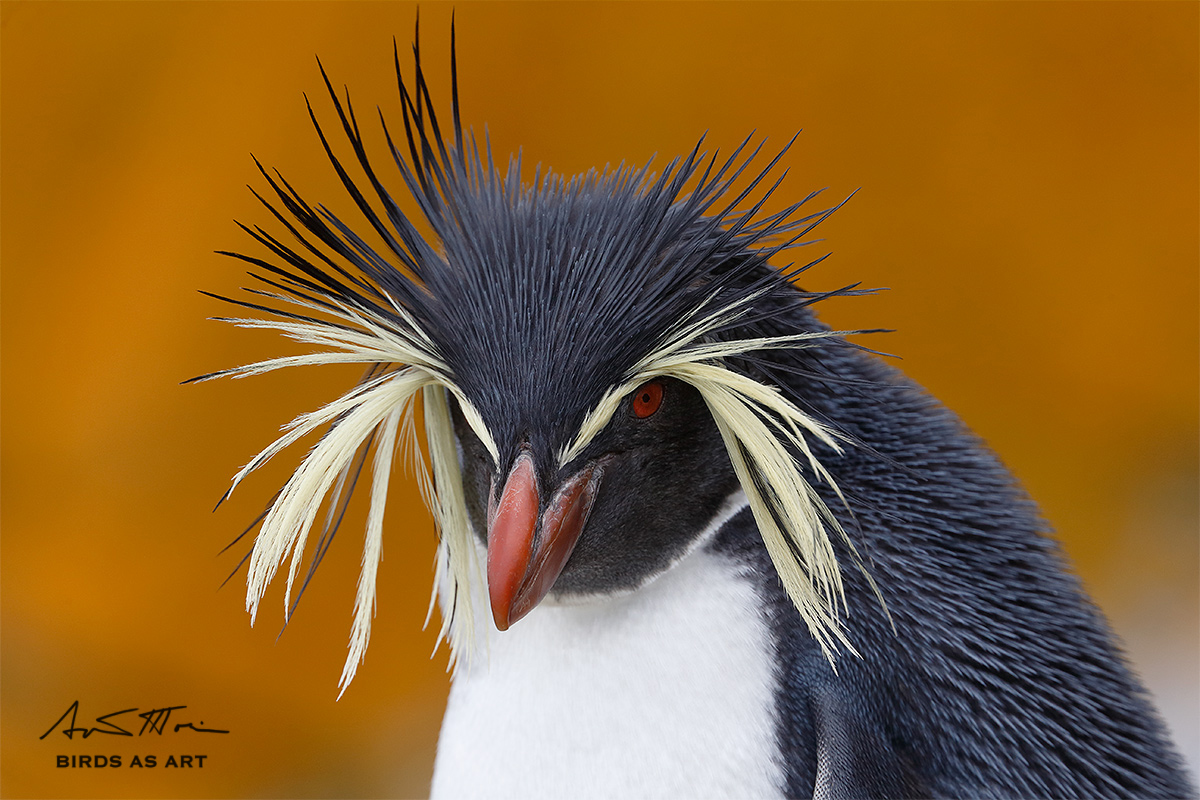
|
|
This image was created along the coast north of Stanley on East Falklands with the Induro tripod/Mongoose M3.6-mounted Canon EF 400mm f/4 DO IS II USM lens, the Canon Extender EF 1.4X III, and the rugged professional body, the Canon EOS-1D X. ISO 800. Evaluative metering +1/3 stop: 1/800 sec. at f/8 in Manual mode. Auto WB.
Center AF point/AI Servo Expand/Rear Focus AF as framed was active at the moment of exposure; the active AF point was just in front of the bird’s left eye. Click here to see the latest version of the Rear Focus Tutorial. Click on the image to see a larger version.
Moseley’s Rockhopper Penguin
|
A new species: Moseley’s Rockhopper Penguin
On our day trip out of Stanley on Saturday, October 31, we visited a really neat Rockhopper Penguin on the northern coast. The rookery was located on a rocky hillside with orange sea lichen (Caloplaca) in abundance. I spent the first hour using both my 25-105 and my 16-35mm f/4 L lens doing bird-scapes.
Our driver-guide for the day told us that there was a Northern Rockhopper Penguin in the rockhopper colony. We learned that this is a slightly larger version of the run of the mill rockhoppers with a much longer shaggy. Northern rockhopper nests on a speck of an island in the South Atlantic; Tristan da Cuhna that is actually closer to South Africa than it is to Brazil. After a while she spotted the bird and pointed it out to us. It was standing on a rock well up on the hillside. I had been using the 100-400 II and decided to go back to the truck for the 400 DO II and both teleconverters. The bird was still standing on the flat rock when I got back but as soon as I pointed the lens at it it decided to walk off its perch… I said to denise, who was using her 70-200 f/2.8L IS lens/2X III TT/7D II combo, “Let’s be patient.” So we were.
Our rock star penguin continued to play hard to get hiding behind this rock and that. We were thrilled when he walked back up to the flat rock above the colony. But, he immediately began kissing up on a female rockhopper below. Denise got one nice image out of that but with the 400 D0II/2X III/1D X combo I had way too much focal length and again came up empty. Then the bird walked right towards us and began to head downhill I was wishing that I had still had my 100-400 II… Denise was hand holding her outfit and was of course able to zoom in and out as needed. Though we were really scrambling in the fierce winds, fierce only if you consider gusts to 70mph to be fierce, denise made lots of excellent images. At risk of life and limb on the loose rocks, we managed to get downhill and ahead of the bird several times. I managed to switch the 2X III for the 1.4X III and was very happy to create today’s featured image with a distant orange/yellow lichen background.
I learned from Joe Kaplan on the ship that the Northern Rockhopper was very recently accorded full species status and is now called Moseley’s Rockhopper Penguin.
The Before and After Animated GIF
The before and after animated GIF above clearly shows the bill clean-up and the lightening of the eye and the shaded portion of the face, the latter which brings the image to life. The RAW file, which was converted in DDP 4, was well darker the converted TIFF. I move the very effective Shadow slider to +3 during the conversion.
Digital Basics
Nearly everything that I did to optimize today’s image is covered in detail in my Digital Basics File–written in my easy-to-follow, easy-to-understand style. Are you tired of making your images look worse in Photoshop? Digital Basics File is an instructional PDF that is sent via e-mail. It includes my complete digital workflow, dozens of great Photoshop tips, details on using all of my image clean-up tools, the use of Contrast Masks, several different ways of expanding and filling in canvas, all of my time-saving Keyboard Shortcuts, Quick Masking, Layer Masking, and NIK Color Efex Pro basics, Contrast Masks, Digital Eye Doctor techniques, using Gaussian Blurs, Tim Grey Dodge and Burn, a variety of ways to make selections, how to create time-saving actions, the Surface Blur (background noise reduction) settings and Brush Opacity Magic both taught to me by Denise Ippolito, and tons more.
APTATS I & II
Learn the details of advanced Quick Masking techniques in APTATS I. Learn Advanced Layer Masking Techniques in APTATS I. Mention this blog post and apply a $5 discount to either with phone orders only. Buy both APTATS I and APTATS II and we will be glad to apply at $15 discount with phone orders only. Please call Jim or Jennifer weekdays at 863-221-2372 to take advantage of this offer. I am pretty sure that we have extended that offer to the BAA Online Store as well…
|
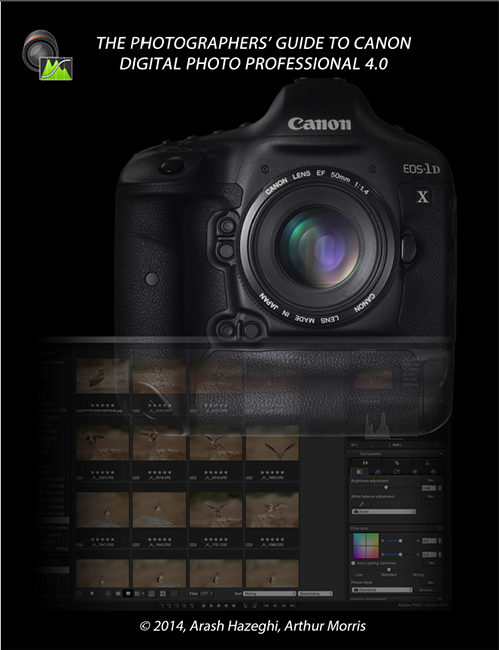
|
|
You can order your copy of “The Photographers’ Guide to Canon Digital Photo Professional 4.0” (aka the DPP 4 Raw Conversion eGuide) by Arash Hazeghi and Arthur Morris by clicking here.
|
The DPP 4 eGuide (PDF)
Learn how and why I and many other discerning photographers choose and use only DPP 4 to convert their Canon RAW files in the DPP 4 RAW Conversion Guide by Arash Hazeghi and yours truly. The latest version supports all of the newer Canon camera bodies and several older models including the EOS-7D and the EOS-1D Mark IV. The DPP IV Guide is the ideal companion to the 7D Mark II User’s Guide, a runaway best seller.
DPP 4 Kudos
From Richard Gollard via e-mail:
I have been doing tons of studying the books and PDFs that I have purchased from BIRDS AS ART. And I have to say that after reading the DPP 4 conversion guide that you did with Arash Hazeghi I tried DPP 4 and was blown away with the difference from the conversions that I made with Adobe Photoshop and Lightroom. Thanks for the consistently great information.
The DPP 4 eGuide (PDF) Updated for 1D Mark IV and the original 7D
The DPP 4 eGuide was recently updated to include the luminance and chrominance noise reduction values for both the 1D Mark IV and the original 7D. If you purchased your copy from BAA please e-mail Jim and request the DPP 4 1d IV/7D update. Please be sure to cut and paste page 1 into your e-mail as proof of purchase.
The Bosque Site Guide
If you can’t make or afford one of the two Bosque IPTs, be sure to get yourself a copy of our Bosque Site Guide. All BAA Site Guides are designed so that with a bit of study you can show up at a great place and know exactly where to be at what time on what wind and in what lighting conditions. And on what wind. With a Site Guide on your laptop you will feel like a 22-year veteran on your first visit. Site Guides are the next best thing to being on an IPT. If you plan on visiting Bosque it would be foolish to make the trip without having this guide in hand. Why spend money on gear and travel and then spend days stumbling around in the wrong spot? If you have visited previously, and are still unsure of where you should be at this time of day with that wind, this guide will prove invaluable to you as well. Even folks visiting Bosque for the tenth time will learn a ton as I share my secrets and hold nothing back….
|

|
|
Bosque has been one of artie’s three soul places since he created two BBC-honored images there on his first visit in 1994.
|
Bosque del Apache 2015 BIRDS AS ART/A Creative Adventure Instructional Photo-Tour (IPT). 3-FULL DAY IPT: NOV 22-24, 2015. $1149. Two great leaders: Denise Ippolito and Arthur Morris. Meet and greet and introductory slide program after dinner on your own at 7:00pm on SAT NOV 21.
Sold Out with a waiting list.
In 2015, we are offering a 3-DAY IPT before Thanksgiving and a 4-DAY IPT after the holiday. The first has been sold out for a while. There is some room on the second. See below for details.
We know that there are lots of less costly workshops being offered these days. Many of them are downright cheap. Please remember that you get exactly what you pay for. With us you will have two full time pros there for you every minute we are in the field. Together they have more than 28 seasons of experience at the refuge. If you want the finest in photographic instruction and want to be assured of being in the right spot at exactly the right time every day, do join us.
|

|
|
Bosque is a wondrous place.
|
Bosque del Apache 2015 BIRDS AS ART/A Creative Adventure Instructional Photo-Tour (IPT). 4-DAY IPT: (three full and two 1/2 DAYS) NOV 28-DEC 2, 2015. $1499. Two great leaders: Denise Ippolito and Arthur Morris. Meet and greet at 3pm on SAT NOV 28 followed by an afternoon photo session at the crane pools and the introductory slide program after dinner on your own.
Mention the blog and a $100 Late Registration Discount will be applied to your balance. Just 1 spot left.
Tens of thousands of Snow Geese, 10,000 Sandhill Cranes, ducks, amazing sunrises, sunsets, and blast-offs. Live, eat, and breathe photography with two of the world’s premier photographic educators at one of their very favorite photography locations on the planet. Top-notch in-the-field and Photoshop instruction. This will make 21 consecutive Novembers at Bosque for artie. This will be denise’s 7th workshop at the refuge. Nobody knows the place better than artie does. Join us to learn to think like a pro, to recognize situations and to anticipate them based on the weather, especially the sky conditions, the light, and the wind direction. Every time we make a move we will let you know why. When you head home being able to apply what you’ve learned on your home turf will prove to be invaluable.
This workshop includes 4 afternoon (11/28through 12/1), 4 morning (11/29 to 12/2) photography sessions, an inspirational introductory slide program after dinner on your own on Saturday, 11/28, all lunches, and after-lunch digital workflow, Photoshop, and image critiquing sessions.
There is never a strict itinerary on a Bosque IPT as each day is tailored to the local conditions at the time and to the weather. We are totally flexible in order to maximize both the photographic and learning opportunities. We are up early each day leaving the hotel by 5:30 am to be in position for sunrise. We usually photograph until about 10:30am. Then it is back to Socorro for lunch and then a classroom session with the group most days. We head back to the refuge at about 3:30pm each day and photograph until sunset. We will be photographing lots of Snow Geese and lots of Sandhill Cranes with the emphasis on expanding both your technical skills and your creativity.
A $599 non-refundable deposit is required to hold your slot for this IPT. Your balance, payable only by check, will be due on 7/25/2015. If you cancel and the trip fills, we will be glad to apply a credit applicable to a future IPT for the full amount less a $100 processing fee. If we do not receive your check for the balance on or before the due date we will try to fill your spot from the waiting list. Whether or not your spot is filled, you will lose your deposit. If not, you can secure your spot by paying your balance.
Please print, complete, and sign the form that is linked to here and shoot it to us along with your deposit check (made out to “Arthur Morris.”) You can also leave your deposit with a credit card by calling the office at 863-692-0906. If you register by phone, please print, complete and sign the form as noted above and either mail it to us or e-mail the scan. If you have any questions, please feel free to contact me via e-mail after July 29.
Facebook
Be sure to like and follow BAA on Facebook by clicking on the logo link upper right. Tanks a stack!


Support the BAA Blog. Support the BAA Bulletins: Shop B&H here!
We want and need to keep providing you with the latest free information, photography and Photoshop lessons, and all manner of related information. Show your appreciation by making your purchases immediately after clicking on any of our B&H or Amazon Affiliate links in this blog post. Remember, B&H ain’t just photography!
Amazon.com
Those who prefer to support BAA by shopping with Amazon may click on the logo-link immediately above.
Amazon Canada
Many kind folks from north of the border, eh, have e-mailed stating that they would love to help us out by using one of our affiliate links but that living in Canada and doing so presents numerous problems. Now, they can help us out by using our Amazon Canada affiliate link by starting their searches by clicking here. Many thanks to those who have written.
Typos
In all blog posts and Bulletins, feel free to e-mail or to leave a comment regarding any typos or errors. Just be right :).
November 16th, 2015 What’s Up?
I prepared this post on Sunday afternoon in my Santiago, Chile hotel room on November 15, 2015. Denise and I take a red-eye flight to Miami just before 11pm tonight arriving at 5:30am and then continuing on to our respective homes. It seems that my cold/sore throat/cough/congestion might be returning…. Not what I want for the long flight or the upcoming Bosque IPTs.
We rested up on Sunday when I spent most of the day listening and watching Jersey Boys and Frankie Valli & the Four Seasons on You Tube. Just so you know, the group was named after a bowling alley right after a failed audition….
If today’s blog post inspires you to purchase some new gear please consider using my B&H affiliate links, the very best way to thanks me for my efforts here.
A must read: What BIRDS AS ART is About
I have long done my very best to help folks get the right gear into their hands and to teach them how to use it properly. As I have said over and over, “We will not sell you junk. We only carry gear that I have used and tested.” Tripods are a perfect example: many of the mail order joints online carry as many as a dozen or more brands of tripods including some real clunkers. All that they care about it making the sale. For nearly two decades we sold only a very few models of Gitzo tripods. And then along came Induro: better and a lot less money…. So that is what we are pitching right now. And just so you know, I make a hell of a lot less selling you an Induro tripod than a Gitzo tripod. But at BAA, we want what is best for you….
Visit the BAA Online store here and feel free to shoot me an e-mail with your gear questions.
Ward Mitchell comment on the November 11, 2015 blog post:
Hi Artie, I just received my new Induro 304 and Mongoose 3.6 head. All I can say is WOW!, I can’t thank you enough for taking the time to respond to my requests for information and getting me set up to do what we all love to do. It is way too easy to spend your hard earned dough on the wrong gear and trust me, a lot of those other guys are all too willing to take your money and watch you walk out the door.
BTW…..dealing with your office staff on the phone and through email has been one of the best and easiest experiences I have ever had.
Best Regards Ward Mitchell (Barrie Ontario-Ft Myers Florida)

Induro $50 Instant Rebate
From now until the end of the year there is an instant $50 rebate on all of our favored Induro tripods. Best news: you do not need to fill out or send in any forms! The dealer gets to do that after you make your purchase. Learn more here or click on the Induro logo-link above or the one on the right side of each blog post page to purchase. Great ballheads too!
Bosque Update/Late Registration Discount Offer
The first Bosque IPT has been sold out for months and now has a short waiting list. As far as I know, there are now just 2 openings on the second Bosque IPT. We would be glad to offer a late registration discount of $100. Please shoot me an e-mail if you are interested and then call Jim or Jen at the office at 863-692-0906 on Monday to register. Please leave a message if everyone is out of the office or call back on Tuesday. Please see the complete details on Bosque #2 below.
|

|
|
This image was created on Saunders Island in the Falklands with the Induro 304L?Mongoose M3.6 mounted Canon EF 400mm f/4 DO IS II USM lens and the Canon EOS-1D X.. ISO 400. Evaluative metering at about zero: 1/640 sec. at f/5 in Manual mode. AWB.
Left Upper Zone AF/AI Servo/Rear Focus AF as framed was active at the moment of exposure (as is always best when hand holding); it selected an AF point four to the right and one row up from the center AF point, below and to the right of the lefthand bird’s eye. In any case, the image is sharp. I have been using Zone AF more and more when dealing with two birds in a horizontal frame, one on each side of the image. Click here to see the latest version of the Rear Focus Tutorial. Click on the image to see a larger version.
Black-browed Albatross/courting pair
I was glad that I got my 400 DO II in time for our 3 week trip. I used the 400 DO a lot in the Falklands, less so on South Georgia.
|
The 300mm f/2.8L IS II or 400mm f/4 IS DO II?
Below is an e-mail conversation with blog-subscriber Tim Clifton. I have been wanting to run this for some time.
TC: Some advice if you will. I have a budget that will only allow one high end lens purchase along with both version III teleconverters. I have the 7D Mk II and am trying to decide between the 300 f2.8 and the 400 f4 DO. I believe the 7D MK II will allow center focus only with the TC 2 III with the 400. If that is correct then both lenses will function with AF using the 2x TC III. Again I understand center AF point only on the 400.
AM: That is correct. But you can get to AF Expand, the center AF point plus the four surrounding AF points.
TC: If you had to decide between the 300 f/2.8 L IS II and the 400mm f/4 IS DO II with the 7D Mk II which one you would choose?
My plan would be to get either the 300 II or 400 DO II along with both the 1.4X & 2X III TCs. I do appreciate all the information you provide, and since there is no difference in price, I am happy to support your efforts on the blog by using your B&H links.
AM: 🙂
AM: The call is a very close one…. Denise would go for the 300 II. Arash Hazeghi for the 400 DO II. So would I. I was able to get a 400 DO II just before the Galapagos trip so I need to sell my 300 II soon. I like the extra reach. As far back as in the original The Art of Bird Photography I wrote, “For birds, always choose a longer slower lens over a faster shorter one.” And that is still pretty good advice today.
Before you decide which of these two great lenses is best for you you need to answer many questions: What is important to you? Need reach? Work with shy subjects? Go for the 400 DO. Speed? Go for the 300 II? Work with silly tame birds? The 300 II. Want to hand hold with the 2X? The 300 II. Work on a tripod with the 2X? The 400 DO. Live in or travel to places with lots of sun: the 400 DO II. Live in WA or OR with lots of clouds and rain? Then the 300 2.8. Do you travel to places with lots of tame birds? Either would be great.
In the end, it is your call. Please do send me your B&H receipt via e-mail when you purchase.
later and love, artie
ps: Be sure to read Arash’s review of the 400 DO II here; he also compares it to the 300 II.
ps: Here are the links again for safekeeping:
Canon EF 400mm f/4 DO IS II USM Lens
Canon EF 300mm f/2.8L IS II USM Lens
Canon Extender EF 1.4X III
Canon Extender EF 2X III
Please remember: Web orders only; no phone orders!
The Bosque Site Guide
If you can’t make or afford one of the two Bosque IPTs, be sure to get yourself a copy of our Bosque Site Guide. All BAA Site Guides are designed so that with a bit of study you can show up at a great place and know exactly where to be at what time on what wind and in what lighting conditions. And on what wind. With a Site Guide on your laptop you will feel like a 22-year veteran on your first visit. Site Guides are the next best thing to being on an IPT. If you plan on visiting Bosque it would be foolish to make the trip without having this guide in hand. Why spend money on gear and travel and then spend days stumbling around in the wrong spot? If you have visited previously, and are still unsure of where you should be at this time of day with that wind, this guide will prove invaluable to you as well. Even folks visiting Bosque for the tenth time will learn a ton as I share my secrets and hold nothing back….
|

|
|
Bosque has been one of artie’s three soul places since he created two BBC-honored images there on his first visit in 1994.
|
Bosque del Apache 2015 BIRDS AS ART/A Creative Adventure Instructional Photo-Tour (IPT). 3-FULL DAY IPT: NOV 22-24, 2015. $1149. Two great leaders: Denise Ippolito and Arthur Morris. Meet and greet and introductory slide program after dinner on your own at 7:00pm on SAT NOV 21.
Sold Out with a waiting list.
In 2015, we are offering a 3-DAY IPT before Thanksgiving and a 4-DAY IPT after the holiday. The first has been sold out for a while. There is some room on the second. See below for details.
We know that there are lots of less costly workshops being offered these days. Many of them are downright cheap. Please remember that you get exactly what you pay for. With us you will have two full time pros there for you every minute we are in the field. Together they have more than 28 seasons of experience at the refuge. If you want the finest in photographic instruction and want to be assured of being in the right spot at exactly the right time every day, do join us.
|

|
|
Bosque is a wondrous place.
|
Bosque del Apache 2015 BIRDS AS ART/A Creative Adventure Instructional Photo-Tour (IPT). 4-DAY IPT: (three full and two 1/2 DAYS) NOV 28-DEC 2, 2015. $1499. Two great leaders: Denise Ippolito and Arthur Morris. Meet and greet at 3pm on SAT NOV 28 followed by an afternoon photo session at the crane pools and the introductory slide program after dinner on your own.
Just 2 spots left.
Tens of thousands of Snow Geese, 10,000 Sandhill Cranes, ducks, amazing sunrises, sunsets, and blast-offs. Live, eat, and breathe photography with two of the world’s premier photographic educators at one of their very favorite photography locations on the planet. Top-notch in-the-field and Photoshop instruction. This will make 21 consecutive Novembers at Bosque for artie. This will be denise’s 7th workshop at the refuge. Nobody knows the place better than artie does. Join us to learn to think like a pro, to recognize situations and to anticipate them based on the weather, especially the sky conditions, the light, and the wind direction. Every time we make a move we will let you know why. When you head home being able to apply what you’ve learned on your home turf will prove to be invaluable.
This workshop includes 4 afternoon (11/28through 12/1), 4 morning (11/29 to 12/2) photography sessions, an inspirational introductory slide program after dinner on your own on Saturday, 11/28, all lunches, and after-lunch digital workflow, Photoshop, and image critiquing sessions.
There is never a strict itinerary on a Bosque IPT as each day is tailored to the local conditions at the time and to the weather. We are totally flexible in order to maximize both the photographic and learning opportunities. We are up early each day leaving the hotel by 5:30 am to be in position for sunrise. We usually photograph until about 10:30am. Then it is back to Socorro for lunch and then a classroom session with the group most days. We head back to the refuge at about 3:30pm each day and photograph until sunset. We will be photographing lots of Snow Geese and lots of Sandhill Cranes with the emphasis on expanding both your technical skills and your creativity.
A $599 non-refundable deposit is required to hold your slot for this IPT. Your balance, payable only by check, will be due on 7/25/2015. If you cancel and the trip fills, we will be glad to apply a credit applicable to a future IPT for the full amount less a $100 processing fee. If we do not receive your check for the balance on or before the due date we will try to fill your spot from the waiting list. Whether or not your spot is filled, you will lose your deposit. If not, you can secure your spot by paying your balance.
Please print, complete, and sign the form that is linked to here and shoot it to us along with your deposit check (made out to “Arthur Morris.”) You can also leave your deposit with a credit card by calling the office at 863-692-0906. If you register by phone, please print, complete and sign the form as noted above and either mail it to us or e-mail the scan. If you have any questions, please feel free to contact me via e-mail after July 29.
Facebook
Be sure to like and follow BAA on Facebook by clicking on the logo link upper right. Tanks a stack!


Support the BAA Blog. Support the BAA Bulletins: Shop B&H here!
We want and need to keep providing you with the latest free information, photography and Photoshop lessons, and all manner of related information. Show your appreciation by making your purchases immediately after clicking on any of our B&H or Amazon Affiliate links in this blog post. Remember, B&H ain’t just photography!
Amazon.com
Those who prefer to support BAA by shopping with Amazon may click on the logo-link immediately above.
Amazon Canada
Many kind folks from north of the border, eh, have e-mailed stating that they would love to help us out by using one of our affiliate links but that living in Canada and doing so presents numerous problems. Now, they can help us out by using our Amazon Canada affiliate link by starting their searches by clicking here. Many thanks to those who have written.
Typos
In all blog posts and Bulletins, feel free to e-mail or to leave a comment regarding any typos or errors. Just be right :).
November 15th, 2015 What’s Up?
Please note that I originally worked on this blog post just after dinner on Friday, October 30, 2015 in Stanley, The Falklands.
We have a day trip to a Rockhopper Penguin colony and board the Ortelius tomorrow afternoon. Our visits to Bleaker–where today’s featured image was created–and to The Rookery on Saunders Island, were great. We flew back to Stanley, capital of the Falklands, this morning. The internet is not bad at the Malvina house so I am hoping that this and several other new blog posts will be published from the cloud during my time aboard ship.
While traveling in the Southern Ocean I will be 100% without internet from 1-14 NOV. Jim will be in the office doing his usually stellar job of minding the store and Jen will be here to help with with all things IPT related. You can reach either of them by phone at 863-693-0906. You can reach Jim by e-mail or Jen at e-mail (the latter with Attn. JEN in the Subject line).
Please refrain from e-mailing me from 23 OCT through 15 NOV. Fat chance on that. 🙂
What’s Up Update!
Denise and I were back in Stanley on Friday. We fly to Santiago, Chile on Saturday afternoon for our nearly full day layover there… If everything goes smoothly, I should be in Orlando just before lunch on Monday, 16 NOV. Our three week trip was amazing but I was feeling quite knackered on Friday evening. I was feeling quite well on Saturday.
If you missed yesterday’s blog post, be sure to check it out here.
The BIRDS AS ART Blog and You
To show your appreciation for my efforts here, we do ask that you use our the B&H and Amazon affiliate links on the right side of the blog for all of your purchases. Doing so won’t cost you a penny and is the best way to thank me for the 15-20 hours I put in to bring you fresh and free educational material most every day. Please check the availability of all photographic accessories in the BIRDS AS ART Online Store. We sell only what I use and depend on. We will not sell you junk. We know what you need to make creating great images easy and fun. And we are always glad to answer your gear questions via e-mail (unless I am traveling without internet!)
You can find the following items in the store: Mongoose M3.6 and Wimberley heads, plates, low feet, and accessories, flash brackets, , Delkin e-film Pro Compact Flash Cards, LensCoat products, and our unique line-up of educational materials including ABP I & II, Digital Basics, Site and Set-up e-Guides, Canon and Nikon Camera Users and AF e-Guides, and MP-4 Photoshop video tutorials among others.
And we still have a few Gitzo tripods in stock. I imagine that we will be phasing those out soon….
I would of course appreciate your using our B&H affiliate links for all of your major gear, video, and electronic purchases. For the photographic stuff mentioned in the paragraph above we, meaning BAA, would of course greatly appreciate your business. Here is a huge thank you to the many who have been using our links on a regular basis and visiting the BAA Online store as well.
Selling Your Used Photo Gear Through BIRDS AS ART
Selling your used (or like-new) photo gear through the BAA Blog or via a BAA Online Bulletin is a great idea. We charge only a 5% commission. One of the more popular used gear for sale sites charges a minimum of 20%. Plus assorted fees! Yikes. The minimum item price here is $500 (or less for a $25 fee). If you are interested please e-mail with the words Items for Sale Info Request cut and pasted into the Subject line :). Stuff that is priced fairly–I offer free pricing advice, usually sells in no time flat. In the past few months, we have sold just about everything in sight. Do know that prices on some items like the EOS-1D Mark IV, the old Canon 500mm, the EOS-7D, and the original 400mm IS DO lens have been dropping steadily.
You can see the complete listings by clicking here or always by clicking on the Used Photo Gear tab on the right end of the navigation bar at the top of each blog post page.
After a lull in September, things have really heated up lately:
Alan Walther sold his 500mm f/4L IS for $3900 in mid-October.
IPT veteran Larry Master sold his 300mm f/2.8L IS II lens for $4750 on October 22, 2015.
Canon 500mm f/4L IS (the “old five”) was sold by Glen Shellhammer for $4250 in mid-October, 2015.
Canon EF 300mm f/2.8L IS II USM lens was sold instantly by Walt Anderson for $4750 in mid-October, 2015.
Canon EF 500mm f/4L IS USM lens (the “old five”) was sold by Dane Johnson for $4150 in early October 2015.
Sigma 300-800mm f/5.6 zoom lens (Canon mount) was sold by Beth Starr for $4,999 in early October 2015.
Canon EOS-1D X in excellent condition was sold by Patrick Sparkman for $3650 in early October, 2014.
Canon EF 100-400 f 4.5-5.6 L IS USM lens was sold for $699 by Sean Traynor on October 7, 2015.
Canon 100-400 L IS zoom lens (the old 1-4) was sold by Susan Carnahan for $675 in mid-October, 2015.
You can find the complete listings here.
Why Not? You’ve Come All This Way: Al-BLUR-tross Lesson…?
You travel many thousands of miles to a great location. It is cloudy dark and the wind in the Falklands is howling. You set up on a nice Black-browed Albatross nest and figure the exposure, being sure to work in Manual mode so that the amount of black or the amount of white will not affect the meter as it would if you were in an automatic exposure mode.
ISO 1600 gets you to a decent shutter speed for static portraits: 1/60 sec. When the big bird starts flapping many folks might think: “I cannot make a sharp image so why bother?”
Here is what I say: “It’s digital. It won’t cost you a penny. Your gear likely costs a minimum of $3,000 and possibly as much as $15,000, that for a single rig. Get over the old film mind set and, as I stated in The Art of Bird Photography II, When unexpected action occurs, push the shutter button. Do not worry about the shutter speed or the exposure. Just push the button.”
I did that and created today’s featured image.
The Image Optimization
While I love the degree of blurring in today’s image, the eye showed a good deal of motion blur. I painted a small Quick Mask of the much sharper eye from another image in the series, brought it into the featured image, and moved and rotated it slightly into place. Then I added a Regular Layer Mask to paint away most everything but the sharper eye. Bingo. Most bird and wildlife blurs work better with at least the eye sharp.
|

|
|
Tame birds and wildlife. Incredible diversity. You only live once….
|
GALAPAGOS Photo Cruise of a Lifetime IPT/The Complete Galapagos Photographic Experience. August 8-22, 2017 on the boat. 13 FULL and two half-days of photography: $12,499. Limit: 12 photographers plus the two leaders: Denise Ippolito and yours truly. Openings: 8.
Same great trip; no price increase!
Four slots filled already; this trip needs nine to run; in the unlikely event that it does not, all payments to BAA will be refunded in full.
My two-week Galapagos Photo-Cruises are without equal. The world’s best guide, a killer itinerary, a great boat (the Samba), and two great leaders with ten Galapagos cruises under their belts. Pre-trip and pre-landing location-specific gear advice. In-the-field photo instruction and guidance. Jeez, I almost forgot: fine dining at sea!
The great spots that we will visit include Tower Island (including Prince Phillips Steps and Darwin Bay), Hood Island (including Punta Suarez, the world’s only nesting site of Waved Albatross, and Gardner Bay)—each of the preceding are world class wildlife photography designations that rank right up there with Antarctica, Africa, and Midway. We will also visit Fernandina, Puerto Ayora for the tortoises, Puerto Egas—James Bay, and North Seymour for nesting Blue-footed Boobies in most years, South Plaza for Land Iguanas, Floreana for Greater Flamingoes, and Urbina Bay, all spectacular in their own right. We visit every great spot on a single trip. Plus tons more. And there will be lots of opportunities to snorkel on sunny mid-days for those like me who wish to partake.
It is extremely likely that we will visit the incredible Darwin Bay and the equally incredible Hood Island, world home of Waved Albatross twice on our voyage. The National Park Service takes its sweet time in approving such schedule changes.
We will be the first boat on each island in the morning and the last boat to leave each island every afternoon. If we are blessed with overcast skies, we will often spend 5-6 hours at the best sites. And as noted above, mid-day snorkeling is an option on most sunny days depending on location and conditions. On the 2015 trip most snorkeled with a mega-pod of dolphins. I eased off the zodiac to find hundreds of dolphins swimming just below me. Note: some of the walks are a bit difficult but can be made by anyone if half way decent shape. Great images are possible on all landings with either a hand held 70-200mm lens and a 1.4X teleconverter or an 80- or 100-400. I bring a longer lens ashore on most landings as they better fit my style. I generally bring only one of these as my big lens: the Canon 300mm f/2.8L IS, the new Canon 400mm DO lens, or the Canon 200-400mm f/4 L IS with Internal Extender.
|

|
|
Do consider joining denise and me for this once in a lifetime trip to the Galapagos archipelago. There simply is no finer Galapagos photography trip. Learn why above.
|
An Amazing Value…
Do know that there are one week Galapagos trips for $8500! Thus, our trip represents a tremendous value; why go all that way and miss half of the great photographic locations?
The Logistics
August 6, 2017: We arrive a day early to ensure that we do not miss the boat.
August 7, 2017: There will be an introductory Galapagos Photography session and a hands on exposure session at our hotel.
August 8, 2017: We fly to the archipelago and board the Samba. Heck, on the 2015 trip some people made great images at the dock in Baltra while our luggage was being loaded!
August 22, 2017: We disembark late morning and fly back to Guayaquil midday; most will overnight there.
Most will fly home on the early morning of July 23 unless they are staying on or going elsewhere (or catching a red-eye flight on the evening of the 22nd).
$12,499 includes just about everything: all transfers, guide and park fees, all food on the boat, transfers and ground transportation, your flights to the archipelago, and three nights (double occupancy) in a top notch hotel in Guayaquil. If you are good to go, a non-refundable deposit of $5,000 per person is due immediately. The second payment of $4,000 is not due until 11/1/16. The final payment of $3449 per person will be due on 2/1/17. A $200 discount will be applied to each of the balances for couples or friends who register at the same time.
Purchasing travel insurance within 2 weeks of our cashing your deposit check is strongly recommended. On two fairly recent cruises a total of 5 folks were forced to cancel less than one week prior to the trip. My family and I use Travel Insurance Services and strongly recommend that you do the same.
Not included: your round trip airfare from your home to and from Guayaquil, beverages on the boat, phone calls, your meals in Guayaquil, personal items, and a $600/person cash tip for the crew and the guide—this works out to roughly $40/day to be shared by the 7 folks who will be waiting on us hand and foot every day for two weeks. The service is so wonderful that many folks choose to tip extra.
Please e-mail for the tentative itinerary or with questions. Please cut and paste “Galapagos 2017 Tentative Itinerary Please” into the Subject line.
Facebook
Be sure to like and follow BAA on Facebook by clicking on the logo link upper right. Tanks a stack!


Support the BAA Blog. Support the BAA Bulletins: Shop B&H here!
We want and need to keep providing you with the latest free information, photography and Photoshop lessons, and all manner of related information. Show your appreciation by making your purchases immediately after clicking on any of our B&H or Amazon Affiliate links in this blog post. Remember, B&H ain’t just photography!
Amazon.com
Those who prefer to support BAA by shopping with Amazon may click on the logo-link immediately above.
Amazon Canada
Many kind folks from north of the border, eh, have e-mailed stating that they would love to help us out by using one of our affiliate links but that living in Canada and doing so presents numerous problems. Now, they can help us out by using our Amazon Canada affiliate link by starting their searches by clicking here. Many thanks to those who have written.
Typos
In all blog posts and Bulletins, feel free to e-mail or to leave a comment regarding any typos or errors. Just be right :).
November 14th, 2015 What’s Up?
After an amazing but exhausting South Georgia Cheesemans’ Southern Ocean expedition, denise and I dis-embarked the Ortelius in Stanley, East Falkland, on the evening of Friday, November 13, 2015. We fly to Santiago, Chile late this afternoon–Saturday– for our nearly 24-hour layover. After clearing customs in Miami, I am scheduled to arrive at the Orlando Airport at 10:48am on Monday, November 16.
I will have lots to share with you from our two great trips –the land-based Falklands workshop and the South Georgia Expedition–in the coming months. We each get to enjoy 3 full days at our respective homes before flying to Albuquerque for our two BIRDS AS ART/A Creative Adventure IPTs on Friday, November 20. You gottta love it….
Remarkably, signs of my congestion and cough still linger after 3 ½ weeks; I started getting sick right before I flew to South America. When my congestion was it its worst, Dr. Billie Snell who with husband Brian kindly accompanied us for our week on the Falklands, started me on a 10-day course of antibiotics. The good news: I have felt fine the entire time. The better news: nobody caught whatever I have/had.
This blog post took well more than four hours to prepare. Please remember to use my B&H affiliate links for all of your major gear purchases and to visit the BIRDS AS ART On-line Store often for your accessory and educational material needs.
Bosque Update/Late Registration Discount Offer
The first Bosque IPT has been sold out for months and now has a short waiting list. As far as I know, there are still 3 openings on the second Bosque IPT. We would be glad to offer a late registration discount of $100. Please shoot me an e-mail if you are interested and then call Jim or Jen at the office at 863-692-0906 on Monday to register. Please leave a message if everyone is out of the office or call back on Tuesday. Please see the complete details on Bosque #2 below.
|

|
|
This image was created on Prion Island, South Georgia, with the hand held Canon EF 100-400mm f/4.5-5.6L IS II USM lens (at 400mm) and the rather amazing Canon EOS 7D Mark II. ISO 400. Evaluative metering +1 2/3 stops off the grey sky: 1/2000 sec. at f/5.6. AWB.
Center AF point (Manual selection/AI Servo/Shutter Button AF as originally framed was active at the moment of exposure (as is always best when hand holding). Click on the image to see a larger version.
Image #1: Wandering Albatross fledgling strengthening wings
|
The Situation
After a great morning landing at Salisbury Plain, the afternoon landings at Prion Island were to be in two shifts, deck 5 folks in the first wave at 1:15pm, and decks 3 & 4 folks in the second wave at 3:15 pm. The ascents would be in tightly controlled groups of 12.
At Prion, we hoped to view and possibly photograph another endangered albatross species, the Wandering Albatross. My first trip to the Southern Ocean as a photographic leader was made with the irrepressible Peter Harrison (Seabirds: An Identification Guide). We were one of the very last groups to visit Prion before the boardwalk and accompanying restrictions were put into place.
Small group visitation is now strictly time-limited and everyone is restricted to the boardwalk. With the boardwalk the hike up is way easier and the birds are afforded a greater level of protection. On some visits folks are lucky to see a single young albatross on or near its nest.
|
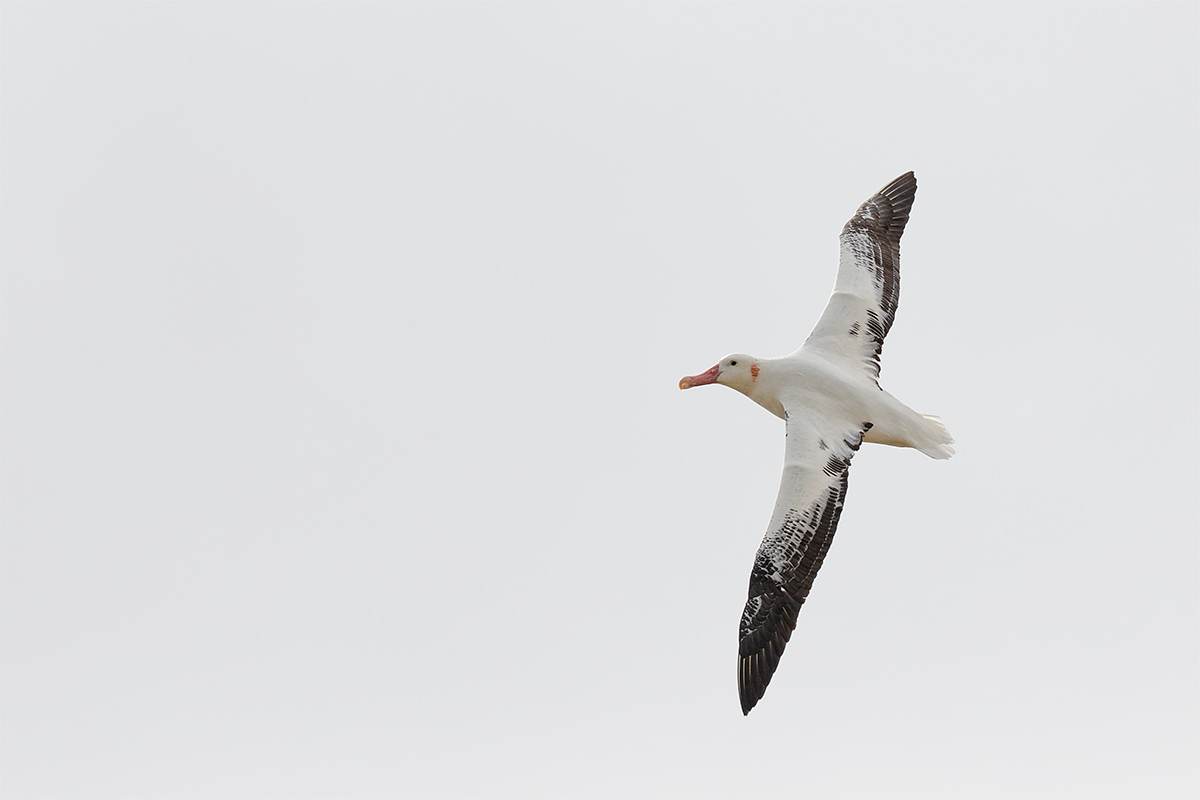
|
|
This image was created on Prion Island, South Georgia, with the hand held Canon EF 100-400mm f/4.5-5.6L IS II USM lens (at 400mm) and the rather amazing Canon EOS 7D Mark II. ISO 400. Evaluative metering +2 1/3rd stops off the bright grey sky: 1/2500 sec. at f/5.6. AWB.
Center AF point (Manual selection/AI Servo/Shutter Button AF as originally framed was active at the moment of exposure (as is always best when hand holding). Click on the image to see a larger version.
Image #2: Wandering Albatross adult banking in flight
|
My Thinking…
I was so tired after our morning on Salisbury with the King Penguins that I nearly fell asleep at lunch. In addition, it was blue sky sunny. I asked expedition leader Ted Cheeseman if it would be OK for denise and me to switch to the 2nd tier of landings. He said that it would be fine as long as I found two folks from decks 3 & 4 to switch with us. The first two folks whom I asked were more than glad to do so. I advised others in the BAA group to switch to the 2nd landing wave as well in hopes of getting some cloud cover later in the day. The later in the day the better….
The final piece to the puzzle was realizing that being in the last zodiac to shore would likely put us in the smallest group of the day. All afternoon I kept telling denise that we needed to be on the last zodiac. I had a premonition that doing so would provide a magical end to the expedition….
As a plus, our leader turned out to be my good friend, expedition staff member Joe Kaplan, a knowledgeable and expert birder. After a nap we took our time getting to the gangway and took the last zodiac to the Prion Island landing.
When we arrived the sky conditions were perfect: cloudy bright. And then up the hill we went.
|
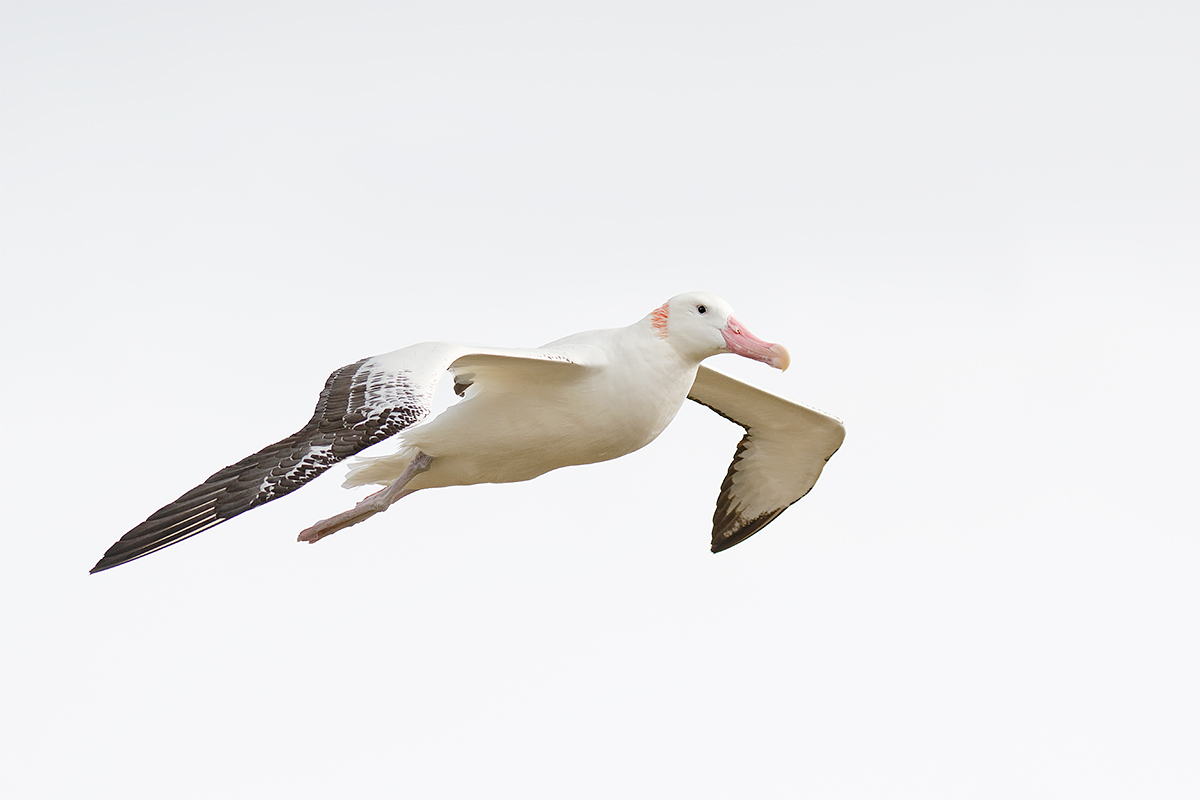
|
|
This image was created on Prion Island, South Georgia, with the hand held Canon EF 100-400mm f/4.5-5.6L IS II USM lens (at 148mm) and the rather amazing Canon EOS 7D Mark II. ISO 400. Evaluative metering +2 stops off the grey sky: 1/1600 sec. at f/5.6. AWB.
Center AF point (Manual selection/AI Servo/Shutter Button AF as originally framed was active at the moment of exposure (as is always best when hand holding). Click on the image to see a larger version.
Image #3: Wandering Albatross adult in flight
|
So How Did That Work Out?
There is a small observation deck below the main viewing platform. You usually get to stand there doing nothing for 30 minutes as you wait for the group ahead of you to pass you on the way down. We were not there a full minute when denise and I spotted the head of a fledgling albatross atop the ridge line. Then, the bird stood up and began flapping, testing and strengthening its wings. With both the wind and the light behind us, we were all hoping that we would witness the young bird’s first flight. It flapped and flapped and flapped, then rested for a minute and flapped and flapped and flapped. I created about 300 images of the young flapping Wandering Albatross. Image #1 was my favorite of the 44 that I kept.
Though the bird never took flight we were off to an amazing start. We learned later that though others saw this particular bird it is never flapped once as it stayed low in the grasses.
|
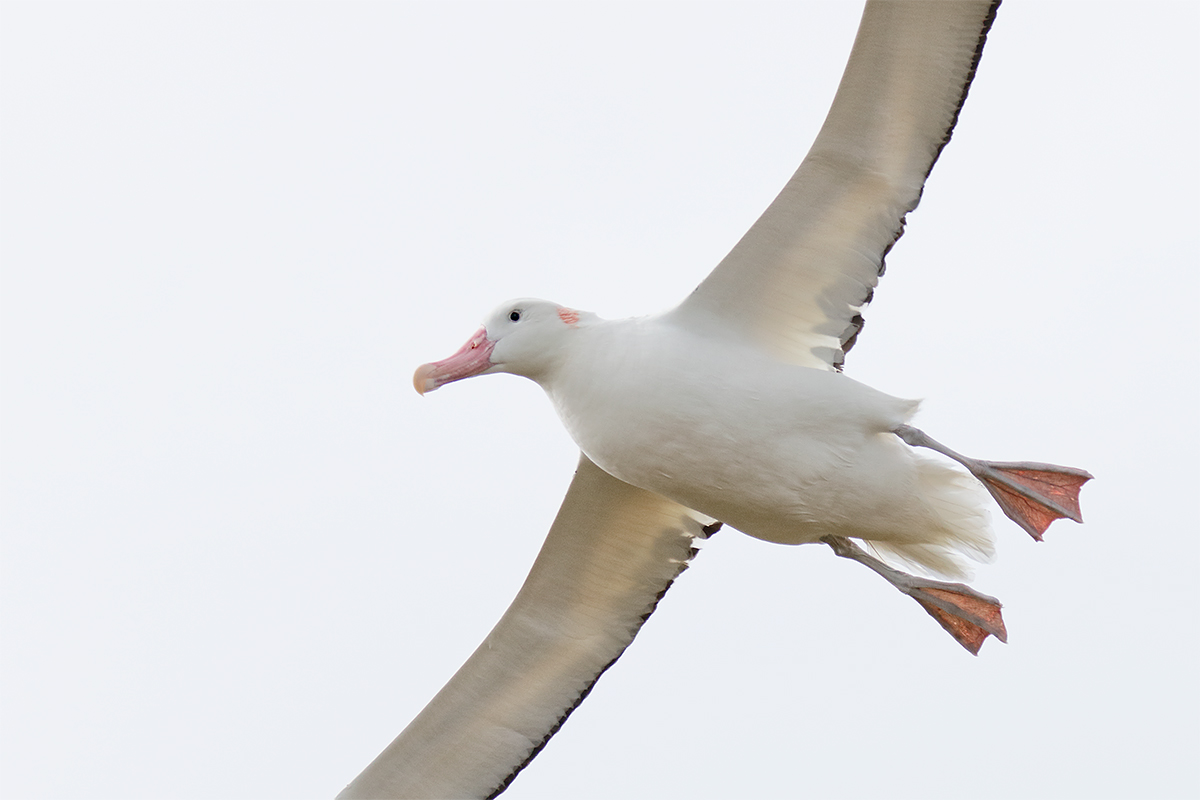
|
|
This image was created on Prion Island, South Georgia, with the hand held Canon EF 100-400mm f/4.5-5.6L IS II USM lens (at 371mm) and the rather amazing Canon EOS 7D Mark II. ISO 400. Evaluative metering +2 stops off the grey sky: 1/1600 sec. at f/5.6. AWB.
Center AF point (Manual selection/AI Servo/Shutter Button AF as originally framed was active at the moment of exposure (as is always best when hand holding). Click on the image to see a larger version.
Image #4: Wandering Albatross adult/tight flight
|
Could It Be?
On the way up the hill, I asked Joe Kaplan, “Has anyone seen a flying adult today?” He said, “No. The adults spend much of their time at sea fishing usually returning to feed the young only every week or two. The last time we saw an adult fly in was in 2009.” Fat chance I thought….
“Boy, that next to last group is sure taking a long time up there,” someone mentioned. Right after that, Dave Shoch, the other premier birding staff member, radioed Joe that there was an adult wanderer flying in from over the ocean. Joe alerted everyone in the group just before a stunning adult male Wanderer flew circles right above us for five minutes until it landed at its nest just below us. I was so excited that my rig was shaking in my hands–images 2, 3, & 4. When the bird finally landed at the nest I turned my attention back to the flapping chick on the ridge. Denise in the meantime created a remarkable image of the large chick in the nest begging food from the returning adult.
The bright orange marking on the back of the head shows that this bird is a very old male.
|
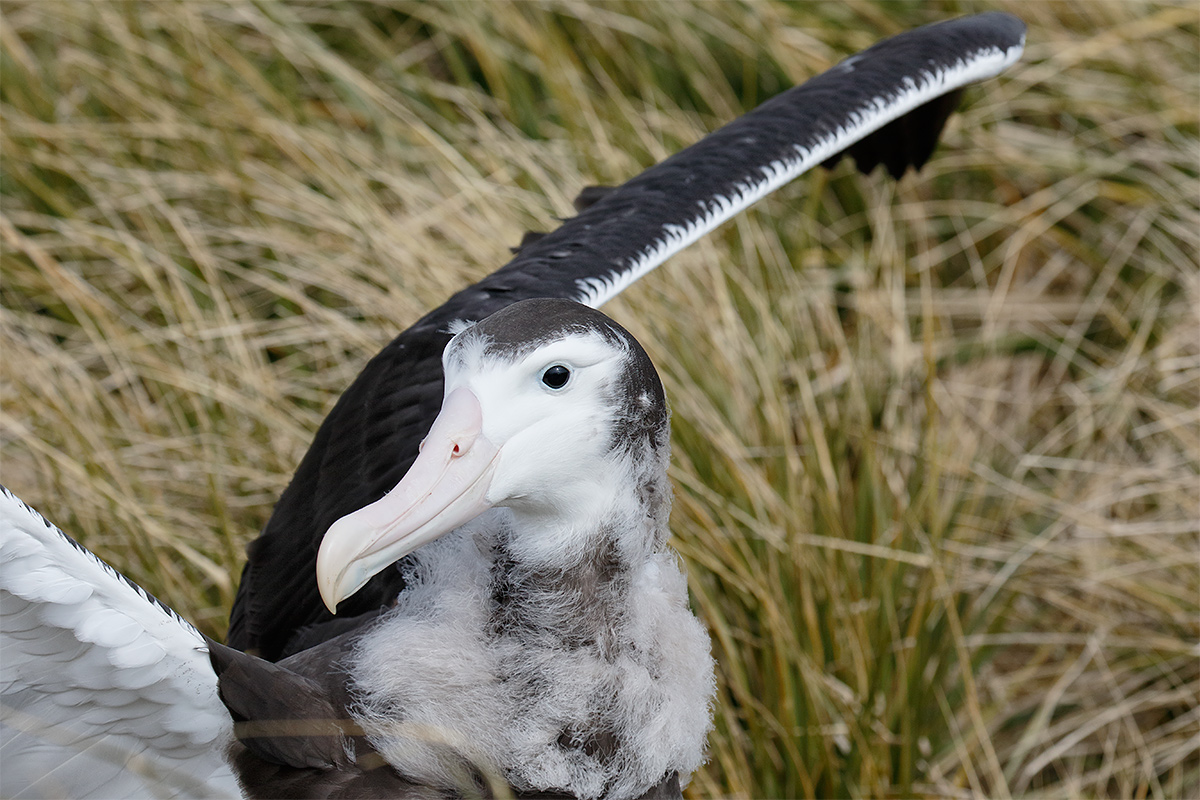
|
|
This image was created on Prion Island, South Georgia, with the hand held Canon EF 100-400mm f/4.5-5.6L IS II USM lens (at 241mm) and the rather amazing Canon EOS 7D Mark II. ISO 400. Evaluative metering +1/3 stop as framed: 1/1000 sec. at f/8. AWB.
Center AF point/Surround/AI Servo Rear Focus as framed was active at the moment of exposure (as is always best when hand holding). Click here to see the latest version of the Rear Focus Tutorial. Click on the image to see a larger version.
best when hand holding). Click on the image to see a larger version.
Image #5: Wandering Albatross flapping fledgling looking back
|
The Grand Finale
The young bird got fed and the bird on the ridge quit flapping just as we were summoned to the main observation platform 50 meters above us. As we arrived we noted that there was a fledgling albatross about 2 meters from the boardwalk somewhat hidden in the deep tussock grass. Immediately the bird stood up, posed for head portraits, and began flapping in place. Then it walked about a bit, posed for more head portraits, and flapped and flapped and flapped (images #5 & 6). As our time was up, it sat back down in the grass.
What better way to put the finishing touches on an incredible 3-week journey than with a magical fairy tale ending?
Technique Question
What did I need to remember to do on the lens after the flight session was over?
|
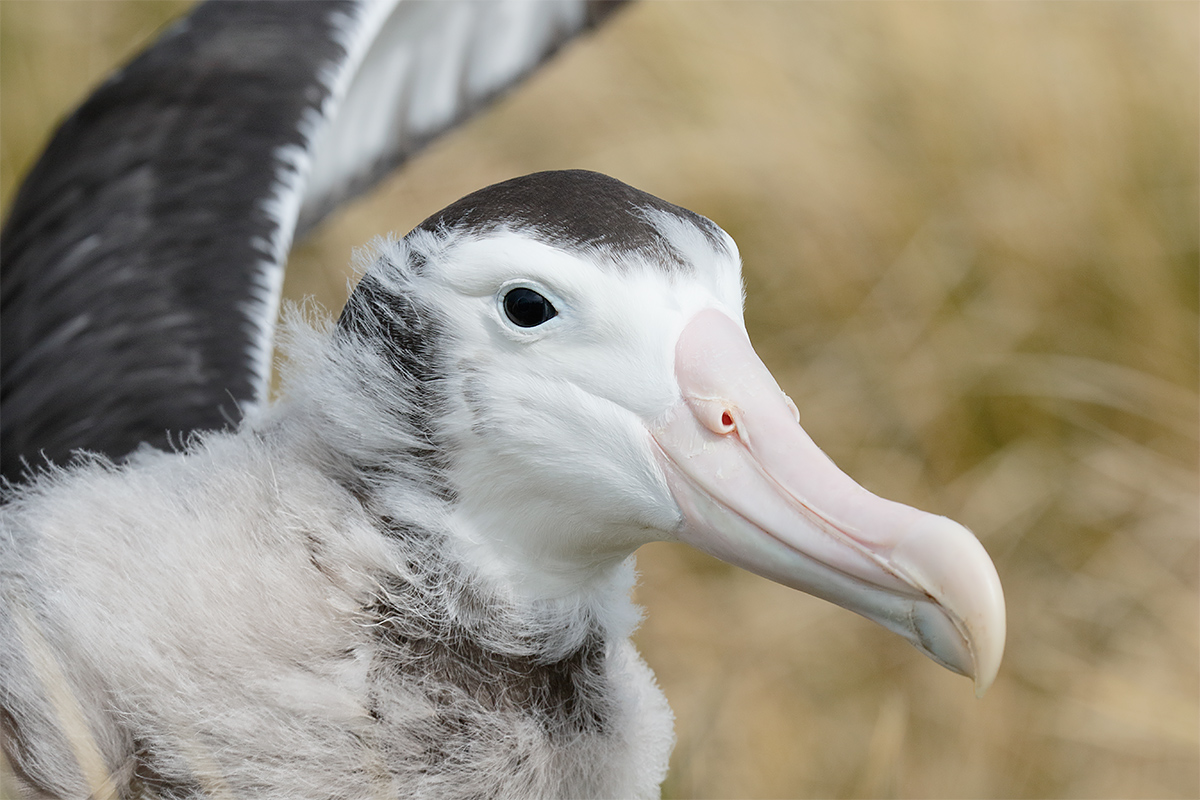
|
|
This image was created on Prion Island, South Georgia, with the hand held Canon EF 100-400mm f/4.5-5.6L IS II USM lens (at 330mm) and the rather amazing Canon EOS 7D Mark II. ISO 400. Evaluative metering +1/3 stop as framed: 1/1000 sec. at f/8. AWB.
Center AF point/Surround/AI Servo Rear Focus as framed was active at the moment of exposure (as is always best when hand holding). Click here to see the latest version of the Rear Focus Tutorial. Click on the image to see a larger version.
best when hand holding). Click on the image to see a larger version.
Image #6: Wandering Albatross fledgling tight head portrait/ flapping
|
Still More Canon 100-400mm IS II/7D II Versatility…
Do consider that all of the images in today’s blog post were created with the 100-400II/7D II combination. All hand held. As the trip progressed I began relying on this rig for nearly all of my Southern Ocean photography because of its light weight and amazing versatility. And of course, the tame birds and mammals.
Your Favorite Image?
Please let us know which of today’s six featured images is your favorite and why you made your choice.
The Bosque Site Guide
If you can’t make or afford one of the two Bosque IPTs, be sure to get yourself a copy of our Bosque Site Guide. All BAA Site Guides are designed so that with a bit of study you can show up at a great place and know exactly where to be at what time on what wind and in what lighting conditions. And on what wind. With a Site Guide on your laptop you will feel like a 22-year veteran on your first visit. Site Guides are the next best thing to being on an IPT. If you plan on visiting Bosque it would be foolish to make the trip without having this guide in hand. Why spend money on gear and travel and then spend days stumbling around in the wrong spot? If you have visited previously, and are still unsure of where you should be at this time of day with that wind, this guide will prove invaluable to you as well. Even folks visiting Bosque for the tenth time will learn a ton as I share my secrets and hold nothing back….
|

|
|
Bosque has been one of artie’s three soul places since he created two BBC-honored images there on his first visit in 1994.
|
Bosque del Apache 2015 BIRDS AS ART/A Creative Adventure Instructional Photo-Tour (IPT). 3-FULL DAY IPT: NOV 22-24, 2015. $1149. Two great leaders: Denise Ippolito and Arthur Morris. Meet and greet and introductory slide program after dinner on your own at 7:00pm on SAT NOV 21.
Sold Out with a waiting list.
In 2015, we are offering a 3-DAY IPT before Thanksgiving and a 4-DAY IPT after the holiday. The first has been sold out for a while. There is some room on the second. See below for details.
We know that there are lots of less costly workshops being offered these days. Many of them are downright cheap. Please remember that you get exactly what you pay for. With us you will have two full time pros there for you every minute we are in the field. Together they have more than 28 seasons of experience at the refuge. If you want the finest in photographic instruction and want to be assured of being in the right spot at exactly the right time every day, do join us.
|

|
|
Bosque is a wondrous place.
|
Bosque del Apache 2015 BIRDS AS ART/A Creative Adventure Instructional Photo-Tour (IPT). 4-DAY IPT: (three full and two 1/2 DAYS) NOV 28-DEC 2, 2015. $1499. Two great leaders: Denise Ippolito and Arthur Morris. Meet and greet at 3pm on SAT NOV 28 followed by an afternoon photo session at the crane pools and the introductory slide program after dinner on your own.
Just 3 spots left.
Tens of thousands of Snow Geese, 10,000 Sandhill Cranes, ducks, amazing sunrises, sunsets, and blast-offs. Live, eat, and breathe photography with two of the world’s premier photographic educators at one of their very favorite photography locations on the planet. Top-notch in-the-field and Photoshop instruction. This will make 21 consecutive Novembers at Bosque for artie. This will be denise’s 7th workshop at the refuge. Nobody knows the place better than artie does. Join us to learn to think like a pro, to recognize situations and to anticipate them based on the weather, especially the sky conditions, the light, and the wind direction. Every time we make a move we will let you know why. When you head home being able to apply what you’ve learned on your home turf will prove to be invaluable.
This workshop includes 4 afternoon (11/28through 12/1), 4 morning (11/29 to 12/2) photography sessions, an inspirational introductory slide program after dinner on your own on Saturday, 11/28, all lunches, and after-lunch digital workflow, Photoshop, and image critiquing sessions.
There is never a strict itinerary on a Bosque IPT as each day is tailored to the local conditions at the time and to the weather. We are totally flexible in order to maximize both the photographic and learning opportunities. We are up early each day leaving the hotel by 5:30 am to be in position for sunrise. We usually photograph until about 10:30am. Then it is back to Socorro for lunch and then a classroom session with the group most days. We head back to the refuge at about 3:30pm each day and photograph until sunset. We will be photographing lots of Snow Geese and lots of Sandhill Cranes with the emphasis on expanding both your technical skills and your creativity.
A $599 non-refundable deposit is required to hold your slot for this IPT. Your balance, payable only by check, will be due on 7/25/2015. If you cancel and the trip fills, we will be glad to apply a credit applicable to a future IPT for the full amount less a $100 processing fee. If we do not receive your check for the balance on or before the due date we will try to fill your spot from the waiting list. Whether or not your spot is filled, you will lose your deposit. If not, you can secure your spot by paying your balance.
Please print, complete, and sign the form that is linked to here and shoot it to us along with your deposit check (made out to “Arthur Morris.”) You can also leave your deposit with a credit card by calling the office at 863-692-0906. If you register by phone, please print, complete and sign the form as noted above and either mail it to us or e-mail the scan. If you have any questions, please feel free to contact me via e-mail after July 29.
Facebook
Be sure to like and follow BAA on Facebook by clicking on the logo link upper right. Tanks a stack!


Support the BAA Blog. Support the BAA Bulletins: Shop B&H here!
We want and need to keep providing you with the latest free information, photography and Photoshop lessons, and all manner of related information. Show your appreciation by making your purchases immediately after clicking on any of our B&H or Amazon Affiliate links in this blog post. Remember, B&H ain’t just photography!
Amazon.com
Those who prefer to support BAA by shopping with Amazon may click on the logo-link immediately above.
Amazon Canada
Many kind folks from north of the border, eh, have e-mailed stating that they would love to help us out by using one of our affiliate links but that living in Canada and doing so presents numerous problems. Now, they can help us out by using our Amazon Canada affiliate link by starting their searches by clicking here. Many thanks to those who have written.
Typos
In all blog posts and Bulletins, feel free to e-mail or to leave a comment regarding any typos or errors. Just be right :).
November 13th, 2015 What’s Down
I typed this blog post at 1pm on Thursday, October 29, 2015 on Saunders Island where we—denise, and Billie and Brian Snell–were staying in the cabin at the Rookery . It is rather nice, a lot less rustic than we were expecting. It is only a five-minute walk to the first Cliffside albatross nest and about a half hour to the Rockhopper Penguin colony. There is lots of great photography along the penguin highway. From there, it is an easy five-minute climb down to the famed rockhopper shower.
We are scheduled to fly back to Stanley on Friday October 30, do a morning van trip to the Kidney Point Rockhopper colony on Saturday, and then board the Ortelius for our Cheeseman’s South Georgia Expedition early on Saturday evening.
While traveling in the Southern Ocean I will be 100% without internet from 1-14 NOV. Jim will be in the office doing his usual stellar job of minding the store and Jen will be here to help with with all things IPT related. You can reach either of them by phone at 863-693-0906. You can reach Jim by e-mail or Jen at e-mail (the latter with Attn. JEN in the Subject line).
Please refrain from e-mailing me from 23 OCT through 15 NOV. Fat chance on that. 🙂
The BIRDS AS ART Blog and You
To show your appreciation for my efforts here, we do ask that you use our the B&H and Amazon affiliate links on the right side of the blog for all of your purchases. Doing so won’t cost you a penny and is the best way to thank me for the 15-20 hours I put in to bring you fresh and free educational material most every day. Please check the availability of all photographic accessories in the BIRDS AS ART Online Store. We sell only what I use and depend on. We will not sell you junk. We know what you need to make creating great images easy and fun. And we are always glad to answer your gear questions via e-mail (unless I am traveling without internet!)
You can find the following items in the store: Mongoose M3.6 and Wimberley heads, plates, low feet, and accessories, flash brackets, , Delkin e-film Pro Compact Flash Cards, LensCoat products, and our unique line-up of educational materials including ABP I & II, Digital Basics, Site and Set-up e-Guides, Canon and Nikon Camera Users and AF e-Guides, and MP-4 Photoshop video tutorials among others.
And we still have a few Gitzo tripods in stock. I imagine that we will be phasing those out soon….
I would of course appreciate your using our B&H affiliate links for all of your major gear, video, and electronic purchases. For the photographic stuff mentioned in the paragraph above we, meaning BAA, would of course greatly appreciate your business. Here is a huge thank you to the many who have been using our links on a regular basis and visiting the BAA Online store as well.
Selling Your Used Photo Gear Through BIRDS AS ART
Selling your used (or like-new) photo gear through the BAA Blog or via a BAA Online Bulletin is a great idea. We charge only a 5% commission. One of the more popular used gear for sale sites charges a minimum of 20%. Plus assorted fees! Yikes. The minimum item price here is $500 (or less for a $25 fee). If you are interested please e-mail with the words Items for Sale Info Request cut and pasted into the Subject line :). Stuff that is priced fairly–I offer free pricing advice, usually sells in no time flat. In the past few months, we have sold just about everything in sight. Do know that prices on some items like the EOS-1D Mark IV, the old Canon 500mm, the EOS-7D, and the original 400mm IS DO lens have been dropping steadily.
You can see the complete listings by clicking here or always by clicking on the Used Photo Gear tab on the right end of the navigation bar at the top of each blog post page.
|
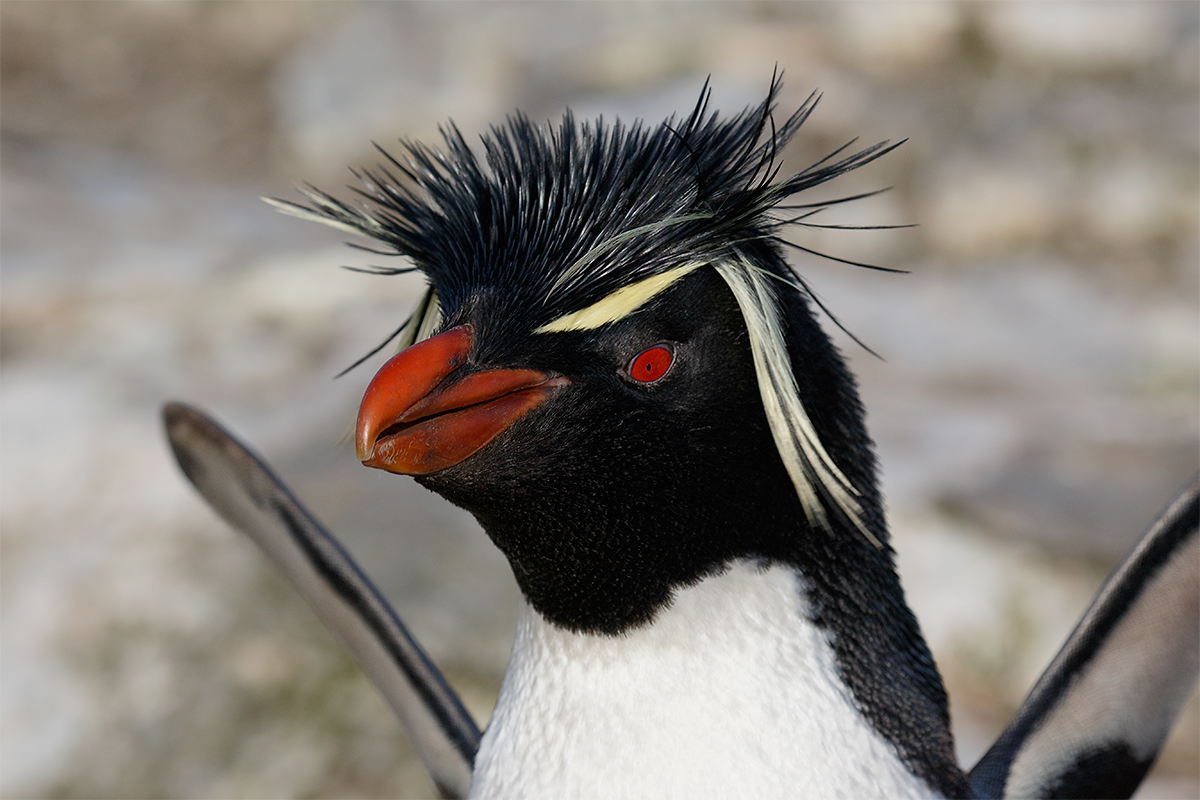
|
|
This image was created on Bleaker Island, the Falklands, with the hand held Canon EF 100-400mm f/4.5-5.6L IS II USM lens (at 220mm)and the amazing Canon EOS 7D Mark II. ISO 400. Evaluative metering -1/3 stop: 1/1000 sec. at f/9.
Two AF points to the left of the center AF point/AI Servo Expand/Rear Focus AF as framed was active at the moment of exposure (as is always best when hand holding). The active sensor fell on the middle of the bird’s bill. Click here to see the latest version of the Rear Focus Tutorial. Click on the image to see a larger version.
Rockhopper Penguin flapping in place
|
When the Light is Bright: Think Tight and Get Right on Sun Angle
When the light is bright: think tight and get right on sun angle. And that advice goes double when you are working with black and white birds. You are of course welcome to disregard the advice above by using a wide angle lens and employing side light. When you get a really good one, be sure to shoot it to me via e-mail it to me.
As for exposure, you will want to push the WHITEs to the right to the point where you have a smattering of blinkies that can almost always be recovered during the RAW conversion. Why? To maximize detail in the BLACKs. You are actually viewing the embedded JPEG on the rear LCD.
And yes, this is true for all mid-level and high-end digital cameras of all brands. As JPEGs are always more contrasty than the corresponding RAW files, it means that you have that much more latitude when pushing the exposure to the right.
Facebook
Be sure to like and follow BAA on Facebook by clicking on the logo link upper right. Tanks a stack!


Support the BAA Blog. Support the BAA Bulletins: Shop B&H here!
We want and need to keep providing you with the latest free information, photography and Photoshop lessons, and all manner of related information. Show your appreciation by making your purchases immediately after clicking on any of our B&H or Amazon Affiliate links in this blog post. Remember, B&H ain’t just photography!
Amazon.com
Those who prefer to support BAA by shopping with Amazon may click on the logo-link immediately above.
Amazon Canada
Many kind folks from north of the border, eh, have e-mailed stating that they would love to help us out by using one of our affiliate links but that living in Canada and doing so presents numerous problems. Now, they can help us out by using our Amazon Canada affiliate link by starting their searches by clicking here. Many thanks to those who have written.
Typos
In all blog posts and Bulletins, feel free to e-mail or to leave a comment regarding any typos or errors. Just be right :).
November 12th, 2015 What’s Down?
I typed this blog post on the early morning of Tuesday, October 27, 2015 as the rest of the gang sleeps. We are supposed to fly via small plane this morning from Bleaker Island to Saunders Island. Yesterday we dealt quite successfully with steady north winds of 25 knots with gusts to 30. It sounds quit windy in the pre-dawn blackness so we shall see what develops. Our stay on Bleaker has been great. We have concentrated mainly on King Cormorant and Rockhopper and Gentoo Penguins. More on those at some point. After Saunders we fly back to Stanley, capitol of the Falklands, for a day trip to a rockhopper colony on Saturday. If all goes as planned, we will board the Ortelius for our Cheesemans’ South Georgia expedition that evening.
I hope to get on line in Stanley so that this and several other new blog posts might be published from the cloud during my time aboard ship.
While traveling in the Southern Ocean I will be 100% without internet from 24-30 OCT and then again from 1-14 NOV. Jim will be in the office doing his usually stellar job of minding the store and Jen will be here to help with with all things IPT related. You can reach either of them by phone at 863-693-0906. You can reach Jim by e-mail or Jen at e-mail (the latter with Attn. JEN in the Subject line).
Please refrain from e-mailing me from 23 OCT through 15 NOV. Fat chance on that. 🙂
The BIRDS AS ART Blog and You
To show your appreciation for my efforts here, we do ask that you use our the B&H and Amazon affiliate links on the right side of the blog for all of your purchases. Doing so won’t cost you a penny and is the best way to thank me for the 15-20 hours I put in to bring you fresh and free educational material most every day. Please check the availability of all photographic accessories in the BIRDS AS ART Online Store. We sell only what I use and depend on. We will not sell you junk. We know what you need to make creating great images easy and fun. And we are always glad to answer your gear questions via e-mail (unless I am traveling without internet!)
You can find the following items in the store: Mongoose M3.6 and Wimberley heads, plates, low feet, and accessories, flash brackets, , Delkin e-film Pro Compact Flash Cards, LensCoat products, and our unique line-up of educational materials including ABP I & II, Digital Basics, Site and Set-up e-Guides, Canon and Nikon Camera Users and AF e-Guides, and MP-4 Photoshop video tutorials among others.
And we still have a few Gitzo tripods in stock. I imagine that we will be phasing those out soon….
I would of course appreciate your using our B&H affiliate links for all of your major gear, video, and electronic purchases. For the photographic stuff mentioned in the paragraph above we, meaning BAA, would of course greatly appreciate your business. Here is a huge thank you to the many who have been using our links on a regular basis and visiting the BAA Online store as well.
Selling Your Used Photo Gear Through BIRDS AS ART
Selling your used (or like-new) photo gear through the BAA Blog or via a BAA Online Bulletin is a great idea. We charge only a 5% commission. One of the more popular used gear for sale sites charges a minimum of 20%. Plus assorted fees! Yikes. The minimum item price here is $500 (or less for a $25 fee). If you are interested please e-mail with the words Items for Sale Info Request cut and pasted into the Subject line :). Stuff that is priced fairly–I offer free pricing advice, usually sells in no time flat. In the past few months, we have sold just about everything in sight. Do know that prices on some items like the EOS-1D Mark IV, the old Canon 500mm, the EOS-7D, and the original 400mm IS DO lens have been dropping steadily.
You can see the complete listings by clicking here or always by clicking on the Used Photo Gear tab on the right end of the navigation bar at the top of each blog post page.
After a lull in September, things have really heated up lately:
Alan Walther sold his 500mm f/4L IS for $3900 in mid-October.
IPT veteran Larry Master sold his 300mm f/2.8L IS II lens for $4750 on October 22, 2015.
Canon 500mm f/4L IS (the “old five”) was sold by Glen Shellhammer for $4250 in mid-October, 2015.
Canon EF 300mm f/2.8L IS II USM lens was sold instantly by Walt Anderson for $4750 in mid-October, 2015.
Canon EF 500mm f/4L IS USM lens (the “old five”) was sold by Dane Johnson for $4150 in early October 2015.
Sigma 300-800mm f/5.6 zoom lens (Canon mount) was sold by Beth Starr for $4,999 in early October 2015.
Canon EOS-1D X in excellent condition was sold by Patrick Sparkman for $3650 in early October, 2014.
Canon EF 100-400 f 4.5-5.6 L IS USM lens was sold for $699 by Sean Traynor on October 7, 2015.
Canon 100-400 L IS zoom lens (the old 1-4) was sold by Susan Carnahan for $675 in mid-October, 2015.
You can find the complete listings here.
|
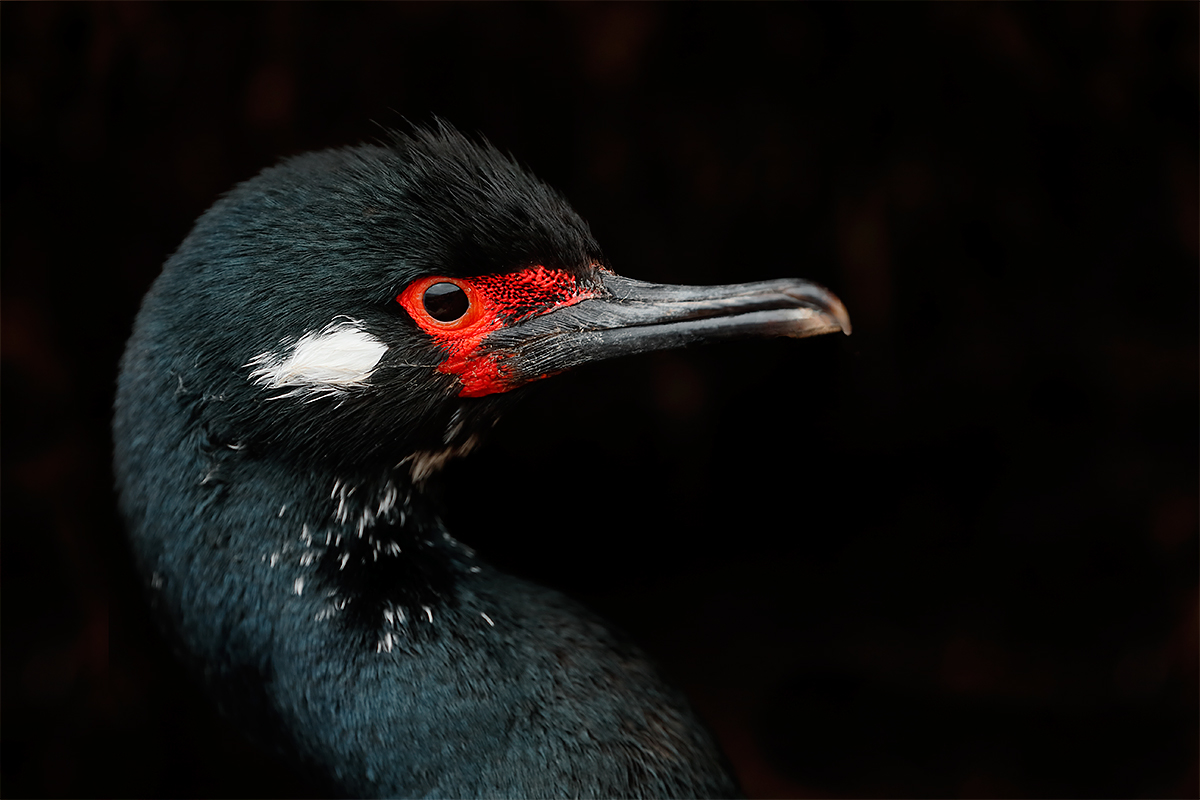
|
|
This image was created on Bleaker Island, on our first-ever land-based Falklands tour, with the Induro tripod/Mongoose M3.6 -mounted Canon EF 400mm f/4 DO IS II USM lens, the Canon Extender EF 1.4X III, and the rugged professional body, the Canon EOS-1D X. ISO 640. Evaluative metering -2 1/3 stops: 1/200 sec. at f/6.3 in Manual mode. Cloudy WB.
One AF point above and two to the left of the center AF point/AI Servo Expand/Rear Focus AF as framed was active at the moment of exposure. Click here to see the latest version of the Rear Focus Tutorial. Click on the image to see a larger version. Click here to see the latest version of the Rear Focus Tutorial. Click on the image to see a larger version.
Rock Shag head portrait
|
Only a Dream: Rock Shag Heaven…
I had photographed Rock Shag (Phalacrocorax magellanicus)on several visits to various Falkland Islands, always from a great distance, and always in horrific light. On Monday morning, October 27, 2015 we had discovered a nice cliff with about 30 breeding pairs, but as always, the birds were a long ways away. Then, that same afternoon, a gift was shared with us: access to a breeding wall of this gorgeous species. When birds are seen only and typically from long range, one often views them as shy and secretive. The nesting Rock Shags that we encountered were tame and accepting of our presence, as long–of course, as we moved slowly among them.
We got to photograph them display and courting, and creating head portraits like today’s featured image was a snap, even for those with “only” 400mm of reach. For me, it was a thrill of a lifetime; creating a variety of quality images of a beautiful new species. Even though I had seen this species before, I think of it as “new” in the sense that I was able to add quality images to the BIRDS AS ART collection.
Exposure Question
Why -2 1/3 stops EC?
My new long lens
Again I scrambled to get my hands on a Canon EF 400mm DO II before a big trip. The one that I had intended to purchase from B&H had a problem right out of the box: the camera would lose electrical contact with the lens whenever a TC was in place. B&H accepted the return and was able to get me a perfect copy just before our big Southern Oceans trips. I used the lens a ton for flight, without a TC in low light situations both for flight and for portraits, with the 1.4X for a variety of purposes (including some flight photography), and often with the 2X III TC as my walk around 800mm lens. And almost always on our Falklands trip with the 1D X for two reasons: superb high ISO performance and enough battery power better to drive the AF motor especially with either TC in place. With the 2X TC, I did encounter AF problems (as expected) when the center AF point (by necessity at f/8), fell on a plain area of white or black, an area with zero contrast.
|
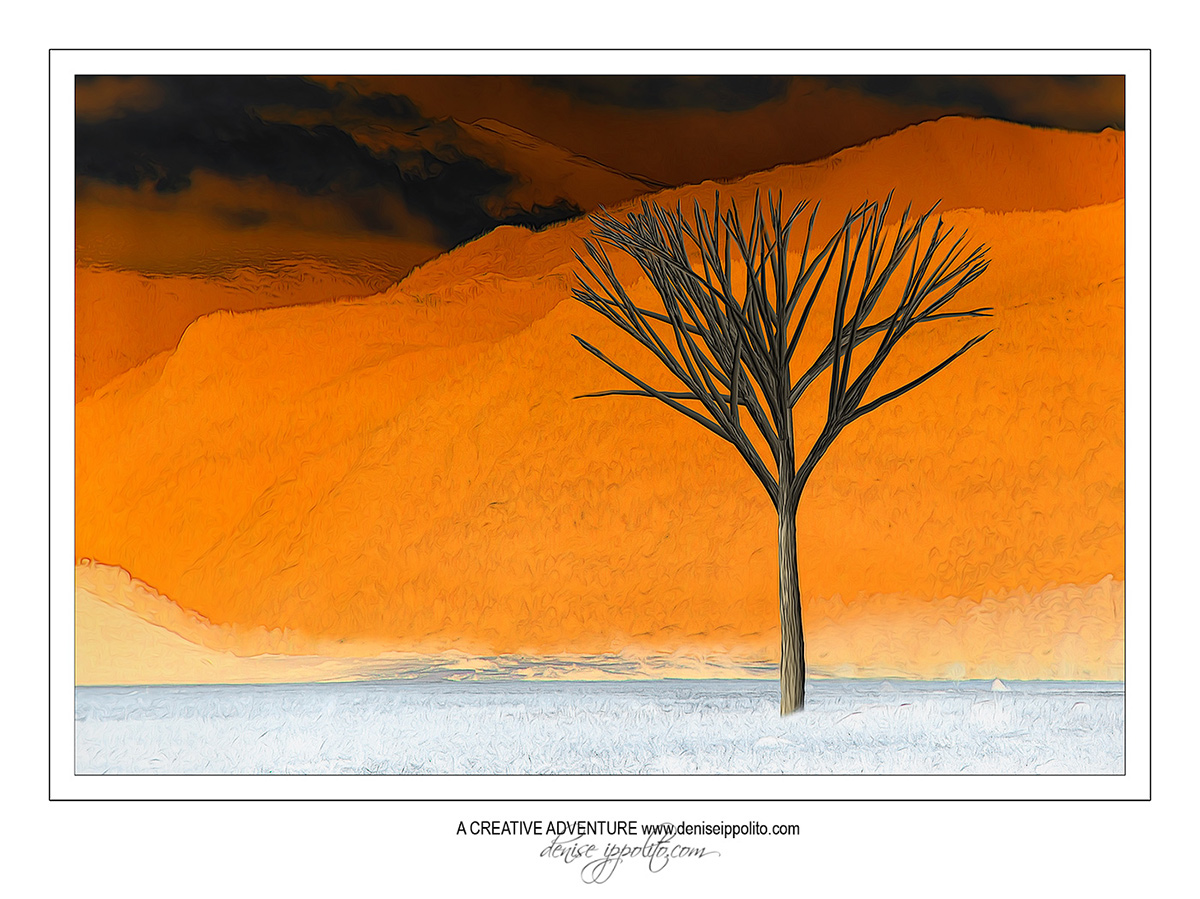
|
Deadvlei Tree photo illustration courtesy of and copyright 2015: Denise Ippolito/A Creative Adventure
Denise created this artwork by combining an image of some Colorado mountains with a tree that she created in Photoshop. The rest is simply her creative filter magic. It is a given that denise’s creativity is virtually unlimited and unmatched. Just don’t ask me how she did it….
|
Namibia
Photos of Namibian dunes, dead trees, birds, and wildlife often grace prestigious natural history calendars and are honored annually in pretty much all of the top flight nature photography contests including and especially the BBC Wildlife Photographer of the Year Competition and the Nature’s Best Windland Smith Rice International Awards Contest. Both denise and I have long dreamed of visiting. Our dream is coming true. With four folks signed up before the tour was even announced, this trip is a go. Most traveling from the US will likely want to be on one of the direct flights to Johannesburg, South Africa from New York’s JFK (on April 13, 2015 so as to arrive in Windhoek on the 14th). In addition, we would both be thrilled to meet some of our overseas followers on this trip.
In addition to enjoying several world class nature photography locations, you will learn more than you ever thought possible via in-the-field instruction from two of the best and informal image sharing and Photoshop sessions at the lodge. We hope that you can join us.
The 2016 Namibia BIRDS AS ART/A Creative Adventure Instructional Photo-Safari: April 14-28, 2016 on the ground: $8999. Limit: 10 photographers/openings: 6.
Our truly great itinerary is below. This workshop was planned with the help of two BBC-honored local photographers with an intimate knowledge of the area who will act as our guides for the entire trip. This IPT will be co-led by Denise Ippolito and yours truly. The dates and the price are set in stone: April 14-28, 2016. 15/days/14 nights: $8999 from Windhoek, Namibia (Hosea Kutako International Airport, airport code WDH). Please contact me via e-mail if you would like to register. Then please fill out, print, and sign the Registration and Release forms that are linked to here. Then mail it to us here: PO Box 7245, Indian Lake Estates FL 33855 along with your $3,000 non-refundable deposit check made out to “Arthur Morris.”
The second payment of $3,000 is due on November 15, 2015 and the final payment of $2,999 is due on February 1, 2016. As with the deposit, checks only.
Single supplements may be available for parts (or all) of the trip. They will be quite expensive. Best not to ask 🙂 Please inquire as to availability. If you or we are unable to line up a same sex roommate for you, you will be charged the single supplement on a pro-rated basis.
Travel Insurance
Please understand that we need the deposits for international trips as arrangements must be paid in full far in advance. If everybody decides to cancel then we are sort left holding a very short straw 🙂 Seriously interested folks are urged to consider getting trip insurance within two weeks of sending their deposit checks. There are lots of options with Travel Services Insurance (TSI). You can explore them here.
The Namibia IPT Itinerary
Day 1: April 14, 2016. Fly into Windhoek (Hosea Kutako International Airport, airport code WDH. Spend the night at River Crossing Lodge. Note: folks traveling from the US and many other destinations will need to depart on redeye flights on April 13th. You need to be sure that you will be in Windhoek on April 14, 2015!
Day 2: Early departure to QuiverTree Forest Lodge on the outskirts of Keetmanshoop. Here we will be able to capture the beauty of the magnificent QuiverTree forest as well as have access to the Giant Playground area for some spectacular landscape photography. The sessions will include afternoon and evening shoots, the latter with stars, milky way, and star trails photography. Night photography instruction will be provided. In addition, we will let you know in advance what lenses and accessories you will need for the night photography.
Day 3: After breakfast we depart for the luxurious Sossusvlei Dune Lodge for 3 nights inside Namib Naukluft National Park. The distance to Sossusvlei is about 550km and the trip should take about 7 hours. Thanks to our experienced guides we will enjoy unparalleled after hours access to dead tree scenics at Dead Vlei. Arrangements have been made to to leave the lodge in the mornings an hour before sunrise to capture the best possible lighting conditions. We will be visiting Dead Vlei and Dune 45. There is a fairly strenuous up-and-down hike to some of the best photo locations that should take really fit folks about 15-20 minutes and as much as 45 minutes for the older fit folks or those with a bad knee. Denise is in the former category, Artie fits in both of the latter categories :). At Sossusvlei two desert systems come together: the beautiful red dunes of the Kalahari desert and the breathtakingly stark Namib desert. The desert experience is a surreal and life-changing one and even the best images do not reflect the amazing beauty of these unique deserts. Deadvlei, with its ancient trees in the now dried up lake, is a feast for photographers who are looking for something stark, different, and dramatic. Along with the spectacular landscapes we should get to photograph some wildlife as well with chances for oryx and springbok among others.
Day 6: From Sossusvlei we head off to Swakopmund to spend some three nights at the Swakopmund Beach Hotel. One morning will head into the dunes to target species such as the Desert Chameleon, Horned Adder, Sand-Diving Lizards, and Palmato Gecko—the world’s cutest gecko. We will spend time photographing the amazing bird life in and around the Walvisbay area. The Salt Mine and bay area is especially productive with a huge selection of waders and other waterfowl along with large numbers of flamingoes. We will enjoy one chartered boat trip to target pelicans in flight. Those and a selections of skua’s and cormorants will keep the most discerning bird photographers happy. Afternoons in the area will be spent driving along the beach to the huge seal colonies and photographing their playful interactions and antics. A tentative schedule is below:
Day 7: Morning (private tour) Desert Experience photographing Palmato Gecko / Sidewinders / Desert Chameleon etc, etc. Afternoon we either shoot Pelican point for seals or Walvisbay for flamingos and more.
Day 8: Morning bay cruise with chartered boat shooting pelicans flying in . We will likely spend the afternoon with the seals at Pelican point.
Day 9: After breakfast we depart for Etosha; arrive that afternoon at Halali and spend 3 nights there. Just when you thought it could not get any better we head further north to the wide-open plains of Etosha. Here the wildlife spectacle is arguably one of the best in Africa. Etosha is home to not only the Big Five, but also a variety of other species such as Cheetah, Honey Badger, Oryx, Springbok, Dik-Dik, Black-Faced Impala, Eland, Ostrich and more. Depending on our route this could take as long as four hours to get to the park entrance and another 2 hours drive to Halali. We will travel about 400km
Day 12:. We wrap-up at Halali and move down to Okaukuejo where we will spend three nights. Okaukuejo Camp is famous for its large floodlit waterhole, the hub of animal activity especially in the early morning and early evening hours. We will see and photograph many species including and especially the endangered Black Rhino. There will be game drives during the say. For the night water hole photography flash is optional but recommended.
Day 15: April 28, 2016. We make the 4-5 hour drive back to Windhoek in time for your international flights.
This price of this tour includes:
All Accommodations.
All breakfasts and dinners.
Logistics make formal lunches impossible. There will, however, be a variety of snacks including nuts and cheeses along with sodas and bottled drinking water in each vehicle.
Bottled water at the lodges and in the vehicles. Also included at the lodges are soft drinks and sodas and local wines and liquors (excluding premium and imported hard drinks).
All transportation from the time you arrive in Windhoek to the time you leave again.
All park entrance fees
One extra-late night in Deadvlei where we will use NWR vehicles for transport.
The chartered boat activities in Walvisbay.
The Private Desert Experience tour in Swakopmund.
The price of this tour does not include:
Your flights to and from Windhoek.
Visa costs: no visa is needed for folks from the US and most other countries.
Gratuities and items of a personal nature.
Facebook
Be sure to like and follow BAA on Facebook by clicking on the logo link upper right. Tanks a stack!


Support the BAA Blog. Support the BAA Bulletins: Shop B&H here!
We want and need to keep providing you with the latest free information, photography and Photoshop lessons, and all manner of related information. Show your appreciation by making your purchases immediately after clicking on any of our B&H or Amazon Affiliate links in this blog post. Remember, B&H ain’t just photography!
Amazon.com
Those who prefer to support BAA by shopping with Amazon may click on the logo-link immediately above.
Amazon Canada
Many kind folks from north of the border, eh, have e-mailed stating that they would love to help us out by using one of our affiliate links but that living in Canada and doing so presents numerous problems. Now, they can help us out by using our Amazon Canada affiliate link by starting their searches by clicking here. Many thanks to those who have written.
Typos
In all blog posts and Bulletins, feel free to e-mail or to leave a comment regarding any typos or errors. Just be right :).
November 11th, 2015 What’s Down
I typed this blog post at 9am on Thursday, October 29, 2015 on Saunders Island where we—denise, and Billie and Brian Snell–are staying in the cabin at the Rookery. It is rather nice, a lot less rustic than we were expecting. It is only a five minute walk to the first Cliffside albatross nest and about a half hour to the Rockhopper Penguin colony. There is lots of great photography along the penguin highway. From there, it is an easy five minute climb down to the famed rockhopper shower.
We are scheduled to fly back to Stanley on Friday October 30, do a morning van trip to the Kidney Point Rockhopper colony on Saturday, and then board the Ortelius for our Cheeseman’s South Georgia Expedition early on Saturday evening.
While traveling in the Southern Ocean I will be 100% without internet from 1-14 NOV. Jim will be in the office doing his usually stellar job of minding the store and Jen will be here to help with with all things IPT related. You can reach either of them by phone at 863-693-0906. You can reach Jim by e-mail or Jen at e-mail (the latter with Attn. JEN in the Subject line).
Please refrain from e-mailing me from 23 OCT through 15 NOV. Fat chance on that. 🙂
The BIRDS AS ART Blog and You
To show your appreciation for my efforts here, we do ask that you use our the B&H and Amazon affiliate links on the right side of the blog for all of your purchases. Doing so won’t cost you a penny and is the best way to thank me for the 15-20 hours I put in to bring you fresh and free educational material most every day. Please check the availability of all photographic accessories in the BIRDS AS ART Online Store. We sell only what I use and depend on. We will not sell you junk. We know what you need to make creating great images easy and fun. And we are always glad to answer your gear questions via e-mail (unless I am traveling without internet!)
You can find the following items in the store: Mongoose M3.6 and Wimberley heads, plates, low feet, and accessories, flash brackets, , Delkin e-film Pro Compact Flash Cards, LensCoat products, and our unique line-up of educational materials including ABP I & II, Digital Basics, Site and Set-up e-Guides, Canon and Nikon Camera Users and AF e-Guides, and MP-4 Photoshop video tutorials among others.
And we still have a few Gitzo tripods in stock. I imagine that we will be phasing those out soon….
I would of course appreciate your using our B&H affiliate links for all of your major gear, video, and electronic purchases. For the photographic stuff mentioned in the paragraph above we, meaning BAA, would of course greatly appreciate your business. Here is a huge thank you to the many who have been using our links on a regular basis and visiting the BAA Online store as well.
Selling Your Used Photo Gear Through BIRDS AS ART
Selling your used (or like-new) photo gear through the BAA Blog or via a BAA Online Bulletin is a great idea. We charge only a 5% commission. One of the more popular used gear for sale sites charges a minimum of 20%. Plus assorted fees! Yikes. The minimum item price here is $500 (or less for a $25 fee). If you are interested please e-mail with the words Items for Sale Info Request cut and pasted into the Subject line :). Stuff that is priced fairly–I offer free pricing advice, usually sells in no time flat. In the past few months, we have sold just about everything in sight. Do know that prices on some items like the EOS-1D Mark IV, the old Canon 500mm, the EOS-7D, and the original 400mm IS DO lens have been dropping steadily.
You can see the complete listings by clicking here or always by clicking on the Used Photo Gear tab on the right end of the navigation bar at the top of each blog post page.
After a lull in September, things have really heated up lately:
Alan Walther sold his 500mm f/4L IS for $3900 in mid-October.
IPT veteran Larry Master sold his 300mm f/2.8L IS II lens for $4750 on October 22, 2015.
Canon 500mm f/4L IS (the “old five”) was sold by Glen Shellhammer for $4250 in mid-October, 2015.
Canon EF 300mm f/2.8L IS II USM lens was sold instantly by Walt Anderson for $4750 in mid-October, 2015.
Canon EF 500mm f/4L IS USM lens (the “old five”) was sold by Dane Johnson for $4150 in early October 2015.
Sigma 300-800mm f/5.6 zoom lens (Canon mount) was sold by Beth Starr for $4,999 in early October 2015.
Canon EOS-1D X in excellent condition was sold by Patrick Sparkman for $3650 in early October, 2014.
Canon EF 100-400 f 4.5-5.6 L IS USM lens was sold for $699 by Sean Traynor on October 7, 2015.
Canon 100-400 L IS zoom lens (the old 1-4) was sold by Susan Carnahan for $675 in mid-October, 2015.
You can find the complete listings here.
|
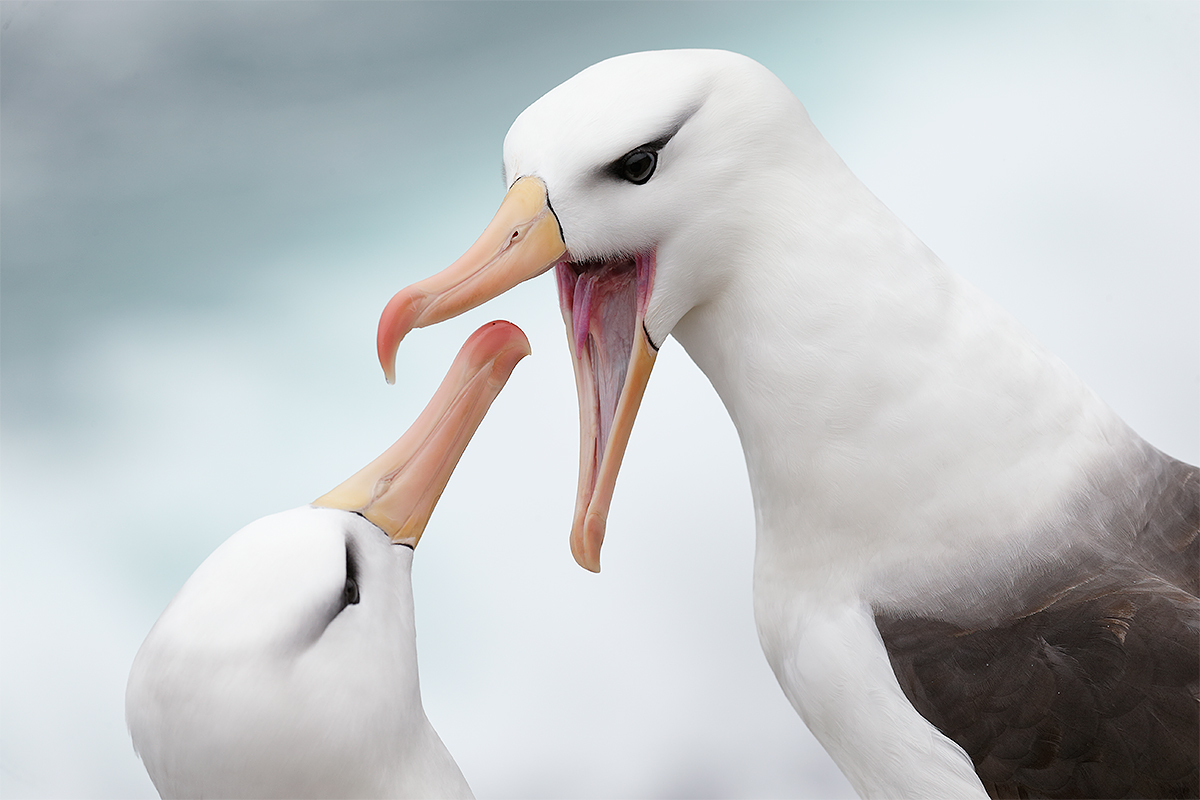
|
|
This image was created on Saunders Islands, The Falklands with the hand held Canon EF 100-400mm f/4.5-5.6L IS II USM lens (at 321mm) and the rugged and the rugged professional body, the Canon EOS-1D X. ISO 400. Evaluative metering +1 2/3 stops: 1/640 sec. at f/8. Left Zone/Shutter Button AF activated the AF point two to the right of the center AF point and was active at the moment of exposure (as is always best when hand holding).
Black-browed Albatross courtship display
|
How Do You Do?
The courtship displays of the various albatross species are distinctly different, intricately beautiful, and always fascinating. Several times on Saunders Island I actually thought about doing some video of the Black-browed Albatross courtship dance but never quite got there…
In today’s featured image the male on our right is doing the bill clack. At the end of a rapid series of these they will often hold the pose for just an instant. The female here was quite interested.
Getting Lucky with Zone AF…
With the 7D II, the 5D III, and the 1D X I will sometimes go to Zone AF when I have two horizontally oriented birds facing each other. It usually is surer than 61- or 65-Point Automatic Selection AF in these situations. I will move the active zone so that it falls on the closer bird. Here I got lucky as the active AF point that was selected by the system just caught the tip of the bill of the bird on our left. The female’s bill tip was on exactly the same plane as the eye of the displaying male; better to be lucky than good.

Induro Tripods and Ballheads
Click here for complete info on Induro tripods and to learn which one is the best fit for you. Or click here or on the logo-link above to purchase via our OPG affiliate link.
First Induro Kudos
Dennis Zaebst left this on the original Induro blog post:
Hi Artie,
I just received my new GIT 304L from OPG after using your link above. Thanks for the great tip!
I am a convert from an older Gitzo (model 1320, really old). I love all the features of the new 304L tripod and I’m really impressed with it. It’s a really precision piece of equipment. One of the best features, but perhaps not emphasized enough above, are the quick-release leg locks. Just a quarter turn and they are released, and equally quick to lock. This is compared to my old Gitzo, requiring more than a full turn, taking about twice as long to set up and use, or to put away. I was always a bit frustrated with the Gitzo as the legs required a fairly hard pull to extend or collapse, and this was a bit awkward to deal with. Not so with the 304L.
Best, Dennis
|

|
|
San Diego offers a wealth of very attractive natural history subjects. With annual visits spanning more than three decades I have lot of experience there….
|
2015 San Diego 4 1/2-DAY BIRDS AS ART Instructional Photo-Tour (IPT) JAN 8 thru the morning of JAN 12, 2016: $1899 (Limit: 10/Openings: 3)
Meet and Greet at 7:00pm on the day before the IPT begins
Two great leaders: Arthur Morris and Denise Ippolito
Join us in San Diego to photograph the spectacular breeding plumage Brown Pelicans with their fire-engine red and olive green bill pouches; Brandt’s and Double-crested Cormorants in breeding plumage with their amazing crests; breeding plumage Wood and Ring-necked Duck; other species possible including Lesser Scaup, Redhead, and Surf Scoter; a variety of gulls including Western, California, and the gorgeous Heerman’s, all in full breeding plumage; shorebirds including Marbled Godwit, Willet, Sanderling and Black-bellied Plover; many others possible including Least, Western, and Spotted Sandpiper, Whimbrel, Black and Ruddy Turnstone, Semipalmated Plover, and Surfbird; Harbor Seals (depending on the current regulations) and California Sea Lions likely; and Bird of Paradise flowers. And as you can see by studying the two IPT cards there are some nice landscape opportunities as well.
Did I mention that there are wealth of great birds and natural history subjects in San Diego in winter?
This IPT will include five 3 1/2 hour morning photo sessions, four 2 1/2 hour afternoon photo sessions, five lunches, after-lunch image review and Photoshop sessions, and a thank you dinner. To ensure early starts, breakfasts will be your responsibility.
A $499 non-refundable deposit is required to hold your slot for this IPT. You can send a check (made out to “Arthur Morris) to us at BIRDS AS ART, PO Box 7245, Indian Lake Estates, FL, 33855. Or call Jim or Jennifer at the office with a credit card at 863-692-0906. Your balance, payable only by check, will be due on 11/1//2015. If we do not receive your check for the balance on or before the due date we will try to fill your spot from the waiting list. Please print, complete, and sign the form that is linked to here and shoot it to us along with your deposit check. If you register by phone, please print, complete and sign the form as noted above and either mail it to us or e-mail the scan. If you have any questions, please feel free to contact me via e-mail.
|

|
|
Though the pelicans will be the stars of the show on this IPT there will be many other handsome and captivating subjects in wonderful settings.
|
Facebook
Be sure to like and follow BAA on Facebook by clicking on the logo link upper right. Tanks a stack!


Support the BAA Blog. Support the BAA Bulletins: Shop B&H here!
We want and need to keep providing you with the latest free information, photography and Photoshop lessons, and all manner of related information. Show your appreciation by making your purchases immediately after clicking on any of our B&H or Amazon Affiliate links in this blog post. Remember, B&H ain’t just photography!
Amazon.com
Those who prefer to support BAA by shopping with Amazon may click on the logo-link immediately above.
Amazon Canada
Many kind folks from north of the border, eh, have e-mailed stating that they would love to help us out by using one of our affiliate links but that living in Canada and doing so presents numerous problems. Now, they can help us out by using our Amazon Canada affiliate link by starting their searches by clicking here. Many thanks to those who have written.
Typos
In all blog posts and Bulletins, feel free to e-mail or to leave a comment regarding any typos or errors. Just be right :).
|
|











































